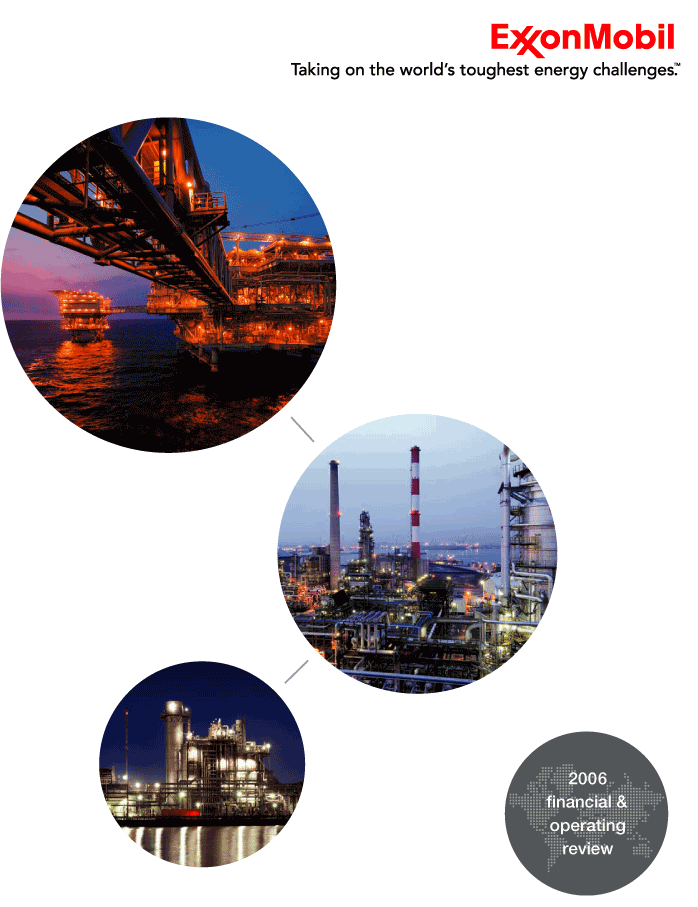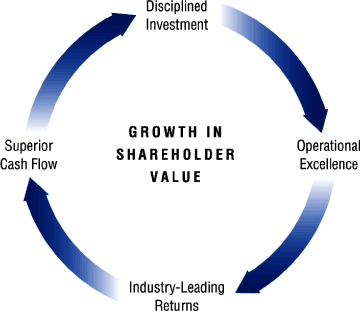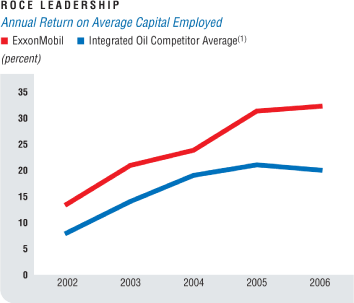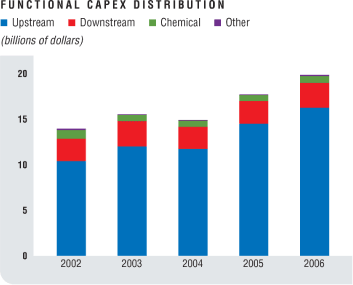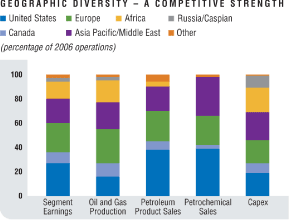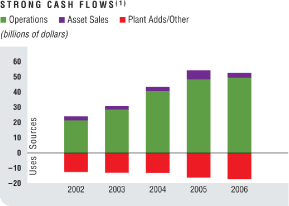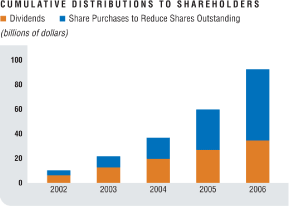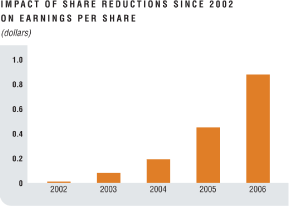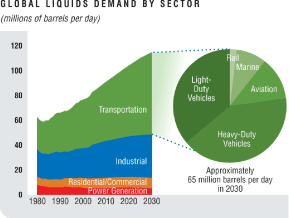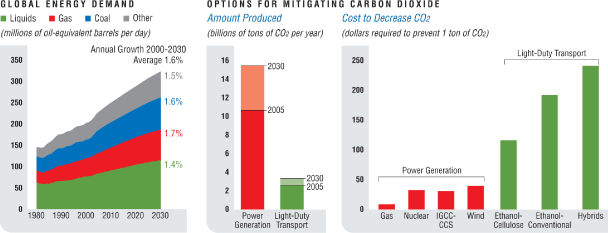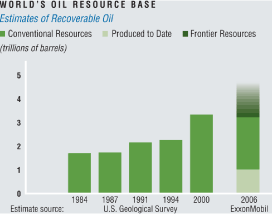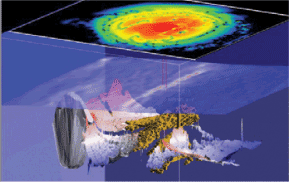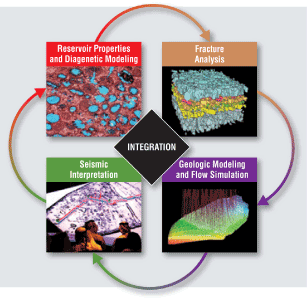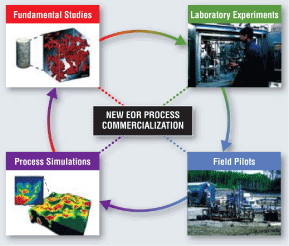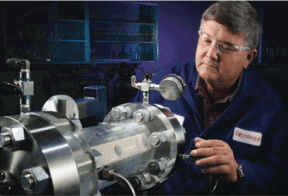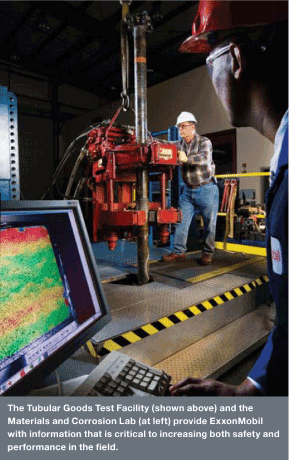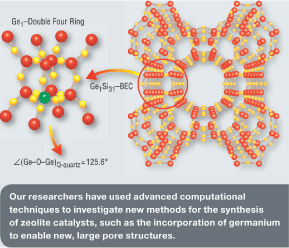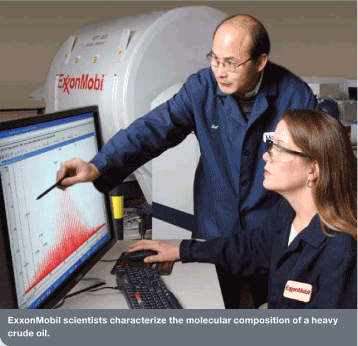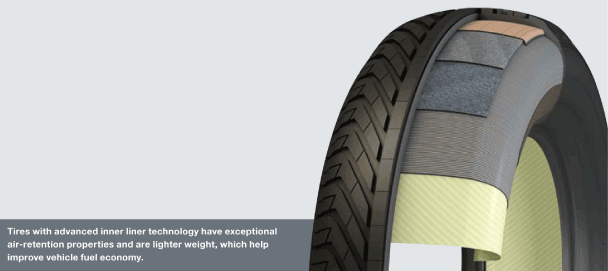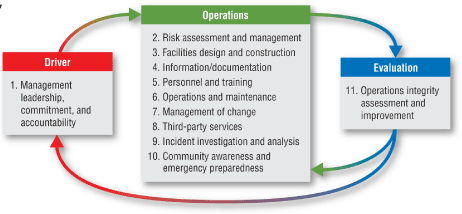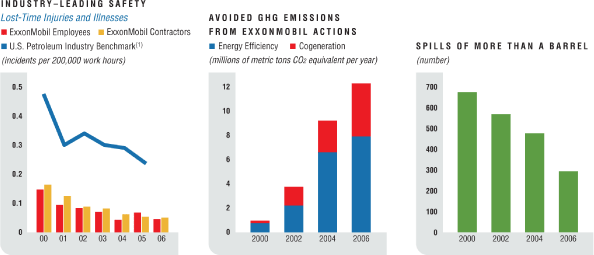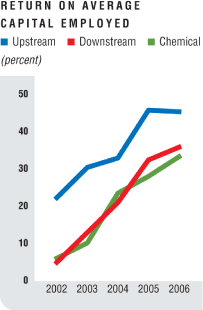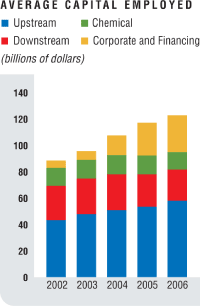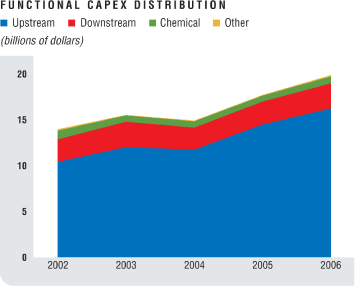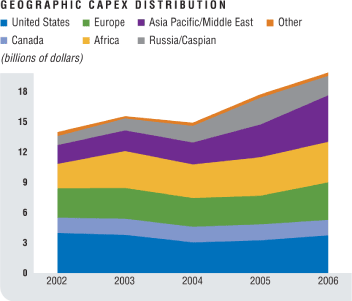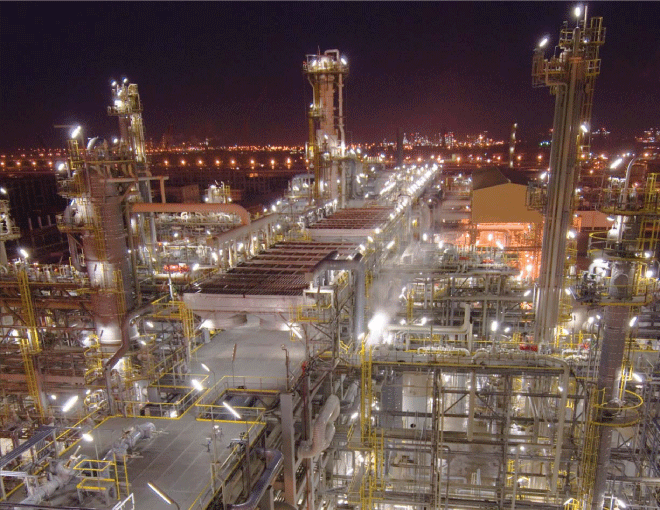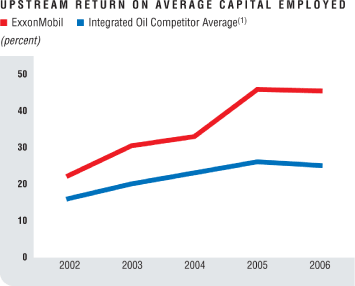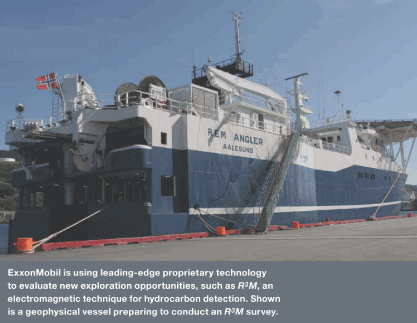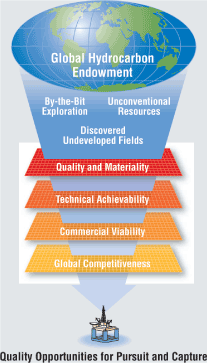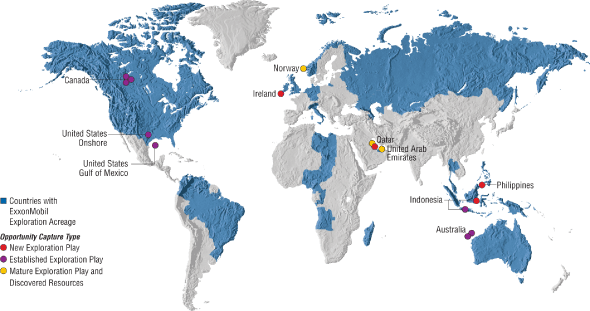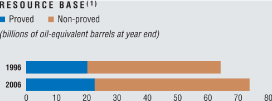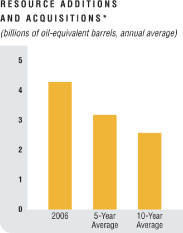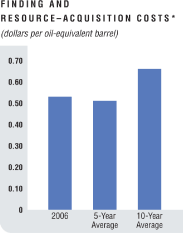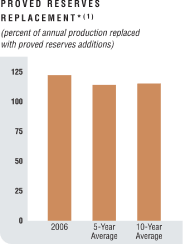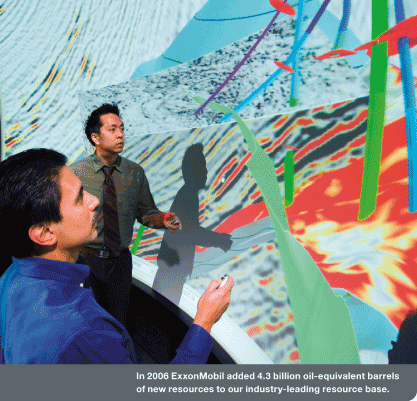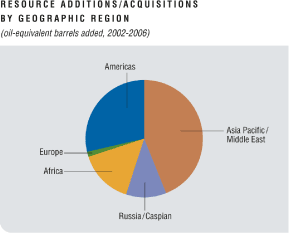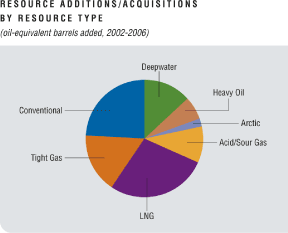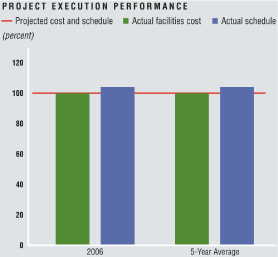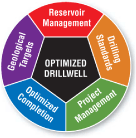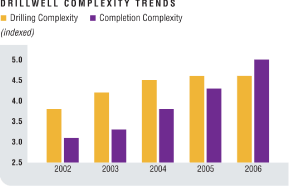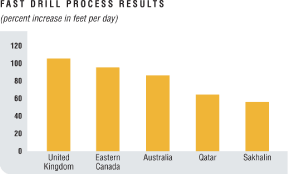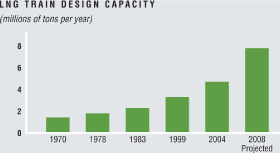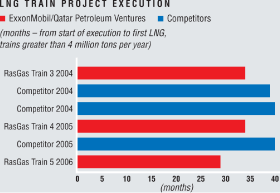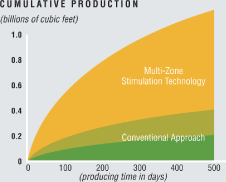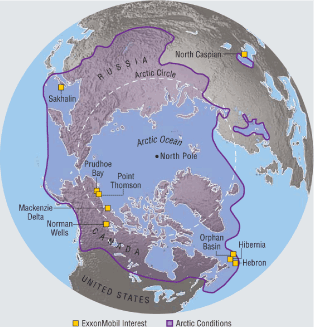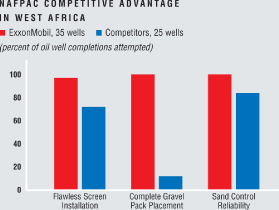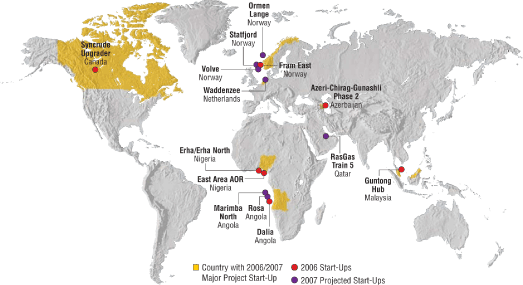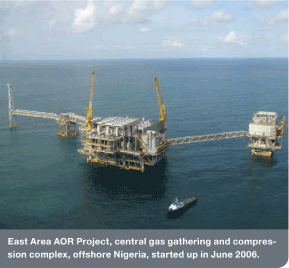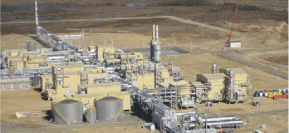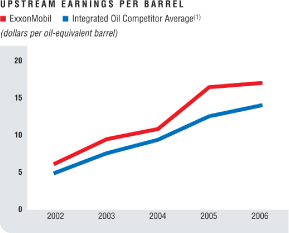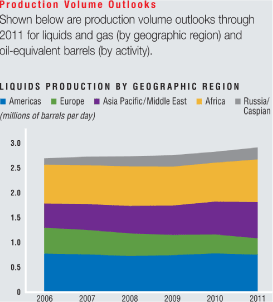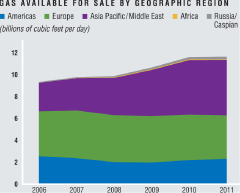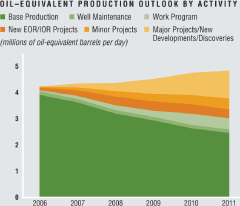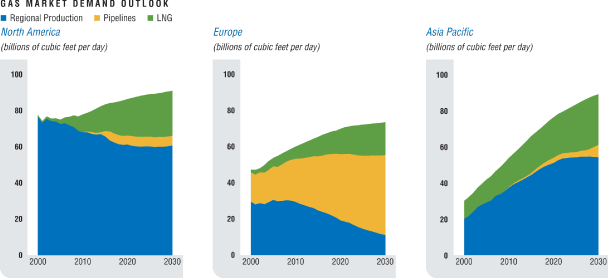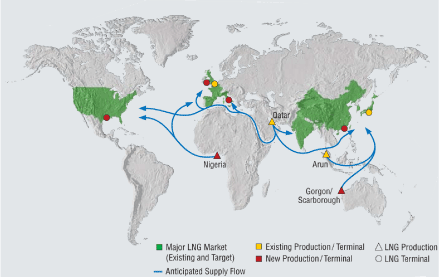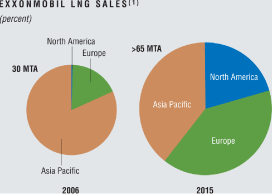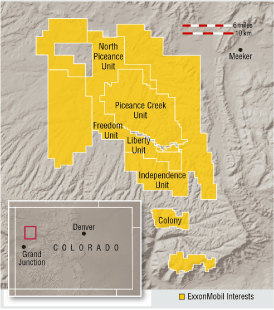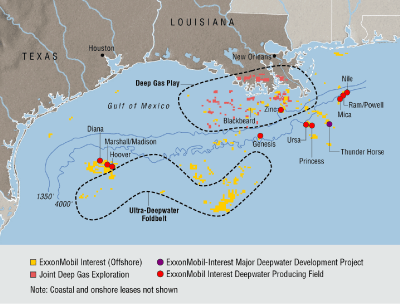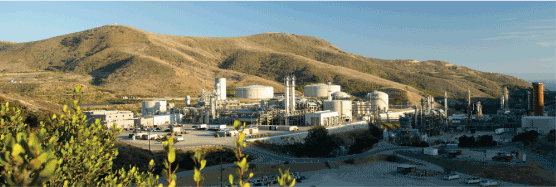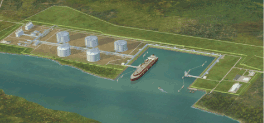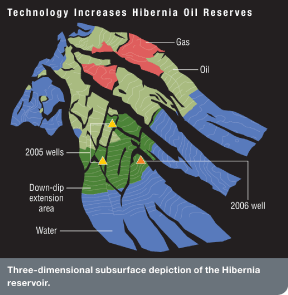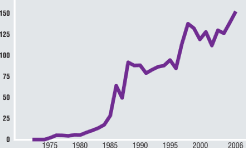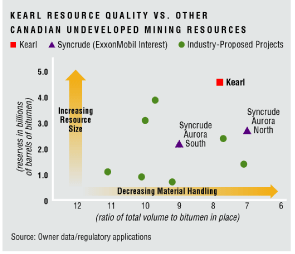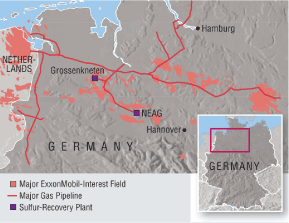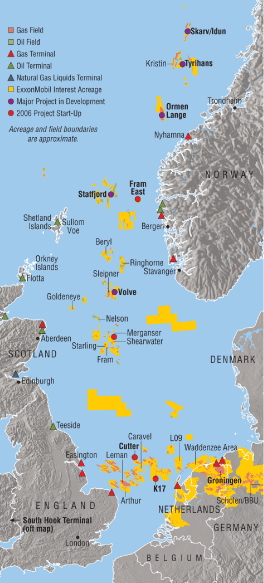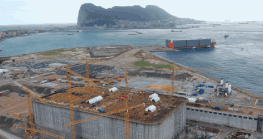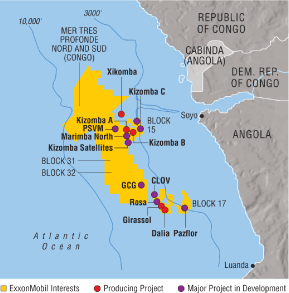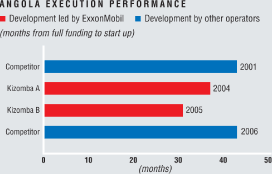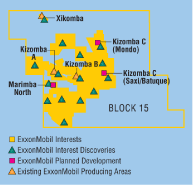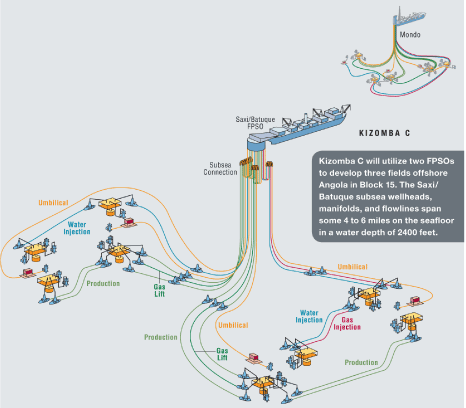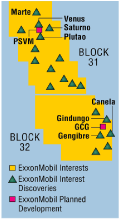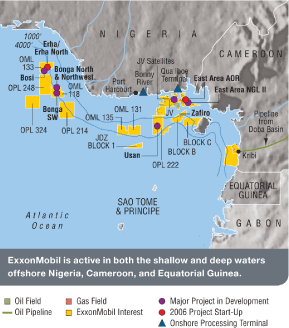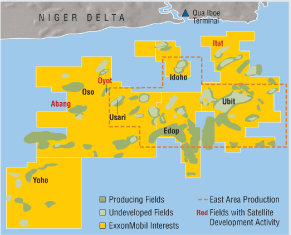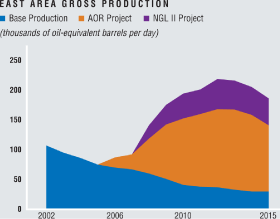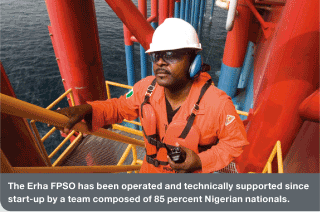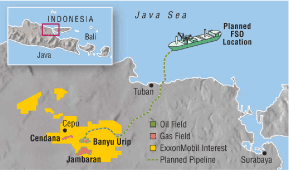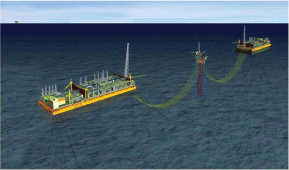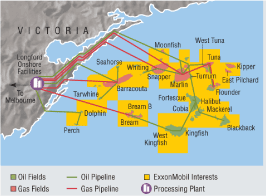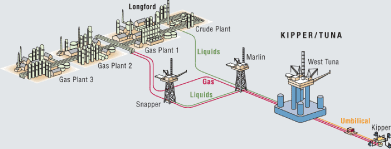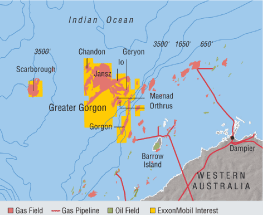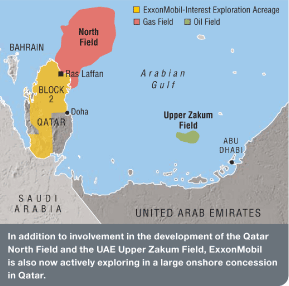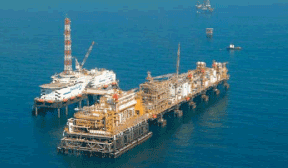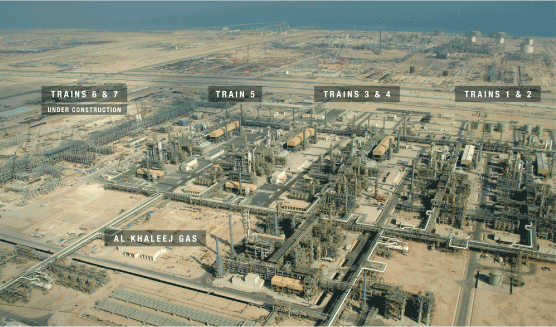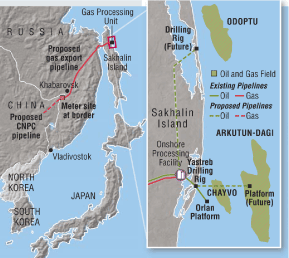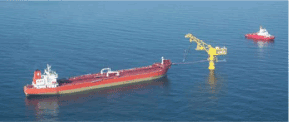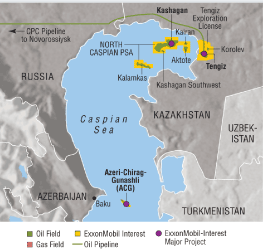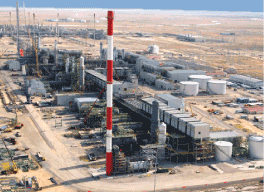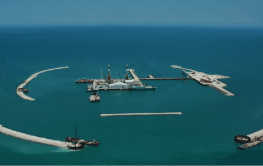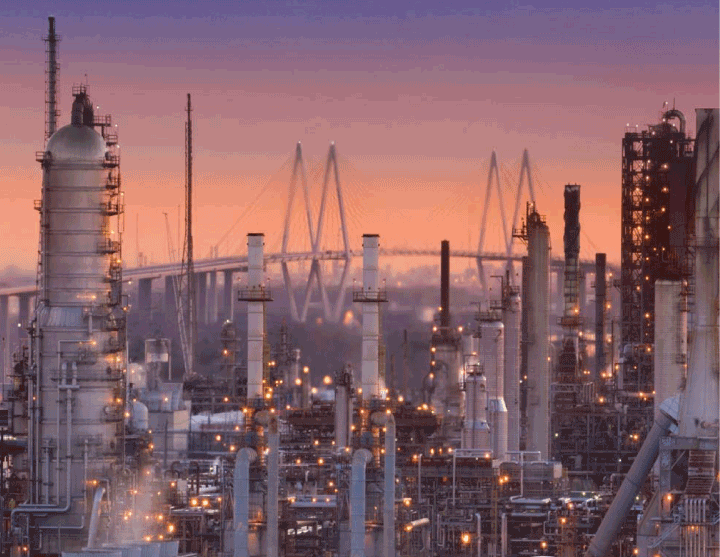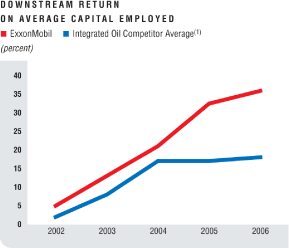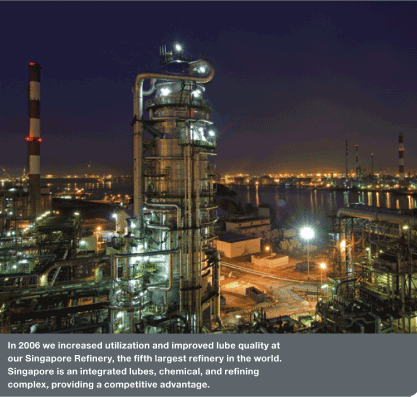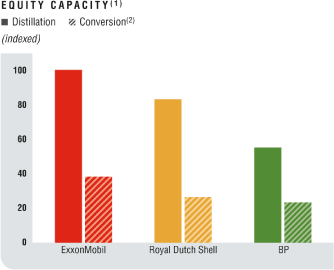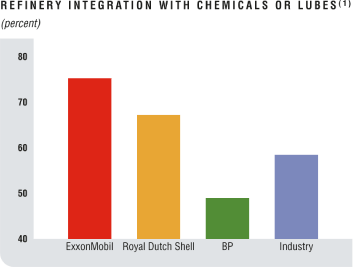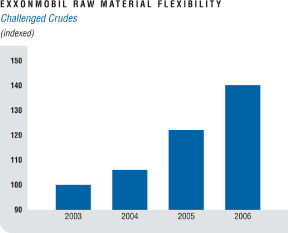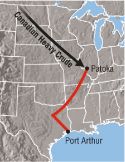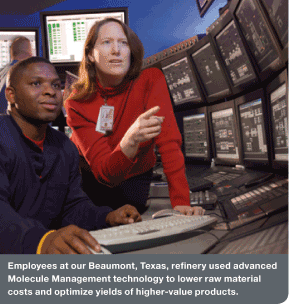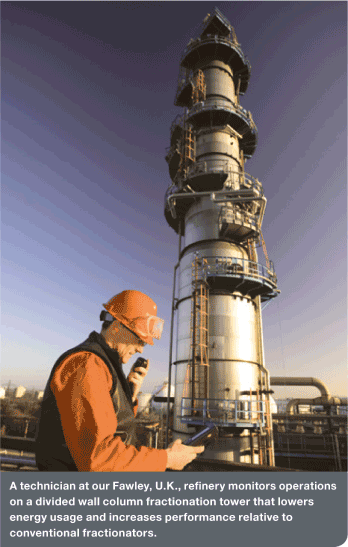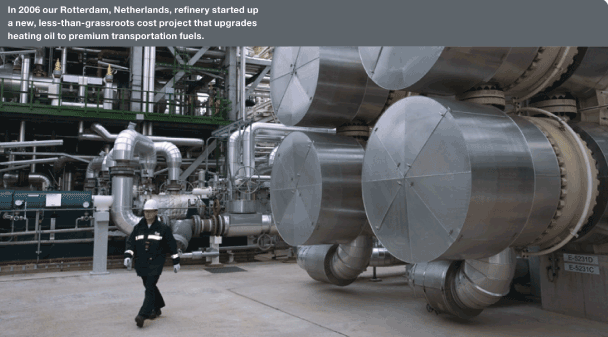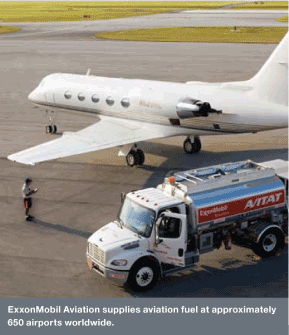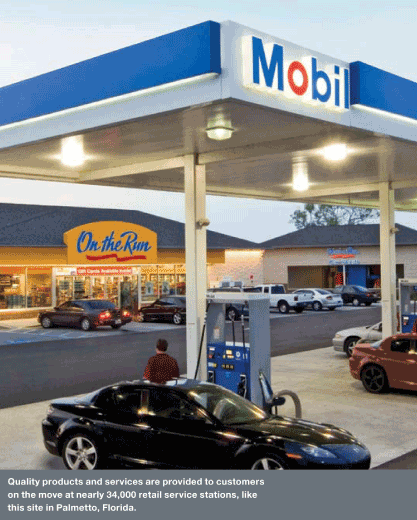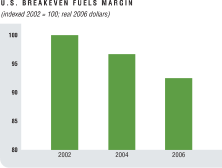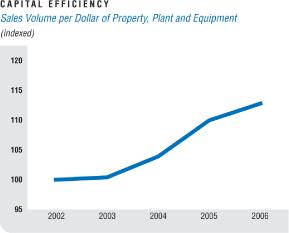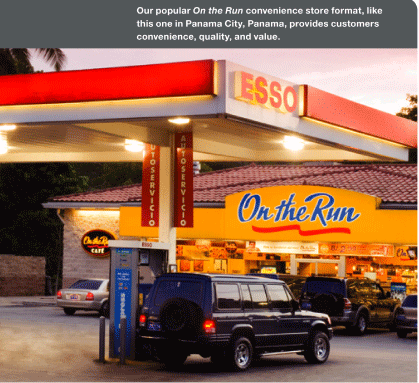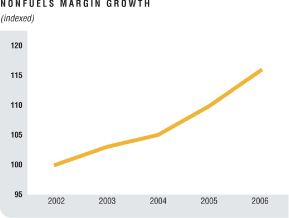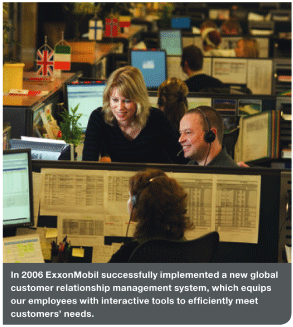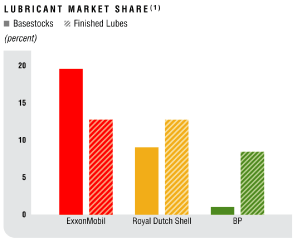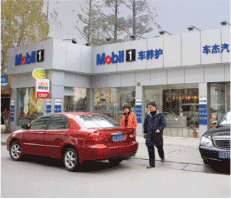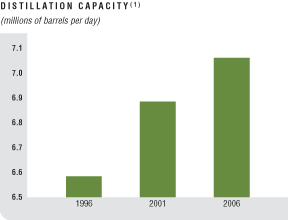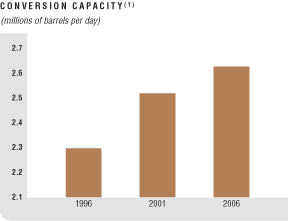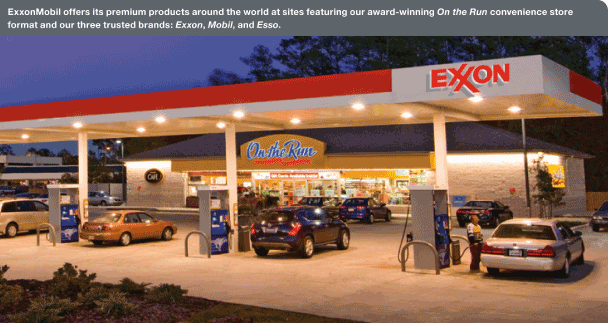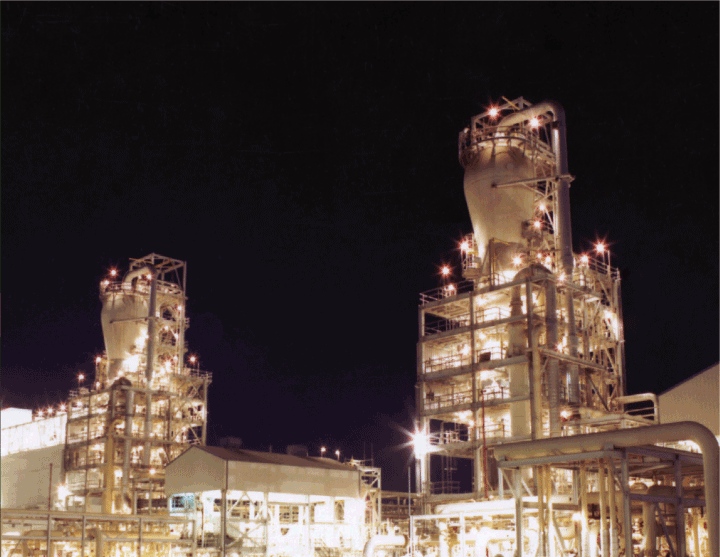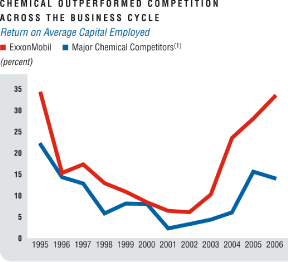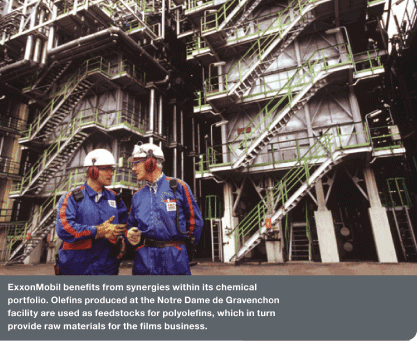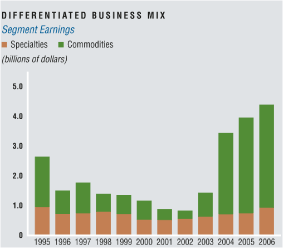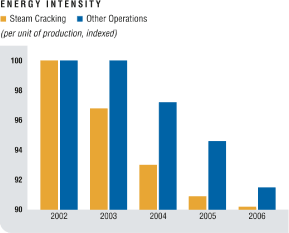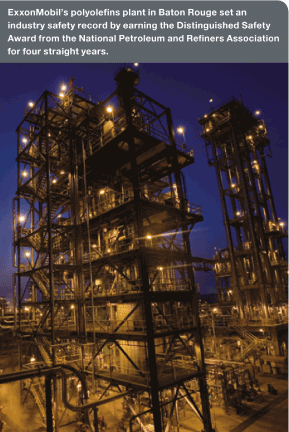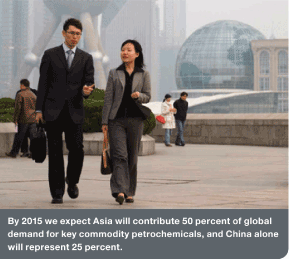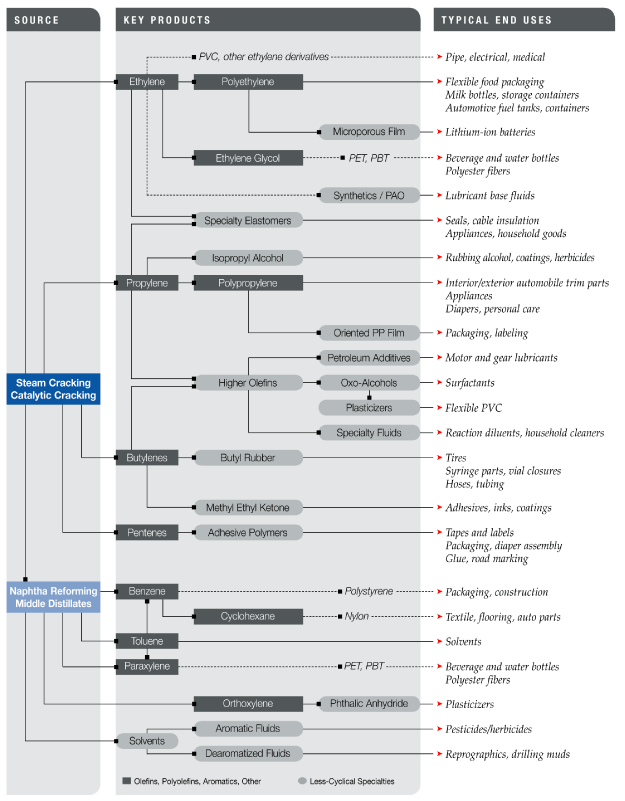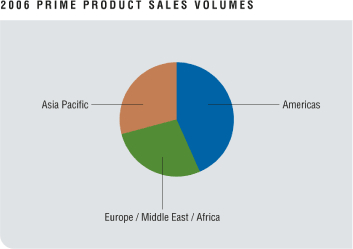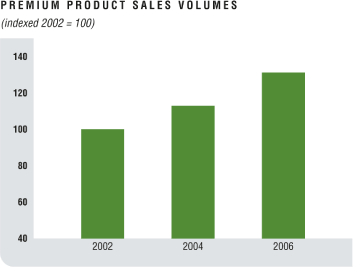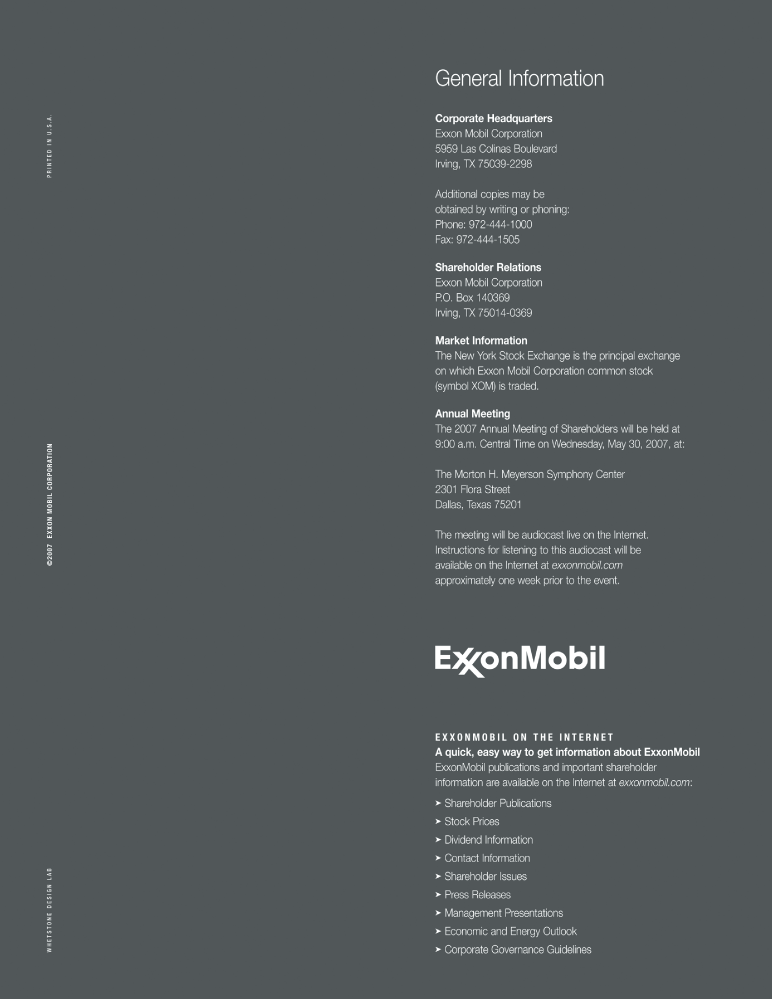Table of Contents
| | | | | |
| | | 2-23 | |
| | | 24-63 | |
| | | 64-79 | |
| | | 80-87 | |
| | | 88-91 | |
| | | 92 | |
The term Upstream refers to exploration, development, production, and gas and power marketing. Downstream refers to the refining and marketing of petroleum products such as motor fuels and lubricants.
Projections, targets, expectations, estimates, and business plans in this report are forward-looking statements. Actual future results, including demand growth and energy mix; capacity growth; the impact of new technologies; capital expenditures; project plans, dates, and capacities; production rates and resource recoveries; and, efficiency gains and cost savings could differ materially due to, for example, changes in oil and gas prices or other market conditions affecting the oil and gas industry; reservoir performance; timely completion of development projects; war and other political or security disturbances; changes in law or government regulation; the actions of competitors; unexpected technological developments; the occurrence and duration of economic recessions; the outcome of commercial negotiations; unforeseen technical difficulties; and other factors discussed in this report and in Item 1A. of ExxonMobil’s most recent Form 10-K.
Definitions of certain financial and operating measures and other terms used in this report are contained in the section titled “Frequently Used Terms” on pages 88 through 91. In the case of financial measures, the definitions also include information required by SEC Regulation G to the extent we believe applicable.
“Factors Affecting Future Results” and “Frequently Used Terms” are also posted on our Web site and are updated from time to time.
Prior years’ data have been reclassified in certain cases to conform to the 2006 presentation basis.
ON THE COVER
ExxonMobil’s global scale and integration advantages extend across our Upstream, Downstream, and Chemical businesses. The East Area Project (top left) offshore Nigeria that started-up in 2006 is expected to significantly increase reservoir recovery. Downstream facilities such as our Singapore complex (middle right) are world-scale and frequently integrated with on-site Chemical facilities. Our complexes at both Singapore and Baytown, Texas (middle left), as well as other locations worldwide, integrate refining and petrochemical processes to maximize the value of feedstocks and deliver efficiencies.
EXXON MOBIL CORPORATION§ 2006 FINANCIAL & OPERATING REVIEW 1
Consistency.
In our shareholder focus, in our long-term approach.
Integrity.
In our business practices, in our operations, in our people.
Discipline.
In our investment decisions, in our execution of fundamental business strategies.
Reliability.
In the quality of our products, in our daily operations, in meeting our commitments.
Ingenuity.
In our proprietary research, in our technology applications, in our thinking.
Energy is fundamental to the world’s economies.
Improving living standards around the globe requires
affordable, reliable energy. Providing this energy is an
enormous challenge – one that must be met practically, safely,
and in an environmentally and socially responsible manner.
| | |
| | | |
 | | Rex W. Tillerson
Chairman and CEO |
2 EXXON MOBIL CORPORATION§ 2006 FINANCIAL & OPERATING REVIEW
ExxonMobil leads our industry by consistently delivering superior operating and financial results. Our business model maintains focus on long-term fundamentals and growing shareholder value.
BUSINESS MODEL
Our business model is disciplined and straightforward; taking a long-term perspective and focusing on generating growth in shareholder value while managing risk. We begin with a disciplined investment approach. We combine this with operational excellence, as demonstrated by our industry-leading safety record. Our superior return on capital employed (ROCE) reflects our ability to generate more income from a highly efficient capital base. Rigorous execution of this model delivers industry-leading financial and operating results that generate greater long-term returns for our shareholders.
Superior 2006 Results
| § | | Industry-leading safety record |
| |
| § | | Record earnings of $39.5 billion |
| |
| § | | Dividend payments per share grew 12.3 percent and increased for the 24th consecutive year |
| |
| § | | $32.6 billion in distributions to shareholders, an increase of 41 percent or $9.4 billion versus 2005 |
| |
| § | | Industry-leading return on average capital employed (ROCE) of 32.2 percent |
| |
| § | | Proved reserves additions replaced 122 percent of production |
| |
| § | | Production increased by 4 percent year on year, 7 percent excluding divestment and entitlement effects |
| |
| § | | Seven major Upstream projects began production |
| |
| § | | Downstream and Chemical operating cost efficiencies and revenue enhancements exceeded $1.5 billion after tax |
EXXON MOBIL CORPORATION§ 2006 FINANCIAL & OPERATING REVIEW 3
FINANCIAL HIGHLIGHTS
| | | | | | | | | | | | | | | | | | | | | |
| (millions of dollars, unless noted) | | 2006 | | | 2005 | | | 2004 | | | 2003 | | | 2002 | |
| |
Sales and other operating revenue(1)(2) | | | 365,467 | | | | 358,955 | | | | 291,252 | | | | 237,054 | | | | 200,949 | |
| Net income | | | 39,500 | | | | 36,130 | | | | 25,330 | | | | 21,510 | | | | 11,460 | |
Cash flow from operations and asset sales(3) | | | 52,366 | | | | 54,174 | | | | 43,305 | | | | 30,788 | | | | 24,061 | |
Capital and exploration expenditures(3) | | | 19,855 | | | | 17,699 | | | | 14,885 | | | | 15,525 | | | | 13,955 | |
| Cash dividends to ExxonMobil shareholders | | | 7,628 | | | | 7,185 | | | | 6,896 | | | | 6,515 | | | | 6,217 | |
Common stock purchases(gross) | | | 29,558 | | | | 18,221 | | | | 9,951 | | | | 5,881 | | | | 4,798 | |
| Research and development costs | | | 733 | | | | 712 | | | | 649 | | | | 618 | | | | 631 | |
Cash and cash equivalents at year end(4) | | | 28,244 | | | | 28,671 | | | | 18,531 | | | | 10,626 | | | | 7,229 | |
| Total assets at year end | | | 219,015 | | | | 208,335 | | | | 195,256 | | | | 174,278 | | | | 152,644 | |
| Total debt at year end | | | 8,347 | | | | 7,991 | | | | 8,293 | | | | 9,545 | | | | 10,748 | |
| Shareholders’ equity at year end | | | 113,844 | | | | 111,186 | | | | 101,756 | | | | 89,915 | | | | 74,597 | |
Average capital employed(3) | | | 122,573 | | | | 116,961 | | | | 107,339 | | | | 95,373 | | | | 88,342 | |
Share price at year end(dollars) | | | 76.63 | | | | 56.17 | | | | 51.26 | | | | 41.00 | | | | 34.94 | |
| Market valuation at year end | | | 438,990 | | | | 344,491 | | | | 328,128 | | | | 269,294 | | | | 234,101 | |
Regular employees at year end(thousands) | | | 82.1 | | | | 83.7 | | | | 85.9 | | | | 88.3 | | | | 92.5 | |
| |
| | | | | | | | | | | | | |
KEY FINANCIAL RATIOS |
| | | | | | | | | | | | | |
| | | 2006 | | | 2005 | | | 2004 | | | 2003 | | | 2002 | |
| |
Net income per common share(dollars) | | | 6.68 | | | | 5.76 | | | | 3.91 | | | | 3.24 | | | | 1.69 | |
Net income per common share – assuming dilution(dollars) | | | 6.62 | | | | 5.71 | | | | 3.89 | | | | 3.23 | | | | 1.68 | |
Return on average capital employed(3)(percent) | | | 32.2 | | | | 31.3 | | | | 23.8 | | | | 20.9 | | | | 13.5 | |
Net income to average shareholders’ equity(percent) | | | 35.1 | | | | 33.9 | | | | 26.4 | | | | 26.2 | | | | 15.5 | |
Debt to capital(5)(percent) | | | 6.6 | | | | 6.5 | | | | 7.3 | | | | 9.3 | | | | 12.2 | |
Net debt to capital(6)(percent) | | | (20.4 | ) | | | (22.0 | ) | | | (10.7 | ) | | | (1.2 | ) | | | 4.4 | |
| Current assets to current liabilities | | | 1.55 | | | | 1.58 | | | | 1.40 | | | | 1.20 | | | | 1.15 | |
Fixed charge coverage(times) | | | 46.3 | | | | 50.2 | | | | 36.1 | | | | 30.8 | | | | 13.8 | |
| |
| | |
| (1) | | Sales and other operating revenue includes sales-based taxes of $30,381 million for 2006, $30,742 million for 2005, $27,263 million for 2004, $23,855 million for 2003 and $22,040 million for 2002. |
| |
| (2) | | Sales and other operating revenue includes $30,810 million for 2005, $25,289 million for 2004, $20,936 million for 2003, and $18,150 million for 2002 for purchases/sales contracts with the same counterparty. Associated costs were included in Crude oil and product purchases. Effective January 1, 2006, these purchases/sales were recorded on a net basis with no resulting impact on net income. |
| |
| (3) | | See Frequently Used Terms on pages 88 through 91. |
| |
| (4) | | Excluding restricted cash of $4,604 million in 2006, 2005, and 2004. |
| |
| (5) | | Debt includes short- and long-term debt. Capital includes short- and long-term debt, shareholders’ equity, and minority interests. |
| |
| (6) | | Debt net of cash, excluding restricted cash. The ratio of net debt to capital including restricted cash is (26.3) percent for 2006. |

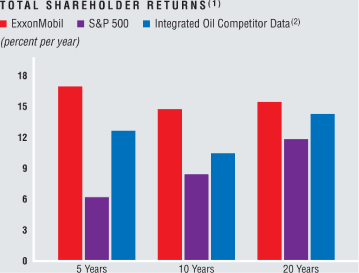
| | |
| (1) | | See Frequently Used Terms on pages 88 through 91. |
| |
| (2) | | Royal Dutch Shell, BP, and Chevron values are calculated on a consistent basis with ExxonMobil, based on public information. |
4 EXXON MOBIL CORPORATION§ 2006 FINANCIAL & OPERATING REVIEW
Business Strategies
ExxonMobil’s unparalleled execution of fundamental business strategies drives success.
Taking on and solving tough challenges required to meet the world’s energy demand is not new to ExxonMobil. However, the hurdles we face today are different from those we have overcome in the past. Today, a greater number of significant new oil and gas resources are in remote areas and difficult operating environments; major upstream projects are more capital intensive; and operating complexity places greater emphasis on execution excellence. What remains unchanged is ExxonMobil’s approach to the business. Our consistent strategies, combined with our ability to execute consistently, positively differentiates our performance in each of our businesses.
ENSURE SAFE, ENVIRONMENTALLY SOUND OPERATIONS
We maintain safety as our top priority. ExxonMobil’s long-term safety performance is industry leading. Our commitment to safety, health, and the environment creates a sound foundation for superior results in all aspects of our business. We comply with all applicable laws and regulations as a minimum standard, and we apply responsible standards where laws and regulations do not exist.
UPHOLD HIGH STANDARDS
ExxonMobil has long recognized the importance of sound corporate governance, strong business controls, integrity, and high ethical standards. We believe that the methods we use to attain results are as important as the results themselves.
These principles form the basis of ourStandards of Business Conduct, and are regularly reinforced with all employees. Our straightforward business model; ethical standards; and culture of integrity, legal compliance, and accountability underpin the entirety of our business and are essential to delivering industry-leading results.
| | |
| (1) | | Royal Dutch Shell, BP, and Chevron values are estimated on a consistent basis with ExxonMobil, based on public information. |
INVEST WITH DISCIPLINE
We work to capture quality investment opportunities while maintaining a selective and disciplined approach. Every year we identify and progress a diverse portfolio of world-class investment opportunities. These investment decisions affect our results for decades. Seven major Upstream projects began production in 2006, culminating work effort and investment that began as much as 15 years ago.
These projects and many others demonstrate our practice of investing throughout the commodity price and economic cycles. Potential investment opportunities are tested over a wide range of economic scenarios to assure resiliency. Post investment, we complete a rigorous appraisal of all major projects. This knowledge is then incorporated into future project planning and design to ensure asset value is maximized.
PURSUE OPERATIONAL EXCELLENCE
ExxonMobil has an unwavering commitment to operations safety and integrity embedded in our company culture and implemented globally through our management systems. We operate with the highest industry standards in all aspects of our business. We meet our commitments and set industry benchmarks in the process.
To accomplish this, ExxonMobil has developed a wide range of proven management systems. These systems utilize a proactive approach and cover all important aspects of our operations, from business ethics, finance, project execution and appraisal, to business controls, security, safety, health, and environmental performance. They also encompass profit improvement initiatives, including efforts to improve reliability, lower costs, and increase revenue. The application of management and operating systems, rigorously deployed in our functional organizations, has consistently delivered superior results.
EXXON MOBIL CORPORATION§ 2006 FINANCIAL & OPERATING REVIEW 5
OPTIMIZE RESULTS THROUGH FUNCTIONAL DIVERSITY AND INTEGRATION
ExxonMobil’s size, global scope, and functional diversity strengthen the Corporation’s resiliency to changes in commodity prices, business cycles, and regional market conditions. Our global presence provides us with an efficient platform for investing in any opportunity that meets our rigorous criteria. We bring unparalleled capability and business experience to each opportunity. For example, in the Upstream our deep functional expertise in exploration, drilling, development, production, gas marketing, and technology, combined with integration across these functions, ensures the delivery of unparalleled resource value.
In addition, the level of integration within and across our businesses is a clear advantage, including both physical integration of facilities and virtual integration of our vast network of personnel. The integration of our refining and chemical facilities lowers site operating costs, and enhances margins through optimal feedstock and product interchange.
ATTRACT AND RETAIN EXCEPTIONAL PEOPLE
A key to ExxonMobil’s success is our workforce – highly capable, diverse, and focused on the right business priorities. Developing such a workforce requires leadership, succession planning, training, accountability, stewardship, constancy of purpose, and communication such that our people across the globe understand our priorities and how they are to be achieved.
Our process begins by recruiting outstanding talent and accelerating the development of those with strong leadership potential. It includes both formal training and skill development through exposure to a variety of work experiences over a career. Our performance-based development system is integrated throughout the Corporation. ExxonMobil is a meritocracy where people are given valuable and rewarding experiences that help them simultaneously learn, grow, and contribute.
INCREASE EFFICIENCY THROUGH
OUR GLOBAL FUNCTIONAL ORGANIZATION
Our industry is a cyclical commodity business, where prices are determined by market forces beyond the control of any one company. To excel in this environment, we actively identify and implement best practices that are resilient throughout the commodity price cycle.
ExxonMobil’s businesses are organized on a global basis to accelerate continuous improvement by enabling the prompt identification, prioritization, and sharing of ideas, technology, and best practices around the globe. Our global functional organization also facilitates deployment of our people to the best opportunities. It turns an organization spread over a vast geography into a closely connected business that rapidly captures opportunity and drives improvement.
DIFFERENTIATE THROUGH PROPRIETARY TECHNOLOGY
Technological innovation continues to differentiate ExxonMobil from the competition. Our consistent investment in proprietary research and development, currently at a level of over $700 million per year, has resulted in the discovery of next-generation and breakthrough technologies with the potential to provide a step change to the Corporation’s competitive position and financial performance. We also focus on developing and deploying technology extensions to continuously improve existing operations.
MAINTAIN FINANCIAL STRENGTH
ExxonMobil has consistently maintained one of the strongest financial positions of any company in the world. We are one of just a few public companies to maintain the highest credit ratings from Standard & Poor’s (AAA) and Moody’s (Aaa), and we have done so for each of the last 88 years.
Our unparalleled access to financial resources gives us the flexibility to pursue opportunities worldwide throughout the economic cycle with the knowledge that they can be financed. Host governments recognize this strength and its importance as they look to develop their resources and economies.
| | |
| (1) | | Net cash from operating and investing activities, excluding increase in restricted cash and cash equivalents (see page 23). |
6 EXXON MOBIL CORPORATION§ 2006 FINANCIAL & OPERATING REVIEW
ExxonMobil’s Core Objective – Long-Term Growth in Shareholder Value
Over the past five years, ExxonMobil has distributed over $92 billion to shareholders including $34 billion through dividend payments and $58 billion via share purchases to reduce shares outstanding. In 2006 we distributed $25 billion to reduce shares outstanding and almost $8 billion in dividend payments.
The Corporation has paid a dividend every year for over a century and has increased its annual dividend every year since 1983. Since the beginning of 2002, quarterly dividends have grown 39 percent from $0.23 to $0.32 per share.
ExxonMobil has used its flexible share purchase program to reduce the number of shares outstanding by 16 percent since the beginning of 2002. Reducing shares outstanding increases the ownership percentage of the company that each remaining share represents and contributes to increased earnings and cash flow per share.
DIVIDEND AND SHAREHOLDER RETURN INFORMATION
| | | | | | | | | | | | | | | | | | | | | |
| | | 2006 | | | 2005 | | | 2004 | | | 2003 | | | 2002 | |
| |
Net income per common share(dollars) | | | 6.68 | | | | 5.76 | | | | 3.91 | | | | 3.24 | | | | 1.69 | |
Net income per common share – assuming dilution(dollars) | | | 6.62 | | | | 5.71 | | | | 3.89 | | | | 3.23 | | | | 1.68 | |
| |
Dividends per common share(dollars) | | | | | | | | | | | | | | | | | | | | |
| First quarter | | | 0.32 | | | | 0.27 | | | | 0.25 | | | | 0.23 | | | | 0.23 | |
| Second quarter | | | 0.32 | | | | 0.29 | | | | 0.27 | | | | 0.25 | | | | 0.23 | |
| Third quarter | | | 0.32 | | | | 0.29 | | | | 0.27 | | | | 0.25 | | | | 0.23 | |
| Fourth quarter | | | 0.32 | | | | 0.29 | | | | 0.27 | | | | 0.25 | | | | 0.23 | |
| |
| Total | | | 1.28 | | | | 1.14 | | | | 1.06 | | | | 0.98 | | | | 0.92 | |
| |
Dividends per share growth(annual percent) | | | 12.3 | | | | 7.5 | | | | 8.2 | | | | 6.5 | | | | 1.1 | |
| |
Number of common shares outstanding(millions) | | | | | | | | | | | | | | | | | | | | |
| Average | | | 5,913 | | | | 6,266 | | | | 6,482 | | | | 6,634 | | | | 6,753 | |
| Average – assuming dilution | | | 5,970 | | | | 6,322 | | | | 6,519 | | | | 6,662 | | | | 6,803 | |
| Year end | | | 5,729 | | | | 6,133 | | | | 6,401 | | | | 6,568 | | | | 6,700 | |
| |
Cash dividends paid on common stock(millions of dollars) | | | 7,628 | | | | 7,185 | | | | 6,896 | | | | 6,515 | | | | 6,217 | |
Cash dividends paid to net income(percent) | | | 19 | | | | 20 | | | | 27 | | | | 30 | | | | 54 | |
Cash dividends paid to cash flow(1)(percent) | | | 15 | | | | 15 | | | | 17 | | | | 23 | | | | 29 | |
| |
Total return to shareholders(annual percent) | | | 39.2 | | | | 11.7 | | | | 27.9 | | | | 20.5 | | | | (8.9 | ) |
| |
Market quotations for common stock(dollars) | | | | | | | | | | | | | | | | | | | | |
| High | | | 79.00 | | | | 65.96 | | | | 52.05 | | | | 41.13 | | | | 44.58 | |
| Low | | | 56.42 | | | | 49.25 | | | | 39.91 | | | | 31.58 | | | | 29.75 | |
| Average daily close | | | 65.35 | | | | 58.24 | | | | 45.29 | | | | 36.14 | | | | 37.70 | |
| Year-end close | | | 76.63 | | | | 56.17 | | | | 51.26 | | | | 41.00 | | | | 34.94 | |
| |
| | |
| (1) | | Net cash provided by operating activities. |
EXXON MOBIL CORPORATION§ 2006 FINANCIAL & OPERATING REVIEW 7
Energy Outlook – A View to 2030
At ExxonMobil, our greatest challenge lies in helping meet the world’s rising energy needs.
The Energy Outlook summarizes our view of the fundamentals that underpin world energy supply and demand through 2030. It provides a strategic foundation, aiding our evaluation and selection of business opportunities that hold the most promise. We continuously update our outlook to ensure that new technologies and information are considered in addition to past experience.
GROWING POPULATIONS AND IMPROVING LIVING STANDARDS
Progress for billions of people around the world is driving a growing need for reliable, affordable, and cleaner energy. We are working to help meet this need.
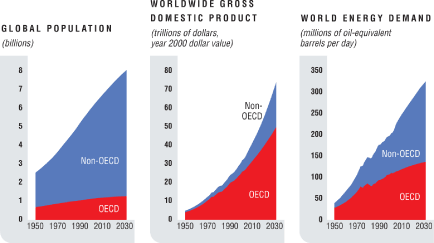 OECD — Organisation for Economic Co-operation and Development
OECD — Organisation for Economic Co-operation and DevelopmentWe project the global population of 6.5 billion people today will grow to 8 billion by 2030. Close to 95 percent of this growth will occur in developing countries, where securing energy to support basic living standards is often difficult.
For progress to occur, access to modern energy supplies and technologies is critical. This requires disciplined investments in energy as well as basic infrastructure. At the same time, continuing to develop and adopt efficient energy practices and technologies is important and prudent.
We expect the global economy will approximately double by 2030, driven by the non-OECD nations including the rapidly expanding economies of China, India, Indonesia and Malaysia. The strong economic growth in the developing countries, along with significant population growth, will drive global energy demand and trade patterns.
DEMAND FOR LIQUIDS
As the world’s population grows, and as incomes increase, so does the global demand for liquid energy supplies (e.g., oil, biofuels). This demand growth is driven primarily by the transportation sector, reflecting the unique advantages of liquid fuels for those applications. Even with anticipated efficiency increases, demand will increase at a rate of 1.4 percent per year.
Total transportation demand in 2030 will be about 50 percent higher than today. This includes light-duty vehicles (cars, SUVs) and heavy-duty vehicles (trucks, buses), along with aviation, marine, and rail. Light- and heavy-duty vehicles will represent the majority of this demand.
A key factor driving demand is the growth in ownership of personal vehicles. This is most evident with the emergence of rapidly expanding non-OECD economies, which we expect will approach half a billion personal vehicles by 2030.
Working to offset demand growth will be continuing improvements in conventional engines and deployment of emerging technologies, such as hybrid vehicles. These advances should enable significant gains in vehicle fuel economy.
Technology has reached the point where liquid fuels can be derived from coal, natural gas, and crops. But even under the most optimistic scenarios, these alternatives will supply only a small fraction of the fuel needed on a global basis. Oil is the world’s transportation fuel of choice, and will remain so for decades.
8 EXXON MOBIL CORPORATION§ 2006 FINANCIAL & OPERATING REVIEW
OIL SUPPLY
By 2030, we expect total liquids demand to be about 115 million barrels per day. The world is endowed with huge oil resources (see sidebar), which are adequate to meet rising demand through 2030. However, access to these resources, huge investments, and the ongoing development and application of technology are essential to developing new supplies.
Technology advances are critical to increasing future oil supplies by enabling more effective resource recovery while minimizing costs and environmental effects. Gains continue in the areas of advanced reservoir imaging, extended-reach drilling, fast drill processes, and enhanced recovery technologies.
Emerging technologies promise to further advance our capability to extend recoverable resources worldwide. New technology will promote economic development of frontier resources such as heavy oil and shale oil to help ensure adequate supplies well past 2030.
THE NEED FOR POWER
Economic growth and improvements in living standards are reflected in the demand for electricity. Those across the world without access to reliable electricity lack a basic ingredient that would allow them to not only improve their lives, but also compete in today’s global economy.
A variety of fuel sources exist for generating power – e.g., coal, natural gas, nuclear, hydro, wind, and solar. Which power generation sources are used will be a function of cost and scale, as well as resource availability.
In developed economies, natural gas will be the primary fuel source for growth in power generation. These countries have access to gas supplies and an existing infrastructure. At the same time, gas has the advantage of higher-efficiency combined-cycle plants and low emissions versus other fuels.
Emerging economies will generally continue to prefer coal. This is especially true in China and India, where coal is abundant, provides supply security, and offers the lowest-cost option for huge populations with surging demand for electricity.
While natural gas and coal demand will grow the most in absolute terms, nuclear and renewable fuels will also see significant growth.
GLOBAL ENERGY IN PERSPECTIVE
Our outlook indicates that overall global energy demand will grow about 1.6 percent annually to 2030.
As has been the case for the past century, the majority of this need will be met by fossil fuels. We expect oil, gas, and coal will remain about 80 percent of global energy in 2030.
Liquids comprise the largest share and are expected to grow about 1.4 percent per year. Most of this demand will be met by crude oil and condensate. Biofuels will also contribute, but even with aggressive growth assumptions, biofuels will reach only about 1 percent of total energy by 2030.
Driven largely by increasing demand for electricity, we expect natural gas demand to grow about 1.7 percent and coal by about 1.6 percent annually.
“Other” energy includes a variety of fuel types that in total will grow about 1.5 percent annually. Biomass – primarily wood and dung – is the largest component and is likely to grow about 1 percent per year. Nuclear is expected to grow on average about 1.4 percent annually, led by Asia Pacific. Hydroelectric growth of about 2 percent per year is also centered in Asia Pacific. We expect wind and solar combined to grow about 10 percent per year, supported by subsidies and mandates. At this high growth rate, wind and solar will reach about 1 percent of total energy in 2030.
EXXON MOBIL CORPORATION§ 2006 FINANCIAL & OPERATING REVIEW 9
GROWING ENERGY DEMAND AND CO2EMISSIONS
As the world’s energy consumption continues to grow, we must be mindful of the implications.
First, large timely investments are necessary to develop the resources required to meet the world’s energy needs. These investments can be made only if industry is allowed access to the resources.
Second, continuing development and application of technology is essential, both in stretching supplies and dampening demand increases.
Third, rising consumption of oil, gas, and coal means that CO2 emissions will also increase. Rising CO2 emissions pose risks for society and ecosystems, which could prove to be significant. Therefore, it is wise to identify the best options to mitigate global CO2 emissions.
In weighing mitigation options, scale and cost are critical elements. While all areas bear scrutiny, the most significant opportunities and the lowest cost options to reduce CO2 emissions are likely to be in the power generation sector, where emissions are associated with large plants.
Another area of focus is the transport sector, where CO2 emissions are generated by huge numbers of dispersed sources (e.g., cars, trucks). This is a smaller target than power generation and presents more expensive alternatives.
Clearly a variety of options exist to mitigate CO2 emissions, but they each come at a cost, ultimately borne by consumers. Effectively addressing this issue requires understanding the potential scale, cost, and tradeoffs involved.
CONCLUSIONS
Key conclusions of our outlook include:
| § | | By 2030, energy demand will increase about 60 percent compared to 2000. The vast majority of this increase will occur in developing nations, but efficiency gains throughout the world will remain important. |
| |
| § | | The global energy mix will look very similar 25 years from now as oil, gas, and coal will remain predominant. |
| |
| § | | Resources are adequate to support global demand growth. Access to these resources and large, timely investments will be needed to ensure reliable energy supplies. |
| |
| § | | Global trade, particularly for oil and natural gas, will continue to grow. |
| |
| § | | Technology will remain critical to success in all aspects of our energy challenges, whether mitigating demand growth, expanding supplies, or protecting the environment. |
Our outlook is focused on the world’s rising energy needs and how we expect these needs to be met, considering scale and cost issues.
Providing this energy is not easy or automatic. The challenges reflect the global magnitude of the task, as well as often competing objectives related to economic development, energy security, and the environment.
Our approach is to address global energy challenges in a pragmatic fashion, recognizing that proposed solutions that are not feasible on a broad-based, commercial scale are not solutions at all.
With our leading resource base, financial and technological strength, disciplined investment approach, and project portfolio, we are well-positioned to help meet the global needs for substantial new energy supplies. These assets provide us with a sustainable competitive advantage and help us remain at the forefront in meeting the energy challenges and capitalizing on the opportunities ahead.
Sidebar
| § | | One way to understand the impact of technology is to look directly at global resource base estimates over time. |
| |
| § | | In this chart, the first five bars show estimates by the U.S. Geological Survey (USGS) of total recoverable conventional oil – in trillions of barrels (TBO) – with estimates increasing over time. |
| |
| § | | At ExxonMobil, our experience is the same. Our current estimate of 3.2 TBO (far right bar) is comparable to the most recent USGS estimate. |
| |
| § | | If we add estimated frontier resources, such as heavy oil and shale oil, total recoverable volume grows to over 4 trillion barrels. |
| |
| § | | Only about 1 trillion barrels, or less than 25 percent of the total estimated recoverable oil, have been produced. In light of this, we see ample resources available to meet the growing demand of oil through 2030. |
10 EXXON MOBIL CORPORATION§ 2006 FINANCIAL & OPERATING REVIEW
Technology
Leading the industry through research and application in all business segments.
ExxonMobil is the industry leader in technology, maintaining research efforts on both breakthrough concepts and evolutionary technology improvements that enhance performance across our business lines.
UPSTREAM TECHNOLOGY
Our continually evolving suite of proprietary technologies related to exploration, development, and production operations provides competitive advantage in the Upstream. The following examples illustrate the breadth and impact of these technologies.
Reservoir Imaging Breakthrough
ExxonMobil’sR3Mtechnology provides a breakthrough in remotely detecting and imaging hydrocarbon reservoirs beneath the ocean. This patented technology is the product of research begun over 20 years ago, and it has been used to explore off the coasts of West Africa, Brazil, and Colombia, as well as the Gulf of Mexico. TheR3M technology distinguishes hydrocarbon-filled reservoirs (shown at right) from other subsurface rocks by measuring their contrasting electrical properties. Currently,R3M analysis is supporting exploration drilling in the Orphan Basin offshore Newfoundland.
Optimum Drilling and Completions
The need to drill and complete more challenging wells has led ExxonMobil to develop differentiating technology based on improved knowledge of physics limits in drilling and completion processes. This knowledge has been built into proprietary drilling software, calledToolPro, and is used to create optimal drilling designs. A physics-limit approach is also used in ExxonMobil’s Fast Drill Process (FDP), which has resulted in rate-of-penetration improvement of up to 100 percent. The combined result of usingToolProsoftware and the FDP is an unparalleled ability to drill complex wells at lower costs. In addition, knowing the physics limits for well completions has extended well operability guidelines and led to development of patented completion equipment and techniques. As a result, in West Africa deepwater completions, ExxonMobil’s technology has yielded 18-percent cost savings while increasing initial well flow efficiencies 75 percent over the industry average using conventional methods. Our worldwide record of no deepwater well completion failures in the last five years is unmatched in industry

Accurate Characterization of Carbonate Reservoirs
Because carbonate reservoirs hold over half of the world’s oil reserves, ExxonMobil has a major research effort in accurately characterizing carbonate reservoirs to optimize field development and production. We have developed a unique process that combines advanced technologies with expertise from a multidisciplinary team of geoscientists and engineers to predict reservoir properties. This process is customized for the particular carbonate field under study and produces designs for developing and producing carbonate reservoirs to extract the maximum value. We have successfully applied the carbonate reservoir characterization process in major Qatar and Kazakhstan reservoirs, and this technology was an important differentiating capability for ExxonMobil in the award of an interest in the Upper Zakum field in Abu Dhabi in 2006.
EXXON MOBIL CORPORATION§ 2006 FINANCIAL & OPERATING REVIEW 11
Enhanced Oil Recovery
ExxonMobil’s leading position in enhanced oil recovery (EOR) stems from its extensive R&D commitment, operational capabilities, and worldwide field experience. For the last 35 years, we have maintained one of the largest EOR research programs in the industry, developing new gas injection, chemical, and thermal recovery methods. ExxonMobil’s proven approach is to integrate research on fundamental recovery processes with special laboratory measurements and simulation studies to design, pilot test, and conduct commercial projects. The development and application of recovery processes that are tailored to the reservoir allow full recovery potential to be realized. This successful approach has led to our current involvement in one-third of the world’s gas injection EOR production and our operation of the world’s largest thermal bitumen recovery project.
Advanced Reservoir Simulation
ExxonMobil continues to develop and add advanced capabilities to its next-generation reservoir simulator,EMpower,to maintain its industry-leading position in reservoir flow modeling. In particular, we have improved the accuracy of reservoir simulation for heavy oil assets with the addition of several new thermal modeling features. These capabilities represent more fully the physical and chemical processes involved in thermal simulation and heavy oil recovery, thereby allowing better depletion planning and improved recovery. Continued commitment to major enhancements to theEMpowersimulator ensures that ExxonMobil will maintain a superior simulation capability to support its investment decisions.
UNIQUE LARGE - SCALE TESTING FACILITY
For over 45 years, ExxonMobil has operated a large-scale testing facility at Friendswood, Texas, about 20 miles south-east of Houston, that is unique to the oil and gas industry. This facility includes state-of-the-art laboratories focused on corrosion, well tubulars, formation fracturing, sand control, wax, and hydrates. Among these labs, the Materials and Corrosion Lab provides a multiphase flow loop to simulate various field conditions for testing materials and calibrating ExxonMobil’s proprietary corrosion model. This model predicts corrosion conditions over time and helps ensure flow line integrity. Similarly, the Tubular Goods Test Facility provides full-scale testing of pipe systems used in drilling, casing, and producing wells. Test results are combined with computational modeling to assure the performance and long-term reliability of pipes and pipe connections.
12 EXXON MOBIL CORPORATION§ 2006 FINANCIAL & OPERATING REVIEW
DOWNSTREAM AND CHEMICAL TECHNOLOGY
Our development and utilization of technology in the Downstream and Chemical businesses provides a competitive advantage. ExxonMobil scientists and engineers utilize the most advanced equipment and techniques to conduct research that delivers process and product improvements. Each year we invest millions of dollars in laboratory and computing tools to grow our technical capabilities, develop our people, and enable our researchers to obtain faster and more precise and accurate results.
To ensure steady delivery of new technology, we manage our research and development portfolio as a technology pipeline consisting of three sections:
Discovery, in which a new idea is born and tested;Development, in which the technology is advanced into technical readiness; andDeployment, in which the technology is brought to commercial manufacturing or the market.
In 2006 we had over 200 programs in various stages of technology development. Each is fully aligned with one or more of our strategic business initiatives: lower cost processes, advantaged feeds, and higher-value products.
Lower- Cost Processes
Our Downstream and Chemical manufacturing facilities strive to lower processing costs by delivering improved efficiency, greater reliability, and better asset utilization.
Discovery of new, improved catalysts – substances that accelerate chemical reactions without themselves being consumed – is one way to lower processing costs. ExxonMobil is a recognized leader in zeolite synthesis and hydroprocessing catalysis, and we continue to develop and deploy new technology in these areas.
For example, over the past several years, our investment in technology provided us with a competitive advantage in meeting new, more stringent sulfur specifications in gasoline and diesel. We have commissioned numerousSCANfiningunits to produce low-sulfur gasoline, and have successfully licensed this technology. We have also commissioned more than 10 new or upgraded hydrotreating units for ultra-low sulfur diesel production. To keep this technology pipeline full, we continually search for new and improved catalysts. Our new capabilities in high throughput experimentation have identified several next generation catalysts with potential for step-out improvements in the efficient production of low-sulfur fuels.
The commercialization of the newOlgonetechnology in 2006 is another example of successful low-cost process technology development. TheOlgonetechnology enables more effective removal of olefins from aromatics streams and can offer significant benefits in terms of operating and capital costs, solid waste reduction, and operations improvement. TheOlgonecatalyst also provides improved environmental performance as it is regenerable, unlike the traditional clay it replaces.
ExxonMobil technology has also enabled the design and operation of polyethylene reactors that are the largest in the industry. In addition, we continue to identify and commercialize process improvements that expand operability windows. These capabilities provide significant advantages for this key commodity business.
EXXON MOBIL CORPORATION§ 2006 FINANCIAL & OPERATING REVIEW 13
Advantaged Feeds
Developing new technology to process challenging feeds provides greater flexibility in meeting marketing demands and lowering raw material costs. In this area, our Molecule Management program continues to yield tremendous benefits.
One of the core components is our ability to characterize – at the molecular level – feed and product streams. In 2006 we further advanced our analytical capabilities for identifying the heaviest molecules in crudes and refinery streams. This information is combined with sophisticated modeling and other tools to optimize crude slates, process-unit conditions, and product distributions, thereby enabling greater quantities of higher-value products to be extracted from cheaper feedstocks.
Similarly, we continue to work on new hydroprocessing technology to upgrade the “bottom of the barrel” to higher-value chemical feeds. An added benefit is that by enabling our refineries and chemical plants to process heavier and more challenging feeds, we increase our supply reliability, as reflected in the continued increase in the number of crudes and feed streams our facilities can handle.
Higher-Value Products
Technology also plays an important role in developing new products of benefit to consumers, such as advanced lubricants or polymers with superior properties.
In the lubricants area, we have developed a premium, heavy-duty diesel engine oil product line to meet the new stringent emission control regulations. The oils protect the engines through superior viscosity control, reduced deposit formation, and increased wear protection, while meeting strict chemical limits to protect sensitive emissions control equipment. ExxonMobil’sDelvac 1300 Super engine oils were one of the first oils on the market and provide customers with an excellent solution for maintaining engine cleanliness and performance.
In 2006 ExxonMobil introduced a global portfolio of custom-compounded polyolefins to automotive customers based on ongoing investment in technology and compounding expertise. These products complement the company’s neat polymer and impact copolymer product lines, providing a complete line of products for automotive interior, exterior, and under hood applications.
A milestone in the development of improved tire inner liners that combines the elasticity of a rubber with the low-air permeability of a plastic was also announced by ExxonMobil and The Yokohama Rubber Co., Ltd (YRC). The new technology is based on proprietaryExxpropolymers and polymer alloys developed by ExxonMobil, as well as alloys and application technology developed by YRC. Advantages include improved durability and lower rolling resistance.
14 EXXON MOBIL CORPORATION§ 2006 FINANCIAL & OPERATING REVIEW
Safety, Health & Environment
We maintain our commitment to high standards of safety, security, health, and environmental care. Our delivered performance demonstrates that commitment.
2006 HIGHLIGHTS
| § | | Best-ever workforce safety performance. |
| |
| § | | Major energy efficiency improvements in Refining and Chemical operations. |
| |
| § | | Fewest spills on record. |
| |
| § | | Successful transition of facilities to meet new low-sulfur fuels requirements. |
GUIDING PRINCIPLE
ExxonMobil is committed to maintaining high standards of safety, security, health, and environmental care. We comply with all applicable laws and regulations, and we apply responsible standards where laws and regulations do not exist. Our goal is to drive injuries, illnesses, and operational incidents with environmental impact to zero. To help reach that goal, ExxonMobil has active technology programs to support safety, security, health, and environmental initiatives, including both internal and external work by leading scientists. We believe a company’s commitment to achieving superior performance in safety, health, and the environment are closely tied to outstanding performance in all other aspects of operations. We have shown that we can produce products that are essential to society while protecting the health and safety of people and safeguarding the environment.
We employ a disciplined, systematic approach we call OIMS – our Operations Integrity Management System. ExxonMobil developed this system to provide a robust framework for managing safety, security, health, and environmental risks. It is used in our facilities worldwide and enables us to measure progress and ensure management accountability for results in these areas. We are pleased that Lloyd’s Register Quality Assurance has recognized OIMS as meeting all requirements of the International Organization for Standardization’s standard for environmental management systems (ISO 14001).
RISK MANAGEMENT
Risks are inherent in the energy and petrochemical businesses, including risks associated with safety, security, health, and the environment. ExxonMobil recognizes these risks and takes a systematic approach to reducing them. Providing energy to the growing world safely and in an environmentally responsible manner is a responsibility we take very seriously. The same rigor and discipline that underpin our investment program are also used in our approach to the management of our performance in safety, security, health, and the environment.
We place great emphasis on planning and preparedness to ensure a quick and effective response to incidents. In 2006 we conducted six major regional emergency response drills, which included a major drill conducted together with the U.S. Coast Guard in Alaska in October. We have also developed plans for our response to an influenza pandemic and are currently implementing preparations globally.
SAFETY AND HEALTH
At ExxonMobil, safety and health in the workplace is a top priority. Based on careful analysis of incidents and risks, we are continuously working to improve the safety and health of our employees and contractors, as we strive for a workplace whereNobody Gets Hurt. Since 1994, we have reduced employee lost-time incidents by a factor of more than 10. Innovative approaches, such as our Exposure Assessment Strategy (EAS), contribute to this progress. This state-of-the-art product, developed by ExxonMobil, enables systematic identification, analysis, and control of potential causes of illness in our facilities.
ExxonMobil maintains an active commitment to the communities in which we work, and we believe that improvement in public health is a key enabler for broader
OPERATIONS INTEGRITY MANAGEMENT SYSTEM ELEMENTS
EXXON MOBIL CORPORATION§ 2006 FINANCIAL & OPERATING REVIEW 15
economic and social gains. Through our Africa Health Initiative, we have awarded grants of about $40 million to fight malaria. ExxonMobil recognizes the devastating impact HIV/AIDS has on lives, and in response, we initiated the StopAIDS program. This program includes workplace education, access to community-based counseling and testing, and access to equitable care through the company-sponsored health plans and programs.
ENVIRONMENT
ExxonMobil is committed to achieving excellent environmental performance in each of our businesses toProtect Tomorrow. Today.We operate responsibly wherever we do business by implementing scientifically sound, practical solutions that consider environmental imperatives and the economic needs of the communities in which we operate. The company has a straightforward framework to guide our environmental practices. In addition to the consistent use of OIMS and careful adherence to all applicable laws and regulations, business lines are expected to:
| § | | Deliver superior environmental performance, which will lead to competitive advantage; |
| |
| § | | Continually improve performance and drive incidents with environmental impact to zero; and, |
| |
| § | | Achieve industry leadership in key environmental performance areas. |
Our Environmental Business Planning (EBP) contained within OIMS is used by our businesses to update environmental targets and improvement plans, and to integrate them into business strategies and plans. ExxonMobil incorporates efficiency improvements, emissions reductions, and considerations of environmental impacts into the routine operation of our business, as well as into the design of new facilities.
Guided by our EBP process, we are taking actions to reduce emissions and to reduce our footprint in sensitive locations:
| § | | Since the launch of our proprietary Global Energy Management System in 2000, we have reduced greenhouse gas (GHG) emissions by about 8 million metric tons per year of CO2 and energy costs by about $750 million per year, showing that environmental leadership can create business value. |
| |
| § | | We are among the world’s largest investors in liquefied natural gas (LNG) technology. We are progressing LNG terminal projects in Hong Kong, Italy, the United Kingdom, and the United States with consideration for environmental and biodiversity sensitivities. |
| |
| § | | ExxonMobil is an industry leader in the use of cogeneration, a much more efficient way to make power and steam. With projects under construction in Kazakhstan, Belgium, and China, and with continued development of a project in Singapore during 2006, we will increase our current capacity by about 20 percent to over 5,000 megawatts by 2010. |
| |
| § | | ExxonMobil has invested approximately $3.5 billion worldwide to reduce sulfur content of fuels. In 2006 we successfully transitioned our facilities to meet new U.S. ultra-low sulfur diesel requirements, which reduce on-road diesel sulfur content by 97 percent. |
| |
| § | | We are investing about $3 billion to effectively eliminate routine gas flaring in our Nigerian operations by 2008. |
ExxonMobil recognizes that the impact of GHG emissions on society and ecosystems may prove to be significant. In addition to the actions listed above, we are committed to development of breakthrough technology to reduce GHG emissions, including our support for and involvement in the Global Climate and Energy Project (GCEP) at Stanford University, a pioneering research effort to identify low greenhouse gas energy technology.
| | |
| (1) | | Employee safety data from participating American Petroleum Institute companies (2006 industry data not available at time of publication). |
16 EXXON MOBIL CORPORATION§ 2006 FINANCIAL & OPERATING REVIEW
FUNCTIONAL EARNINGS
| | | | | | | | | | | | | | | | | | | | | | | | | | | | | | | | | | | | | |
| | | 2006 Quarters | | | | | | | | | | | | | | | | |
| (millions of dollars) | | First | | | Second | | | Third | | | Fourth | | | 2006 | | | 2005 | | | 2004 | | | 2003 | | | 2002 | |
| |
Net Income (U.S. GAAP) | | | | | | | | | | | | | | | | | | | | | | | | | | | | | | | | | | | | |
Upstream | | | | | | | | | | | | | | | | | | | | | | | | | | | | | | | | | | | | |
| United States | | | 1,280 | | | | 1,644 | | | | 1,192 | | | | 1,052 | | | | 5,168 | | | | 6,200 | | | | 4,948 | | | | 3,905 | | | | 2,524 | |
| Non-U.S. | | | 5,103 | | | | 5,490 | | | | 5,301 | | | | 5,168 | | | | 21,062 | | | | 18,149 | | | | 11,727 | | | | 10,597 | | | | 7,074 | |
| Total | | | 6,383 | | | | 7,134 | | | | 6,493 | | | | 6,220 | | | | 26,230 | | | | 24,349 | | | | 16,675 | | | | 14,502 | | | | 9,598 | |
| |
Downstream | | | | | | | | | | | | | | | | | | | | | | | | | | | | | | | | | | | | |
| United States | | | 679 | | | | 1,354 | | | | 1,272 | | | | 945 | | | | 4,250 | | | | 3,911 | | | | 2,186 | | | | 1,348 | | | | 693 | |
| Non-U.S. | | | 592 | | | | 1,131 | | | | 1,466 | | | | 1,015 | | | | 4,204 | | | | 4,081 | | | | 3,520 | | | | 2,168 | | | | 607 | |
| Total | | | 1,271 | | | | 2,485 | | | | 2,738 | | | | 1,960 | | | | 8,454 | | | | 7,992 | | | | 5,706 | | | | 3,516 | | | | 1,300 | |
| |
Chemical | | | | | | | | | | | | | | | | | | | | | | | | | | | | | | | | | | | | |
| United States | | | 329 | | | | 189 | | | | 458 | | | | 384 | | | | 1,360 | | | | 1,186 | | | | 1,020 | | | | 381 | | | | 384 | |
| Non-U.S. | | | 620 | | | | 651 | | | | 893 | | | | 858 | | | | 3,022 | | | | 2,757 | | | | 2,408 | | | | 1,051 | | | | 446 | |
| Total | | | 949 | | | | 840 | | | | 1,351 | | | | 1,242 | | | | 4,382 | | | | 3,943 | | | | 3,428 | | | | 1,432 | | | | 830 | |
| |
Corporate and financing | | | (203 | ) | | | (99 | ) | | | (92 | ) | | | 828 | | | | 434 | | | | (154 | ) | | | (479 | ) | | | 1,510 | | | | (442 | ) |
Merger expenses | | | — | | | | — | | | | — | | | | — | | | | — | | | | — | | | | — | | | | — | | | | (275 | ) |
Discontinued operations | | | — | | | | — | | | | — | | | | — | | | | — | | | | — | | | | — | | | | — | | | | 449 | |
Accounting change | | | — | | | | — | | | | — | | | | — | | | | — | | | | — | | | | — | | | | 550 | | | | — | |
| |
Net income (U.S. GAAP) | | | 8,400 | | | | 10,360 | | | | 10,490 | | | | 10,250 | | | | 39,500 | | | | 36,130 | | | | 25,330 | | | | 21,510 | | | | 11,460 | |
| |
Net income per common share(dollars) | | | 1.38 | | | | 1.74 | | | | 1.79 | | | | 1.77 | | | | 6.68 | | | | 5.76 | | | | 3.91 | | | | 3.24 | | | | 1.69 | |
Net income per common share — assuming dilution(dollars) | | | 1.37 | | | | 1.72 | | | | 1.77 | | | | 1.76 | | | | 6.62 | | | | 5.71 | | | | 3.89 | | | | 3.23 | | | | 1.68 | |
| |
| | | | | | | | | | | | | | | | | | | | | | | | | | | | | | | | | | | | | |
| Merger Effects, Discontinued Operations, Accounting Change, and Other Special Items |
Upstream | | | | | | | | | | | | | | | | | | | | | | | | | | | | | | | | | | | | |
| United States | | | — | | | | — | | | | — | | | | — | | | | — | | | | — | | | | — | | | | — | | | | — | |
| Non-U.S. | | | — | | | | — | | | | — | | | | — | | | | — | | | | 1,620 | | | | — | | | | 1,700 | | | | (215 | ) |
| Total | | | — | | | | — | | | | — | | | | — | | | | — | | | | 1,620 | | | | — | | | | 1,700 | | | | (215 | ) |
| |
Downstream | | | | | | | | | | | | | | | | | | | | | | | | | | | | | | | | | | | | |
| United States | | | — | | | | — | | | | — | | | | — | | | | — | | | | (200 | ) | | | (550 | ) | | | — | | | | — | |
| Non-U.S. | | | — | | | | — | | | | — | | | | — | | | | — | | | | 310 | | | | — | | | | — | | | | — | |
| Total | | | — | | | | — | | | | — | | | | — | | | | — | | | | 110 | | | | (550 | ) | | | — | | | | — | |
| |
Chemical | | | | | | | | | | | | | | | | | | | | | | | | | | | | | | | | | | | | |
| United States | | | — | | | | — | | | | — | | | | — | | | | — | | | | — | | | | — | | | | — | | | | — | |
| Non-U.S. | | | — | | | | — | | | | — | | | | — | | | | — | | | | 540 | | | | — | | | | — | | | | — | |
| Total | | | — | | | | — | | | | — | | | | — | | | | — | | | | 540 | | | | — | | | | — | | | | — | |
| |
Corporate and financing | | | — | | | | — | | | | — | | | | 410 | | | | 410 | | | | — | | | | — | | | | 2,230 | | | | — | |
Merger expenses | | | — | | | | — | | | | — | | | | — | | | | — | | | | — | | | | — | | | | — | | | | (275 | ) |
Discontinued operations | | | — | | | | — | | | | — | | | | — | | | | — | | | | — | | | | — | | | | — | | | | 449 | |
Accounting change | | | — | | | | — | | | | — | | | | — | | | | — | | | | — | | | | — | | | | 550 | | | | — | |
| |
Corporate total | | | — | | | | — | | | | — | | | | 410 | | | | 410 | | | | 2,270 | | | | (550 | ) | | | 4,480 | | | | (41 | ) |
| |
| | | | | | | | | | | | | | | | | | | | | | | | | | | | | | | | | | | | | |
| Earnings Excluding Merger Effects, Discontinued Operations, Accounting Change, and Other Special Items(1) |
Upstream | | | | | | | | | | | | | | | | | | | | | | | | | | | | | | | | | | | | |
| United States | | | 1,280 | | | | 1,644 | | | | 1,192 | | | | 1,052 | | | | 5,168 | | | | 6,200 | | | | 4,948 | | | | 3,905 | | | | 2,524 | |
| Non-U.S. | | | 5,103 | | | | 5,490 | | | | 5,301 | | | | 5,168 | | | | 21,062 | | | | 16,529 | | | | 11,727 | | | | 8,897 | | | | 7,289 | |
| Total | | | 6,383 | | | | 7,134 | | | | 6,493 | | | | 6,220 | | | | 26,230 | | | | 22,729 | | | | 16,675 | | | | 12,802 | | | | 9,813 | |
| |
Downstream | | | | | | | | | | | | | | | | | | | | | | | | | | | | | | | | | | | | |
| United States | | | 679 | | | | 1,354 | | | | 1,272 | | | | 945 | | | | 4,250 | | | | 4,111 | | | | 2,736 | | | | 1,348 | | | | 693 | |
| Non-U.S. | | | 592 | | | | 1,131 | | | | 1,466 | | | | 1,015 | | | | 4,204 | | | | 3,771 | | | | 3,520 | | | | 2,168 | | | | 607 | |
| Total | | | 1,271 | | | | 2,485 | | | | 2,738 | | | | 1,960 | | | | 8,454 | | | | 7,882 | | | | 6,256 | | | | 3,516 | | | | 1,300 | |
| |
Chemical | | | | | | | | | | | | | | | | | | | | | | | | | | | | | | | | | | | | |
| United States | | | 329 | | | | 189 | | | | 458 | | | | 384 | | | | 1,360 | | | | 1,186 | | | | 1,020 | | | | 381 | | | | 384 | |
| Non-U.S. | | | 620 | | | | 651 | | | | 893 | | | | 858 | | | | 3,022 | | | | 2,217 | | | | 2,408 | | | | 1,051 | | | | 446 | |
| Total | | | 949 | | | | 840 | | | | 1,351 | | | | 1,242 | | | | 4,382 | | | | 3,403 | | | | 3,428 | | | | 1,432 | | | | 830 | |
| |
Corporate and financing | | | (203 | ) | | | (99 | ) | | | (92 | ) | | | 418 | | | | 24 | | | | (154 | ) | | | (479 | ) | | | (720 | ) | | | (442 | ) |
| |
Corporate total | | | 8,400 | | | | 10,360 | | | | 10,490 | | | | 9,840 | | | | 39,090 | | | | 33,860 | | | | 25,880 | | | | 17,030 | | | | 11,501 | |
| |
Earnings per common share(dollars) | | | 1.38 | | | | 1.74 | | | | 1.79 | | | | 1.70 | | | | 6.61 | | | | 5.40 | | | | 3.99 | | | | 2.57 | | | | 1.70 | |
Earnings per common share — assuming dilution(dollars) | | | 1.37 | | | | 1.72 | | | | 1.77 | | | | 1.69 | | | | 6.55 | | | | 5.35 | | | | 3.97 | | | | 2.56 | | | | 1.69 | |
| |
| | |
| (1) | | See Frequently Used Terms on pages 88 through 91. |
EXXON MOBIL CORPORATION§ 2006 FINANCIAL & OPERATING REVIEW 17
RETURN ON AVERAGE CAPITAL EMPLOYED(1)BY BUSINESS
| | | | | | | | | | | | | | | | | | | | | |
| (percent) | | 2006 | | | 2005 | | | 2004 | | | 2003 | | | 2002 | |
| |
Upstream | | | | | | | | | | | | | | | | | | | | |
| United States | | | 37.1 | | | | 46.0 | | | | 37.0 | | | | 28.9 | | | | 19.0 | |
| Non-U.S. | | | 47.9 | | | | 45.6 | | | | 31.5 | | | | 31.0 | | | | 23.7 | |
| Total | | | 45.3 | | | | 45.7 | | | | 32.9 | | | | 30.4 | | | | 22.3 | |
| |
Downstream | | | | | | | | | | | | | | | | | | | | |
| United States | | | 65.8 | | | | 58.8 | | | | 28.6 | | | | 16.7 | | | | 8.6 | |
| Non-U.S. | | | 24.5 | | | | 22.6 | | | | 18.0 | | | | 11.5 | | | | 3.4 | |
| Total | | | 35.8 | | | | 32.4 | | | | 21.0 | | | | 13.0 | | | | 5.0 | |
| |
Chemical | | | | | | | | | | | | | | | | | | | | |
| United States | | | 27.7 | | | | 23.1 | | | | 19.4 | | | | 7.3 | | | | 7.3 | |
| Non-U.S. | | | 36.5 | | | | 30.9 | | | | 25.7 | | | | 11.8 | | | | 5.3 | |
| Total | | | 33.2 | | | | 28.0 | | | | 23.5 | | | | 10.2 | | | | 6.1 | |
| |
Corporate and financing | | NA | | | NA | | | NA | | | NA | | | NA | |
Discontinued operations | | | — | | | | — | | | | — | | | | — | | | | 63.2 | |
| |
Corporate total | | | 32.2 | | | | 31.3 | | | | 23.8 | | | | 20.9 | | | | 13.5 | |
| |
| | |
| (1) | | Capital employed consists of shareholders’ equity and their share of consolidated debt, including ExxonMobil’s share of amounts applicable to equity companies. See Frequently Used Terms on pages 88 through 91. |
AVERAGE CAPITAL EMPLOYED(1)BY BUSINESS
| | | | | | | | | | | | | | | | | | | | | |
| (millions of dollars) | | 2006 | | | 2005 | | | 2004 | | | 2003 | | | 2002 | |
| |
Upstream | | | | | | | | | | | | | | | | | | | | |
| United States | | | 13,940 | | | | 13,491 | | | | 13,355 | | | | 13,508 | | | | 13,264 | |
| Non-U.S. | | | 43,931 | | | | 39,770 | | | | 37,287 | | | | 34,164 | | | | 29,800 | |
| Total | | | 57,871 | | | | 53,261 | | | | 50,642 | | | | 47,672 | | | | 43,064 | |
| |
Downstream | | | | | | | | | | | | | | | | | | | | |
| United States | | | 6,456 | | | | 6,650 | | | | 7,632 | | | | 8,090 | | | | 8,060 | |
| Non-U.S. | | | 17,172 | | | | 18,030 | | | | 19,541 | | | | 18,875 | | | | 17,985 | |
| Total | | | 23,628 | | | | 24,680 | | | | 27,173 | | | | 26,965 | | | | 26,045 | |
| |
Chemical | | | | | | | | | | | | | | | | | | | | |
| United States | | | 4,911 | | | | 5,145 | | | | 5,246 | | | | 5,194 | | | | 5,235 | |
| Non-U.S. | | | 8,272 | | | | 8,919 | | | | 9,362 | | | | 8,905 | | | | 8,410 | |
| Total | | | 13,183 | | | | 14,064 | | | | 14,608 | | | | 14,099 | | | | 13,645 | |
| |
Corporate and financing | | | 27,891 | | | | 24,956 | | | | 14,916 | | | | 6,637 | | | | 4,878 | |
Discontinued operations | | | — | | | | — | | | | — | | | | — | | | | 710 | |
| |
Corporate total | | | 122,573 | | | | 116,961 | | | | 107,339 | | | | 95,373 | | | | 88,342 | |
| |
Average capital employed applicable to equity companies included above | | | 22,106 | | | | 20,256 | | | | 18,049 | | | | 15,587 | | | | 14,001 | |
| |
| | |
| (1) | | Average capital employed is the average of beginning- and end-of-year business segment capital employed.
See Frequently Used Terms on pages 88 through 91. |
18 EXXON MOBIL CORPORATION§ 2006 FINANCIAL & OPERATING REVIEW
CAPITAL AND EXPLORATION EXPENDITURES(1)
| | | | | | | | | | | | | | | | | | | | | |
| (millions of dollars) | | 2006 | | | 2005 | | | 2004 | | | 2003 | | | 2002 | |
| |
Upstream | | | | | | | | | | | | | | | | | | | | |
| Exploration | | | | | | | | | | | | | | | | | | | | |
| United States | | | 425 | | | | 297 | | | | 248 | | | | 275 | | | | 295 | |
| Non-U.S. | | | 1,619 | | | | 1,396 | | | | 1,035 | | | | 940 | | | | 1,015 | |
| Total | | | 2,044 | | | | 1,693 | | | | 1,283 | | | | 1,215 | | | | 1,310 | |
| |
Production(2) | | | | | | | | | | | | | | | | | | | | |
| United States | | | 2,058 | | | | 1,841 | | | | 1,669 | | | | 1,842 | | | | 2,057 | |
| Non-U.S. | | | 12,059 | | | | 10,844 | | | | 8,629 | | | | 8,758 | | | | 6,949 | |
| Total | | | 14,117 | | | | 12,685 | | | | 10,298 | | | | 10,600 | | | | 9,006 | |
| |
| Power and Coal | | | | | | | | | | | | | | | | | | | | |
| United States | | | 3 | | | | 4 | | | | 5 | | | | 8 | | | | 5 | |
| Non-U.S. | | | 67 | | | | 88 | | | | 129 | | | | 165 | | | | 73 | |
| Total | | | 70 | | | | 92 | | | | 134 | | | | 173 | | | | 78 | |
| |
Total Upstream | | | 16,231 | | | | 14,470 | | | | 11,715 | | | | 11,988 | | | | 10,394 | |
| |
| | | | | | | | | | | | | | | | | | | | | |
Downstream | | | | | | | | | | | | | | | | | | | | |
| Refining | | | | | | | | | | | | | | | | | | | | |
| United States | | | 559 | | | | 497 | | | | 550 | | | | 998 | | | | 670 | |
| Non-U.S. | | | 1,051 | | | | 871 | | | | 774 | | | | 768 | | | | 685 | |
| Total | | | 1,610 | | | | 1,368 | | | | 1,324 | | | | 1,766 | | | | 1,355 | |
| |
| Marketing | | | | | | | | | | | | | | | | | | | | |
| United States | | | 233 | | | | 217 | | | | 201 | | | | 216 | | | | 255 | |
| Non-U.S. | | | 852 | | | | 859 | | | | 811 | | | | 739 | | | | 761 | |
| Total | | | 1,085 | | | | 1,076 | | | | 1,012 | | | | 955 | | | | 1,016 | |
| |
| Pipeline/Marine | | | | | | | | | | | | | | | | | | | | |
| United States | | | 32 | | | | 39 | | | | 24 | | | | 30 | | | | 55 | |
| Non-U.S. | | | 2 | | | | 12 | | | | 45 | | | | 30 | | | | 24 | |
| Total | | | 34 | | | | 51 | | | | 69 | | | | 60 | | | | 79 | |
| |
Total Downstream | | | 2,729 | | | | 2,495 | | | | 2,405 | | | | 2,781 | | | | 2,450 | |
| |
| | | | | | | | | | | | | | | | | | | | | |
Chemical | | | | | | | | | | | | | | | | | | | | |
| United States | | | 280 | | | | 243 | | | | 262 | | | | 333 | | | | 575 | |
| Non-U.S. | | | 476 | | | | 411 | | | | 428 | | | | 359 | | | | 379 | |
| Total Chemical | | | 756 | | | | 654 | | | | 690 | | | | 692 | | | | 954 | |
| |
| | | | | | | | | | | | | | | | | | | | | |
Other | | | | | | | | | | | | | | | | | | | | |
| United States | | | 130 | | | | 80 | | | | 66 | | | | 64 | | | | 45 | |
| Non-U.S. | | | 9 | | | | — | | | | 9 | | | | — | | | | 32 | |
Total other | | | 139 | | | | 80 | | | | 75 | | | | 64 | | | | 77 | |
| |
| | | | | | | | | | | | | | | | | | | | | |
Discontinued Operations | | | | | | | | | | | | | | | | | | | | |
| Non-U.S. | | | — | | | | — | | | | — | | | | — | | | | 80 | |
| |
Total capital and exploration expenditures | | | 19,855 | | | | 17,699 | | | | 14,885 | | | | 15,525 | | | | 13,955 | |
| |
| | |
| (1) | | See Frequently Used Terms on pages 88 through 91. |
| |
| (2) | | Including related transportation. |
EXXON MOBIL CORPORATION§ 2006 FINANCIAL & OPERATING REVIEW 19
TOTAL CAPITAL AND EXPLORATION EXPENDITURES BY GEOGRAPHY
| | | | | | | | | | | | | | | | | | | | | |
| (millions of dollars) | | 2006 | | | 2005 | | | 2004 | | | 2003 | | | 2002 | |
| |
| United States | | | 3,720 | | | | 3,218 | | | | 3,025 | | | | 3,766 | | | | 3,957 | |
| Canada | | | 1,526 | | | | 1,599 | | | | 1,546 | | | | 1,601 | | | | 1,513 | |
| Europe | | | 3,721 | | | | 2,829 | | | | 2,845 | | | | 3,046 | | | | 2,919 | |
| Africa | | | 4,019 | | | | 3,815 | | | | 3,330 | | | | 3,657 | | | | 2,405 | |
| Asia Pacific/Middle East | | | 4,601 | | | | 3,241 | | | | 2,168 | | | | 2,046 | | | | 1,863 | |
| Russia/Caspian | | | 1,932 | | | | 2,656 | | | | 1,650 | | | | 1,184 | | | | 893 | |
| Other | | | 336 | | | | 341 | | | | 321 | | | | 225 | | | | 405 | |
| |
Total worldwide | | | 19,855 | | | | 17,699 | | | | 14,885 | | | | 15,525 | | | | 13,955 | |
| |
DISTRIBUTION OF CAPITAL AND EXPLORATION EXPENDITURES
| | | | | | | | | | | | | | | | | | | | | |
| (millions of dollars) | | 2006 | | | 2005 | | | 2004 | | | 2003 | | | 2002 | |
| |
Consolidated Companies’ Expenditures | | | | | | | | | | | | | | | | | | | | |
| Capital expenditures | | | 15,361 | | | | 13,792 | | | | 11,901 | | | | 12,857 | | | | 11,499 | |
| Exploration costs charged to expense | | | | | | | | | | | | | | | | | | | | |
| United States | | | 243 | | | | 157 | | | | 192 | | | | 256 | | | | 220 | |
| Non-U.S. | | | 925 | | | | 795 | | | | 891 | | | | 735 | | | | 679 | |
Depreciation on support equipment(1) | | | 13 | | | | 12 | | | | 15 | | | | 19 | | | | 21 | |
Total exploration expenses | | | 1,181 | | | | 964 | | | | 1,098 | | | | 1,010 | | | | 920 | |
| |
Total consolidated companies’ capital and exploration expenditures | | | | | | | | | | | | | | | | | | | | |
| (excluding Depreciation on support equipment) | | | 16,529 | | | | 14,744 | | | | 12,984 | | | | 13,848 | | | | 12,398 | |
| | | | | | | | | | | | | | | | | | | | | |
ExxonMobil’s Share of Non-Consolidated Companies’ Expenditures | | | | | | | | | | | | | | | | | | | | |
| Capital expenditures | | | 3,315 | | | | 2,938 | | | | 1,865 | | | | 1,651 | | | | 1,518 | |
| Exploration costs charged to expense | | | 11 | | | | 17 | | | | 36 | | | | 26 | | | | 39 | |
Total non-consolidated companies’ capital and exploration expenditures | | | 3,326 | | | | 2,955 | | | | 1,901 | | | | 1,677 | | | | 1,557 | |
| |
Total capital and exploration expenditures | | | 19,855 | | | | 17,699 | | | | 14,885 | | | | 15,525 | | | | 13,955 | |
| |
| | |
| (1) | | Not included as part of Total capital and exploration expenditures, but included as part of Exploration expenses, including dry holes, in the Summary Statement of Income, page 22. |
20 EXXON MOBIL CORPORATION§ 2006 FINANCIAL & OPERATING REVIEW
NET INVESTMENT IN PROPERTY, PLANT AND EQUIPMENT AT YEAR END
| | | | | | | | | | | | | | | | | | | | | |
| (millions of dollars) | | 2006 | | | 2005 | | | 2004 | | | 2003 | | | 2002 | |
| |
Upstream | | | | | | | | | | | | | | | | | | | | |
| United States | | | 16,467 | | | | 16,222 | | | | 16,410 | | | | 16,992 | | | | 16,924 | |
| Non-U.S. | | | 51,943 | | | | 46,595 | | | | 45,603 | | | | 41,735 | | | | 34,772 | |
| Total | | | 68,410 | | | | 62,817 | | | | 62,013 | | | | 58,727 | | | | 51,696 | |
| |
Downstream | | | | | | | | | | | | | | | | | | | | |
| United States | | | 9,320 | | | | 9,334 | | | | 9,408 | | | | 9,714 | | | | 9,238 | |
| Non-U.S. | | | 19,598 | | | | 18,695 | | | | 20,402 | | | | 19,852 | | | | 17,682 | |
| Total | | | 28,918 | | | | 28,029 | | | | 29,810 | | | | 29,566 | | | | 26,920 | |
| |
Chemical | | | | | | | | | | | | | | | | | | | | |
| United States | | | 4,553 | | | | 4,685 | | | | 4,887 | | | | 5,068 | | | | 5,155 | |
| Non-U.S. | | | 4,766 | | | | 4,619 | | | | 5,162 | | | | 5,047 | | | | 4,754 | |
| Total | | | 9,319 | | | | 9,304 | | | | 10,049 | | | | 10,115 | | | | 9,909 | |
| |
Other | | | 7,040 | | | | 6,860 | | | | 6,767 | | | | 6,557 | | | | 6,415 | |
| |
Total net investment | | | 113,687 | | | | 107,010 | | | | 108,639 | | | | 104,965 | | | | 94,940 | |
| |
DEPRECIATION AND DEPLETION EXPENSES
| | | | | | | | | | | | | | | | | | | | | |
| (millions of dollars) | | 2006 | | | 2005 | | | 2004 | | | 2003 | | | 2002 | |
| |
Upstream | | | | | | | | | | | | | | | | | | | | |
| United States | | | 1,263 | | | | 1,293 | | | | 1,453 | | | | 1,571 | | | | 1,597 | |
| Non-U.S. | | | 6,482 | | | | 5,407 | | | | 4,758 | | | | 4,072 | | | | 3,551 | |
| Total | | | 7,745 | | | | 6,700 | | | | 6,211 | | | | 5,643 | | | | 5,148 | |
| |
Downstream | | | | | | | | | | | | | | | | | | | | |
| United States | | | 632 | | | | 615 | | | | 618 | | | | 601 | | | | 583 | |
| Non-U.S. | | | 1,605 | | | | 1,611 | | | | 1,646 | | | | 1,548 | | | | 1,399 | |
| Total | | | 2,237 | | | | 2,226 | | | | 2,264 | | | | 2,149 | | | | 1,982 | |
| |
Chemical | | | | | | | | | | | | | | | | | | | | |
| United States | | | 427 | | | | 416 | | | | 408 | | | | 410 | | | | 414 | |
| Non-U.S. | | | 473 | | | | 410 | | | | 400 | | | | 368 | | | | 348 | |
| Total | | | 900 | | | | 826 | | | | 808 | | | | 778 | | | | 762 | |
| |
Other | | | 534 | | | | 501 | | | | 484 | | | | 477 | | | | 418 | |
| |
Total depreciation and depletion expenses | | | 11,416 | | | | 10,253 | | | | 9,767 | | | | 9,047 | | | | 8,310 | |
| |
OPERATING COSTS EXCLUDING DISCONTINUED OPERATIONS(1)
| | | | | | | | | | | | | | | | | | | | | |
| (millions of dollars) | | 2006 | | | 2005 | | | 2004 | | | 2003 | | | 2002 | |
| |
| Production and manufacturing expenses | | | 29,528 | | | | 26,819 | | | | 23,225 | | | | 21,260 | | | | 17,831 | |
| Selling, general, and administrative | | | 14,273 | | | | 14,402 | | | | 13,849 | | | | 13,396 | | | | 12,356 | |
| Depreciation and depletion | | | 11,416 | | | | 10,253 | | | | 9,767 | | | | 9,047 | | | | 8,310 | |
| Exploration | | | 1,181 | | | | 964 | | | | 1,098 | | | | 1,010 | | | | 920 | |
| |
| Subtotal | | | 56,398 | | | | 52,438 | | | | 47,939 | | | | 44,713 | | | | 39,417 | |
| ExxonMobil’s share of equity company expenses | | | 4,947 | | | | 4,520 | | | | 4,209 | | | | 3,937 | | | | 3,800 | |
| |
Total operating costs | | | 61,345 | | | | 56,958 | | | | 52,148 | | | | 48,650 | | | | 43,217 | |
| |
| | |
| (1) | | See Frequently Used Terms on pages 88 through 91. |
EXXON MOBIL CORPORATION§ 2006 FINANCIAL & OPERATING REVIEW 21
SUMMARY BALANCE SHEET AT YEAR END
| | | | | | | | | | | | | | | | | | | | | |
| (millions of dollars) | | 2006 | | | 2005 | | | 2004 | | | 2003 | | | 2002 | |
| |
Assets | | | | | | | | | | | | | | | | | | | | |
| Current assets | | | | | | | | | | | | | | | | | | | | |
| Cash and cash equivalents | | | 28,244 | | | | 28,671 | | | | 18,531 | | | | 10,626 | | | | 7,229 | |
| Cash and cash equivalents – restricted | | | 4,604 | | | | 4,604 | | | | 4,604 | | | | — | | | | — | |
| Notes and accounts receivable, less estimated doubtful amounts | | | 28,942 | | | | 27,484 | | | | 25,359 | | | | 24,309 | | | | 21,163 | |
| Inventories | | | | | | | | | | | | | | | | | | | | |
| Crude oil, products and merchandise | | | 8,979 | | | | 7,852 | | | | 8,136 | | | | 7,665 | | | | 6,827 | |
| Materials and supplies | | | 1,735 | | | | 1,469 | | | | 1,351 | | | | 1,292 | | | | 1,241 | |
| Prepaid taxes and expenses | | | 3,273 | | | | 3,262 | | | | 2,396 | | | | 2,068 | | | | 1,831 | |
| |
| Total current assets | | | 75,777 | | | | 73,342 | | | | 60,377 | | | | 45,960 | | | | 38,291 | |
| |
| Investments and advances | | | 23,237 | | | | 20,592 | | | | 18,404 | | | | 15,535 | | | | 12,111 | |
| Property, plant and equipment, at cost, less accumulated depreciation and depletion | | | 113,687 | | | | 107,010 | | | | 108,639 | | | | 104,965 | | | | 94,940 | |
| Other assets, including intangibles – net | | | 6,314 | | | | 7,391 | | | | 7,836 | | | | 7,818 | | | | 7,302 | |
| |
Total assets | | | 219,015 | | | | 208,335 | | | | 195,256 | | | | 174,278 | | | | 152,644 | |
| |
| | | | | | | | | | | | | | | | | | | | | |
Liabilities | | | | | | | | | | | | | | | | | | | | |
| Current liabilities | | | | | | | | | | | | | | | | | | | | |
| Notes and loans payable | | | 1,702 | | | | 1,771 | | | | 3,280 | | | | 4,789 | | | | 4,093 | |
| Accounts payable and accrued liabilities | | | 39,082 | | | | 36,120 | | | | 31,763 | | | | 28,445 | | | | 25,186 | |
| Income taxes payable | | | 8,033 | | | | 8,416 | | | | 7,938 | | | | 5,152 | | | | 3,896 | |
| |
| Total current liabilities | | | 48,817 | | | | 46,307 | | | | 42,981 | | | | 38,386 | | | | 33,175 | |
| |
| Long-term debt | | | 6,645 | | | | 6,220 | | | | 5,013 | | | | 4,756 | | | | 6,655 | |
| Postretirement benefits reserves | | | 13,931 | | | | 10,220 | | | | 10,850 | | | | 9,609 | | | | 11,202 | |
| Accrued liabilities | | | 7,116 | | | | 6,434 | | | | 6,279 | | | | 5,283 | | | | 5,252 | |
| Deferred income tax liabilities | | | 20,851 | | | | 20,878 | | | | 21,092 | | | | 20,118 | | | | 16,484 | |
| Deferred credits and other long-term obligations | | | 4,007 | | | | 3,563 | | | | 3,333 | | | | 2,829 | | | | 2,511 | |
| Equity of minority and preferred shareholders in affiliated companies | | | 3,804 | | | | 3,527 | | | | 3,952 | | | | 3,382 | | | | 2,768 | |
| |
Total liabilities | | | 105,171 | | | | 97,149 | | | | 93,500 | | | | 84,363 | | | | 78,047 | |
| |
| | | | | | | | | | | | | | | | | | | | | |
Shareholders’ Equity | | | | | | | | | | | | | | | | | | | | |
| Common stock without par value | | | 4,786 | | | | 4,477 | | | | 4,053 | | | | 3,834 | | | | 3,767 | |
| Earnings reinvested | | | 195,207 | | | | 163,335 | | | | 134,390 | | | | 115,956 | | | | 100,961 | |
| Accumulated other nonowner changes in equity | | | | | | | | | | | | | | | | | | | | |
| Cumulative foreign exchange translation adjustment | | | 3,733 | | | | 979 | | | | 3,598 | | | | 1,421 | | | | (3,015 | ) |
| Postretirement benefits reserves adjustment | | | (6,495 | ) | | | — | | | | — | | | | — | | | | — | |
| Minimum pension liability adjustment | | | — | | | | (2,258 | ) | | | (2,499 | ) | | | (2,446 | ) | | | (2,960 | ) |
| Unrealized gains/(losses) on stock investments | | | — | | | | — | | | | 428 | | | | 511 | | | | (79 | ) |
| Common stock held in treasury | | | (83,387 | ) | | | (55,347 | ) | | | (38,214 | ) | | | (29,361 | ) | | | (24,077 | ) |
| |
Total shareholders’ equity | | | 113,844 | | | | 111,186 | | | | 101,756 | | | | 89,915 | | | | 74,597 | |
| |
Total liabilities and shareholders’ equity | | | 219,015 | | | | 208,335 | | | | 195,256 | | | | 174,278 | | | | 152,644 | |
| |
The information in the Summary Statement of Income (for 2004 to 2006), the Summary Balance Sheet (for 2005 and 2006), and the Summary Statement of Cash Flows (for 2004 to 2006), shown on pages 21 through 23, corresponds to the information in the Consolidated Statement of Income, Consolidated Balance Sheet, and the Consolidated Statement of Cash Flows in the financial statements of ExxonMobil’s 2007 Proxy Statement. For complete consolidated financial statements, including notes, please refer to Appendix A of ExxonMobil’s 2007 Proxy Statement. See also Management’s Discussion and Analysis of Financial Condition and Results of Operations and other information in Appendix A of the 2007 Proxy Statement.
22 EXXON MOBIL CORPORATION§ 2006 FINANCIAL & OPERATING REVIEW
SUMMARY STATEMENT OF INCOME
| | | | | | | | | | | | | | | | | | | | | |
| (millions of dollars) | | 2006 | | | 2005 | | | 2004 | | | 2003 | | | 2002 | |
| |
Revenues and Other Income | | | | | | | | | | | | | | | | | | | | |
Sales and other operating revenue(1)(2) | | | 365,467 | | | | 358,955 | | | | 291,252 | | | | 237,054 | | | | 200,949 | |
| Income from equity affiliates | | | 6,985 | | | | 7,583 | | | | 4,961 | | | | 4,373 | | | | 2,066 | |
| Other Income | | | 5,183 | | | | 4,142 | | | | 1,822 | | | | 5,311 | | | | 1,491 | |
| |
Total revenues and other income | | | 377,635 | | | | 370,680 | | | | 298,035 | | | | 246,738 | | | | 204,506 | |
| |
| | | | | | | | | | | | | | | | | | | | | |
Costs and Other Deductions | | | | | | | | | | | | | | | | | | | | |
| Crude oil and product purchases | | | 182,546 | | | | 185,219 | | | | 139,224 | | | | 107,658 | | | | 90,950 | |
| Production and manufacturing expenses | | | 29,528 | | | | 26,819 | | | | 23,225 | | | | 21,260 | | | | 17,831 | |
| Selling, general and administrative expenses | | | 14,273 | | | | 14,402 | | | | 13,849 | | | | 13,396 | | | | 12,356 | |
| Depreciation and depletion | | | 11,416 | | | | 10,253 | | | | 9,767 | | | | 9,047 | | | | 8,310 | |
| Exploration expenses, including dry holes | | | 1,181 | | | | 964 | | | | 1,098 | | | | 1,010 | | | | 920 | |
| Merger-related expenses | | | — | | | | — | | | | — | | | | — | | | | 410 | |
| Interest expense | | | 654 | | | | 496 | | | | 638 | | | | 207 | | | | 398 | |
Sales-based taxes(1) | | | 30,381 | | | | 30,742 | | | | 27,263 | | | | 23,855 | | | | 22,040 | |
| Other taxes and duties | | | 39,203 | | | | 41,554 | | | | 40,954 | | | | 37,645 | | | | 33,572 | |
| Income applicable to minority and preferred interests | | | 1,051 | | | | 799 | | | | 776 | | | | 694 | | | | 209 | |
| |
Total costs and other deductions | | | 310,233 | | | | 311,248 | | | | 256,794 | | | | 214,772 | | | | 186,996 | |
| |
| Income before income taxes | | | 67,402 | | | | 59,432 | | | | 41,241 | | | | 31,966 | | | | 17,510 | |
| Income taxes | | | 27,902 | | | | 23,302 | | | | 15,911 | | | | 11,006 | | | | 6,499 | |
| |
| Income from continuing operations | | | 39,500 | | | | 36,130 | | | | 25,330 | | | | 20,960 | | | | 11,011 | |
| |
| Discontinued operations, net of income tax | | | — | | | | — | | | | — | | | | — | | | | 449 | |
| Cumulative effect of accounting change, net of income tax | | | — | | | | — | | | | — | | | | 550 | | | | — | |
| |
Net Income | | | 39,500 | | | | 36,130 | | | | 25,330 | | | | 21,510 | | | | 11,460 | |
| |
| | | | | | | | | | | | | | | | | | | | | |
Net Income per Common Share(dollars) | | | | | | | | | | | | | | | | | | | | |
| Income from continuing operations | | | 6.68 | | | | 5.76 | | | | 3.91 | | | | 3.16 | | | | 1.62 | |
| Discontinued operations, net of income tax | | | — | | | | — | | | | — | | | | — | | | | 0.07 | |
| Cumulative effect of accounting change, net of income tax | | | — | | | | — | | | | — | | | | 0.08 | | | | — | |
| |
Net income | | | 6.68 | | | | 5.76 | | | | 3.91 | | | | 3.24 | | | | 1.69 | |
| |
| | | | | | | | | | | | | | | | | | | | | |
Net Income per Common Share – Assuming Dilution(dollars) | | | | | | | | | | | | | | | | | | | | |
| Income from continuing operations | | | 6.62 | | | | 5.71 | | | | 3.89 | | | | 3.15 | | | | 1.61 | |
| Discontinued operations, net of income tax | | | — | | | | — | | | | — | | | | — | | | | 0.07 | |
| Cumulative effect of accounting change, net of income tax | | | — | | | | — | | | | — | | | | 0.08 | | | | — | |
| |
Net income | | | 6.62 | | | | 5.71 | | | | 3.89 | | | | 3.23 | | | | 1.68 | |
| |
| | |
| (1) | | Sales and other operating revenue includes sales-based taxes of $30,381 million for 2006, $30,742 million for 2005, $27,263 million for 2004, $23,855 million for 2003, and $22,040 million for 2002. |
| |
| (2) | | Sales and other operating revenue includes $30,810 million for 2005, $25,289 million for 2004, $20,936 million for 2003, and $18,150 million for 2002 for purchases/sales contracts with the same counterparty. Associated costs were included in Crude oil and product purchases. Effective January 1, 2006, these purchases/sales were recorded on a net basis with no resulting impact on net income. |
The information in the Summary Statement of Income (for 2004 to 2006), the Summary Balance Sheet (for 2005 and 2006), and the Summary Statement of Cash Flows (for 2004 to 2006), shown on pages 21 through 23, corresponds to the information in the Consolidated Statement of Income, Consolidated Balance Sheet, and the Consolidated Statement of Cash Flows in the financial statements of ExxonMobil’s 2007 Proxy Statement. For complete consolidated financial statements, including notes, please refer to Appendix A of ExxonMobil’s 2007 Proxy Statement. See also Management’s Discussion and Analysis of Financial Condition and Results of Operations and other information in Appendix A of the 2007 Proxy Statement.
EXXON MOBIL CORPORATION§ 2006 FINANCIAL & OPERATING REVIEW 23
SUMMARY STATEMENT OF CASH FLOWS
| | | | | | | | | | | | | | | | | | | | | |
| (millions of dollars) | | 2006 | | | 2005 | | | 2004 | | | 2003 | | | 2002 | |
| |
Cash Flows from Operating Activities | | | | | | | | | | | | | | | | | | | | |
| Net income | | | | | | | | | | | | | | | | | | | | |
| Accruing to ExxonMobil shareholders | | | 39,500 | | | | 36,130 | | | | 25,330 | | | | 21,510 | | | | 11,460 | |
| Accruing to minority and preferred interests | | | 1,051 | | | | 799 | | | | 776 | | | | 694 | | | | 209 | |
| Cumulative effect of accounting change, net of income tax | | | — | | | | — | | | | — | | | | (550 | ) | | | — | |
| Adjustments for noncash transactions | | | | | | | | | | | | | | | | | | | | |
| Depreciation and depletion | | | 11,416 | | | | 10,253 | | | | 9,767 | | | | 9,047 | | | | 8,310 | |
| Deferred income tax charges/(credits) | | | 1,717 | | | | (429 | ) | | | (1,134 | ) | | | 1,827 | | | | 297 | |
| Postretirement benefits expense in excess of/ (less than) payments | | | (1,787 | ) | | | 254 | | | | 886 | | | | (1,489 | ) | | | (500 | ) |
| Accrued liability provisions in excess of/(less than) payments | | | (666 | ) | | | 398 | | | | 806 | | | | 264 | | | | (90 | ) |
| Dividends received greater than/(less than) equity in current earnings of equity companies | | | (579 | ) | | | (734 | ) | | | (1,643 | ) | | | (402 | ) | | | (170 | ) |
| Changes in operational working capital, excluding cash and debt | | | | | |
| Reduction/(increase) – Notes and | | | | | | | | | | | | | | | | | | | | |
| accounts receivable | | | (181 | ) | | | (3,700 | ) | | | (472 | ) | | | (1,286 | ) | | | (305 | ) |
| – Inventories | | | (1,057 | ) | | | (434 | ) | | | (223 | ) | | | (100 | ) | | | 353 | |
| – Prepaid taxes and expenses | | | (385 | ) | | | (7 | ) | | | 11 | | | | 42 | | | | 32 | |
| Increase/(reduction) – Accounts and other payables | | | 1,160 | | | | 7,806 | | | | 6,333 | | | | 1,130 | | | | 365 | |
| Net (gain) on asset sales | | | (1,531 | ) | | | (1,980 | ) | | | (268 | ) | | | (2,461 | ) | | | 1,107 | |
| All other items – net | | | 628 | | | | (218 | ) | | | 382 | | | | 272 | | | | 200 | |
| |
Net cash provided by operating activities | | | 49,286 | | | | 48,138 | | | | 40,551 | | | | 28,498 | | | | 21,268 | |
| |
| | | | | | | | | | | | | | | | | | | | | |
Cash Flows from Investing Activities | | | | | | | | | | | | | | | | | | | | |
| Additions to property, plant and equipment | | | (15,462 | ) | | | (13,839 | ) | | | (11,986 | ) | | | (12,859 | ) | | | (11,437 | ) |
| Sales of subsidiaries, investments, and property, plant and equipment | | | 3,080 | | | | 6,036 | | | | 2,754 | | | | 2,290 | | | | 2,793 | |
| Increase in restricted cash and cash equivalents | | | — | | | | — | | | | (4,604 | ) | | | — | | | | — | |
| Additional investments and advances | | | (2,604 | ) | | | (2,810 | ) | | | (2,287 | ) | | | (809 | ) | | | (2,012 | ) |
| Collection of advances | | | 756 | | | | 343 | | | | 1,213 | | | | 536 | | | | 898 | |
| |
Net cash used in investing activities | | | (14,230 | ) | | | (10,270 | ) | | | (14,910 | ) | | | (10,842 | ) | | | (9,758 | ) |
| |
| | | | | | | | | | | | | | | | | | | | | |
Cash Flows from Financing Activities | | | | | | | | | | | | | | | | | | | | |
| Additions to long-term debt | | | 318 | | | | 195 | | | | 470 | | | | 127 | | | | 396 | |
| Reductions in long-term debt | | | (33 | ) | | | (81 | ) | | | (562 | ) | | | (914 | ) | | | (246 | ) |
| Additions to short-term debt | | | 334 | | | | 377 | | | | 450 | | | | 715 | | | | 751 | |
| Reductions in short-term debt | | | (451 | ) | | | (687 | ) | | | (2,243 | ) | | | (1,730 | ) | | | (927 | ) |
| Additions/(reductions) in debt with less than 90-day maturity | | | (95 | ) | | | (1,306 | ) | | | (66 | ) | | | (322 | ) | | | (281 | ) |
| Cash dividends to ExxonMobil shareholders | | | (7,628 | ) | | | (7,185 | ) | | | (6,896 | ) | | | (6,515 | ) | | | (6,217 | ) |
| Cash dividends to minority interests | | | (239 | ) | | | (293 | ) | | | (215 | ) | | | (430 | ) | | | (169 | ) |
| Changes in minority interests and sales/(purchases) of affiliate stock | | | (493 | ) | | | (681 | ) | | | (215 | ) | | | (247 | ) | | | (161 | ) |
| Tax benefits related to stock-based awards | | | 462 | | | | — | | | | — | | | | — | | | | — | |
| Common stock acquired | | | (29,558 | ) | | | (18,221 | ) | | | (9,951 | ) | | | (5,881 | ) | | | (4,798 | ) |
| Common stock sold | | | 1,173 | | | | 941 | | | | 960 | | | | 434 | | | | 299 | |
| |
Net cash used in financing activities | | | (36,210 | ) | | | (26,941 | ) | | | (18,268 | ) | | | (14,763 | ) | | | (11,353 | ) |
| |
| Effects of exchange rate changes on cash | | | 727 | | | | (787 | ) | | | 532 | | | | 504 | | | | 525 | |
| |
| Increase/(decrease) in cash and cash equivalents | | | (427 | ) | | | 10,140 | | | | 7,905 | | | | 3,397 | | | | 682 | |
| Cash and cash equivalents at beginning of year | | | 28,671 | | | | 18,531 | | | | 10,626 | | | | 7,229 | | | | 6,547 | |
| |
Cash and cash equivalents at end of year | | | 28,244 | | | | 28,671 | | | | 18,531 | | | | 10,626 | | | | 7,229 | |
| |
The information in the Summary Statement of Income (for 2004 to 2006), the Summary Balance Sheet (for 2005 and 2006), and the Summary Statement of Cash Flows (for 2004 to 2006), shown on pages 21 through 23, corresponds to the information in the Consolidated Statement of Income, Consolidated Balance Sheet, and the Consolidated Statement of Cash Flows in the financial statements of ExxonMobil’s 2007 Proxy Statement. For complete consolidated financial statements, including notes, please refer to Appendix A of ExxonMobil’s 2007 Proxy Statement. See also Management’s Discussion and Analysis of Financial Condition and Results of Operations and other information in Appendix A of the 2007 Proxy Statement.
24 EXXON MOBIL CORPORATION• 2006 FINANCIAL & OPERATING REVIEW
ExxonMobil and Qatar Petroleum began early production of LNG from Ras Laffan Liquefied Natural Gas Company II Train 5, 29 months after award of major construction contracts. The project was completed in early 2007 with the start-up of the offshore production facilities.
Upstream
| |
| Exploration, Development, Production, and Gas & Power Marketing | | |
| | | | | | | | | | | | | | | | | | | | | |
| UPSTREAM STATISTICAL RECAP | | 2006 | | | 2005 | | | 2004 | | | 2003 | | | 2002 | |
| |
Earnings(millions of dollars) | | | 26,230 | | | | 24,349 | | | | 16,675 | | | | 14,502 | | | | 9,598 | |
Liquids production(thousands of barrels per day) | | | 2,681 | | | | 2,523 | | | | 2,571 | | | | 2,516 | | | | 2,496 | |
Natural gas production available for sale(millions of cubic feet per day) | | | 9,334 | | | | 9,251 | | | | 9,864 | | | | 10,119 | | | | 10,452 | |
Oil-equivalent production(thousands of barrels per day) | | | 4,237 | | | | 4,065 | | | | 4,215 | | | | 4,203 | | | | 4,238 | |
Proved reserves replacement(1)(2)(percent) | | | 129 | | | | 129 | | | | 125 | | | | 107 | | | | 118 | |
Resource additions(2)(millions of oil-equivalent barrels) | | | 4,270 | | | | 4,365 | | | | 2,940 | | | | 2,110 | | | | 2,150 | |
Average capital employed(2)(millions of dollars) | | | 57,871 | | | | 53,261 | | | | 50,642 | | | | 47,672 | | | | 43,064 | |
Return on average capital employed(2)(percent) | | | 45.3 | | | | 45.7 | | | | 32.9 | | | | 30.4 | | | | 22.3 | |
Capital and exploration expenditures(2)(millions of dollars) | | | 16,231 | | | | 14,470 | | | | 11,715 | | | | 11,988 | | | | 10,394 | |
| | |
| (1) | | Excluding asset sales and year-end price/cost effects. |
| |
| (2) | | See Frequently Used Terms on pages 88 through 91. |
EXXON MOBIL CORPORATION§ 2006 FINANCIAL & OPERATING REVIEW 25
UPSTREAM STRATEGIES
Consistent with the long-term nature of the Upstream business, ExxonMobil’s four fundamental strategies for our global exploration, development, production, and gas and power marketing activities have remained unchanged from year to year:
| § | | Identify and pursue all attractive exploration opportunities; |
| |
| § | | Invest in projects that deliver superior returns; |
| |
| § | | Maximize profitability of existing oil and gas production; and, |
| |
| § | | Capitalize on growing natural gas and power markets. |
These strategies are successfully executed by utilizing ExxonMobil’s global organization, systems, processes, and capabilities across the entire Upstream portfolio to maximize shareholder value.
2006 Results and Highlights
Matched best-ever employee safety performance with lost-time and total recordable incident rates of 0.045 and 0.42 respectively.
Earnings were a record $26.2 billion,up 8 percent from 2005.
Upstream return on average capital employed was 45 percent in 2006,and has averaged 35 percent over the past five years. We have grown our competitive lead in this important measure of performance.
Earnings per oil-equivalent barrel were $16.96,exceeding those of our competitors.
Total liquids and gas production available for sale was 4.2 million oil-equivalent barrels per day,up 4 percent from 2005 and the highest among our competitors.
Proved oil and gas reserves additions totaled 2.0 billion oil-equivalent barrels, excluding year-end price/cost effects. In 2006 the Corporation replaced 122 percent of production including asset sales, and has replaced 114 percent of production on average over the last five years.
Resource base additions totaled 4.3 billion oil-equivalent barrels in 2006. ExxonMobil’s resource base now stands at 74 billion oil-equivalent barrels.
Finding and resource-acquisition costs were $0.53 per oil-equivalent barrel,consistent with our five-year average of $0.51 per oil-equivalent barrel.
Upstream capital and exploration spending increased to $16.2 billion,driven by an active exploration program, selective investment in a strong portfolio of development projects, and continued investment to enhance the value of existing assets.
(1) Royal Dutch Shell, BP, and Chevron values are estimated on a consistent basis with ExxonMobil, based on public information.
UPSTREAM COMPETITIVE ADVANTAGES
Portfolio Quality– The industry’s largest resource base and a project inventory of over 24 billion oil-equivalent barrels provide a portfolio that underpins an attractive long-term outlook.
Global Integration– The global, functional Upstream companies work with the Downstream and Chemical businesses to identify and deliver integrated concepts that maximize resource value.
Discipline and Consistency– Rigorous exploration assessment, project management, and production optimization combined with a consistent focus on operational integrity and technology form the basis for management of the Upstream business.
Value Maximization– From optimum development concept selection continuing through mid- and late-life investments to increase reservoir recovery, ExxonMobil maximizes resource value over the life of each asset.
Long-Term Perspective– Consistent, selective capital investment and focused technology development throughout the commodity price cycle ensure robust investments that reward shareholders over the long term.
26 EXXON MOBIL CORPORATION§ 2006 FINANCIAL & OPERATING REVIEW
Identify and Pursue All Attractive Exploration Opportunities
ExxonMobil’s Exploration Company is organized to identify, evaluate, pursue, and capture all high-quality opportunities that span the full range of resource lifecycle and type:
| § | | New exploration concepts and tests of new plays, which if successful, will provide significant long-term resource growth; |
| § | | Further exploration of established and mature plays. These typically have the potential for near-term additions to the resource base; and, |
| § | | Discoveries that are undeveloped or only partially developed, unconventional resources, and acquisitions. |
ExxonMobil’s gross undeveloped exploration acreage totaled 105 million acres in 31 countries at year-end 2006. This geographically and geologically diverse, high-quality portfolio balances risk and reward to deliver both near-term production and long-term resource growth.
By taking a long-term approach, ExxonMobil is optimally positioned to capture a balanced portfolio of new high-quality opportunities, including conventional, discovered undeveloped, and unconventional resources. Opportunities are prioritized on a global basis and tested to ensure viability across a broad range of future business environments.
This approach resulted in the successful capture of 15 opportunities in 2006, ranging from new, untested exploration plays to already-discovered, but undeveloped resources and unconventional resources. In total, 4.3 billion oil-equivalent barrels were added to the resource base in 2006, from both the acquisition of discovered resources captured in 2006 and from exploratory drilling on acreage acquired in and prior to 2006.
Identification and Pursuit Process
ExxonMobil continually works to identify new quality opportunities around the world. Our global organization evaluates potential opportunities from the world’s hydrocarbon endowment, whether the opportunities are in unexplored basins in remote areas, discovered fields in established areas, or unconventional resources such as heavy oil and tight gas. The resulting robust portfolio includes a diverse range of resource types located in many different regions.
Once identified, each opportunity undergoes a gated evaluation process in which it is screened on a globally consistent basis for quality and materiality. Opportunities that pass the initial screening are tested for technical achievability and commercial viability. Only the best, most robust opportunities are progressed. Other opportunities continue to be evaluated for improvement potential with additional data and new insights.
When the technology to effectively develop a high-quality resource does not exist, our industry-leading research and development teams are engaged to develop the necessary technology. This disciplined process delivers cost-effective quality resources and ensures long-term production growth.
EXXON MOBIL CORPORATION§ 2006 FINANCIAL & OPERATING REVIEW 27
2006 EXPLORATION AND RESOURCE CAPTURE MILESTONES
| § | | Australia– ExxonMobil continued to expand its position in the Greater Gorgon project area by capturing interests in two additional blocks: WA-374-P and WA-268-P (ExxonMobil working interest, 25 percent). |
| § | | Australia– The 2006 Chandon-1 gas discovery was made on WA-268-P (ExxonMobil working interest, 25 percent). |
| § | | Canada– ExxonMobil Canada, bidding jointly with Imperial Oil Limited, acquired acreage in three separate tender rounds onshore western Canada. |
| § | | Indonesia– ExxonMobil was awarded the Surumana block in the 2005 Indonesian bid round. This high-potential deepwater block lies in a new exploration area. Plans include acquisition of key exploration data, leading to wildcat drilling in 2008-2009 (ExxonMobil working interest, 100 percent). |
| § | | Indonesia– ExxonMobil signed a new Joint Operating Agreement with Pertamina in March, 2006 for the 230,000-acre Cepu block in East and Central Java (ExxonMobil working interest, 45 percent). The 30-year Production Sharing Contract signed in 2005 provides terms for development of this established exploration area including the existing oil and gas discoveries (Banyu Urip, Jambaran, and Cendana). |
| § | | Ireland– ExxonMobil acquired an 80-percent interest in five blocks in the deepwater portion of the Irish Porcupine Basin, allowing evaluation of a newly identified exploration play area. ExxonMobil will fund the acquisition of additional exploration data to evaluate the hydrocarbon potential of the blocks. |
| § | | Norway– ExxonMobil increased its equity in the Tyrihans field, offshore Norway from 7 to 12 percent. First production from Tyrihans is anticipated in 2009. |
| § | | Philippines– ExxonMobil acquired 50-percent equity and operatorship of the SC-56 block, located in the Sandakan Basin, offshore Kalimantan in the Philippines. |
| § | | Qatar– A farm-in agreement was ratified that grants ExxonMobil a 50-percent working interest in the 2.2-million-acre onshore Qatar Block 2 concession. Exploration activities include seismic acquisition and two wildcat wells. |
| § | | Qatar– ExxonMobil and the State of Qatar signed an agreement to expand the Al Khaleej domestic gas project to supply up to 2 billion cubic feet per day of natural gas to help meet Qatar’s energy needs. |
| § | | United Arab Emirates– ExxonMobil and Abu Dhabi National Oil Company (ADNOC) signed agreements through which ExxonMobil received a 28-percent interest in the Upper Zakum field. |
| § | | U.S. Onshore– ExxonMobil continued to expand its holdings in the Barnett Shale gas play in the Dallas-Fort Worth area, acquiring approximately 11,000 acres and initiating drilling in 2006 (ExxonMobil working interest, 80 percent). |
| § | | U.S. Gulf of Mexico– ExxonMobil was awarded seven leases in the Gulf of Mexico Central Sale 198. Four blocks were awarded adjacent to ExxonMobil’s Green Canyon 18 field, and three were awarded in shallow water. |
28 EXXON MOBIL CORPORATION§ 2006 FINANCIAL & OPERATING REVIEW
Resources and Reserves*
The size, quality, and diversity of ExxonMobil’s inventory of discovered oil and gas resources are major strengths of the Corporation. ExxonMobil’s resource base now stands at 74 billion oil-equivalent barrels, of which 31 percent is proved.
At year-end 2006, the resource base included 22.7 billion oil-equivalent barrels of proved oil and gas reserves. ExxonMobil added 2.0 billion oil-equivalent barrels to proved reserves in 2006, while producing 1.6 billion oil-equivalent barrels. ExxonMobil replaced 122 percent of reserves produced, including asset sales (129 percent, excluding asset sales). We have also stated our 2006 proved reserves to reflect the impact of using December 31, 2006, prices. Including the impact of asset sales and year-end prices/ costs, we replaced 128 percent of reserves produced.
RESOURCE BASE
The resource base is updated annually to add new discoveries and resource acquisitions, and to reflect changes in estimates of existing resources. Revisions to existing resources include changes in recovery expectations resulting from new technologies, drilling, and ongoing evaluations. Volumes produced or sold during the year are removed from the resource base at year end.
The success of ExxonMobil’s strategy of identifying and pursuing all attractive exploration opportunities is demonstrated by our five-year average of 3.2 billion oil-equivalent barrels per year of resource additions/acquisitions.
Effective use of ExxonMobil proprietary systems, processes, and best practices has resulted in continued low finding and resource-acquisition costs. In 2006 finding and resource-acquisition costs were $0.53 per oil-equivalent barrel. Given timing considerations of capital outlays and resource base additions for large projects and resources, a longer time frame is appropriate for this performance measure. The five-year average finding and resource-acquisition cost is $0.51 per oil-equivalent barrel.
Resource additions/acquisitions over the past five years are balanced geographically and represent a wide range of resource types. Gas that we anticipate will be utilized for LNG projects constitutes approximately 28 percent of the additions. Approximately 13 percent of added resources are located in deep water, and 24 percent are conventional.
RESOURCE BASE CHANGES
| | | | | | | | | |
| | | | | | | 5-Year | |
| (billions of oil-equivalent barrels) | | 2006 | | | Average | |
| |
| Resource additions/acquisitions | | | 4.3 | | | | 3.2 | |
| Revisions to existing fields | | | (0.8 | ) | | | (0.6 | ) |
| Production | | | (1.6 | ) | | | (1.6 | ) |
| Sales | | | (1.2 | ) | | | (0.6 | ) |
| |
| Net change | | | 0.7 | | | | 0.4 | |
| | |
| (1) | | See Frequently Used Terms on pages 88 through 91. |
| | |
| (1) | | Includes asset sales, excludes year-end price/cost effects. |
| |
| * | | See Frequently Used Terms on pages 88 through 91. |
EXXON MOBIL CORPORATION§ 2006 FINANCIAL & OPERATING REVIEW 29
DISCIPLINED APPROACH TO PROVED RESERVES
Resources are classified as either proved or non-proved. The process to move non-proved resources to proved reserves begins once technical and commercial confidence supports a development decision.
The annual reporting of proved reserves is the product of ExxonMobil’s long-standing process, which ensures consistency and management accountability with respect to all reserves bookings. All reserves additions and revisions follow a rigorous and structured management review process that is stewarded by a team of experienced reserves experts with global responsibilities. ExxonMobil has always taken this approach to booking proved reserves in accordance with a standard of reasonable certainty for recovery.
ExxonMobil has consistently added new proved reserves through large development projects worldwide. Significant additions to proved reserves have also been achieved through upward revisions for existing assets by the application of in-depth technical analysis as production and reservoir data are obtained and assessed.
ExxonMobil calculates its reserves using the same price basis used in making investment decisions and manages its business using the reserves calculated in this manner. Beginning in 2004, ExxonMobil has also been required to calculate proved reserves using year-end prices and costs. However, the use of prices from a single date is not relevant to investment decisions made by the Corporation, and annual variations in reserves based on such year-end prices are of no consequence in how the business is actually managed.
PROVED RESERVES
ExxonMobil has added over 18 billion oil-equivalent barrels to proved reserves over the last 10 years, more than replacing production. The 10-year reserve replacement has been 115 percent.
The development of new fields discovered through exploration and extensions of existing fields have added an average of 1.3 billion oil-equivalent barrels per year to proved reserves over the last five years. These include proved additions in 2006 in Qatar, Angola, Nigeria, Norway, the United States, and Canada.
Revisions have averaged about 0.4 billion oil-equivalent barrels per year over the last five years, resulting from effective reservoir management and the application of new technology.
ExxonMobil’s proved reserves of 22.7 billion oil-equivalent barrels equates to a reserves life at current production rates of 14.2 years. At year-end 2006, approximately 64 percent of the company’s proved reserves were classified as developed.
30 EXXON MOBIL CORPORATION§ 2006 FINANCIAL & OPERATING REVIEW
Invest in Projects that Deliver Superior Returns
ExxonMobil continues to demonstrate an ability to deliver superior returns from Upstream projects through disciplined investment and industry-leading project execution.
Across the industry, the challenge of bringing new energy supplies to market on-budget and on-schedule is increasing, which plays to ExxonMobil’s strengths. Our competitive advantage in project execution is multifaceted. The experience of our project management professionals, developed through working on a wide variety of global projects, provides ExxonMobil with the capacity to effectively execute today’s mega-projects. Our functional organization facilitates a disciplined approach to project management as well as the swift transfer of lessons learned and best practices. Our commitment to and investment in technology bring lower costs and higher reliability through innovative solutions to today’s complex challenges.
ExxonMobil has an industry-leading portfolio of diverse opportunities that includes conventional, heavy oil, tight gas, shale gas, deepwater, LNG, arctic, and acid/sour gas projects. This portfolio of over 110 projects is expected to ultimately develop over 24 billion oil-equivalent barrels (net). While we work to progress all these opportunities, the size of our portfolio provides the ability to grow the business while selectively funding only those projects that will be robust in a wide range of economic conditions.
Project Execution Excellence
The professionalism, organization, and experience of ExxonMobil’s workforce result in the delivery of on-time and on-budget projects. Our 2006 performance was consistent with that of the last five years. Over this time period, the average facilities cost of 47 ExxonMobil-operated projects came in at the level projected at funding. On average, these projects were brought onstream within 5 percent of the timing projected at funding. This represents industry-leading performance.
Project Execution
The ExxonMobil Capital Project System, or EMCAPS, is the process used globally to manage our capital investment across the Upstream, Downstream, and Chemical businesses. It utilizes “best practice” work processes and tools with clearly conveyed expectations and decision points that are well understood by our project management teams.
Once a resource has been acquired and a commercial opportunity identified, EMCAPS is the process that governs project development and through which all our projects flow. Each project starts in the Planning for Development phase. The most optimal development concept is then selected, followed by a detailed definition and design phase that must be mature prior to execution. Finally, the project is transitioned to operations. At each stage in this process, the project is subjected to scrutiny by management and peer groups of experienced professionals to ensure all risks have been identified and mitigated. Comprehensive contractor oversight is applied throughout the project.
Successful application of this project management system requires the interplay of several key components, including a strong opportunity base, experienced professionals, a long history of project execution excellence, discipline and consistency in all that we do, focused organizations, and the capacity for effective technology development and deployment.
EXXON MOBIL CORPORATION§ 2006 FINANCIAL & OPERATING REVIEW 31
DRILLING AND COMPLETIONS
Drilling and completing wells are critical components of development projects and become more critical as we take on ever more complex drilling challenges. ExxonMobil’s global drilling organization is embedded in the Development Company to ensure our activity on all our wells worldwide reflects best practices derived from our global experience.
ExxonMobil utilizes a standardized global well planning process to ensure that all wells are optimally designed. This disciplined approach guides multifunctional teams to balance cost optimization and wellbore functionality.
During the design phase, all relevant information is incorporated to determine the optimum well path and completion. The well is designed using standards established by our Global Drilling Organization. Coincident with this, the Global Procurement Organization is engaged to acquire third-party services and materials, using strategic sourcing to reduce total system cost.
During the execution phase, on-site ExxonMobil personnel and third-party contractors continually analyze well data to reduce time and cost through utilization of our Fast Drill Process. As a result, drilling efficiency, as measured by average feet drilled per day, has improved significantly.
Since 2002, drilling complexity has increased approximately 20 percent, and completion complexity has increased nearly 60 percent, based on a consistent index applied to all wells.
Application of our Fast Drill Process has resulted in significant rate-of-penetration gains around the world.
Global Knowledge Transfer
A distinguishing feature of ExxonMobil’s drilling organization is its ability to rapidly disseminate new technology and incorporate knowledge gained on a global basis. From the Houston office, a team of technical experts provides expertise to local drilling groups on subjects that include well control, drilling fluids, extended-reach drilling, deepwater drilling, and new completions technology. This team also ensures real-time assimilation and rapid sharing of lessons learned and best practices on a worldwide scale. For example, industry-leading quality control practices developed for deepwater exploration well testing operations offshore Angola were successfully shared and implemented offshore Equatorial Guinea, Nigeria and Australia. Advances in deepwater tree installation and gravel pack completion learnings in the Gulf of Mexico were transferred to Angola, resulting in lower well costs, Extended reach drilling practices developed offshore California were transferred to eastern Canada and eventually enabled industry record-setting performance at Sakhalin-1.
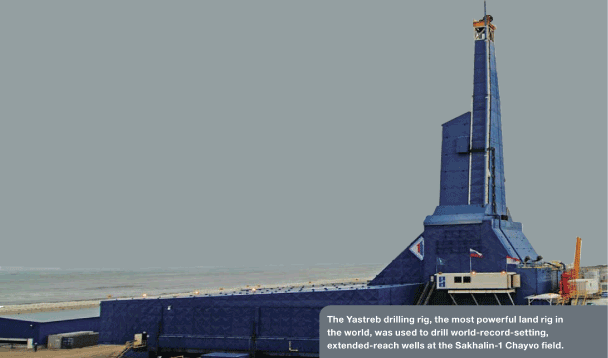
32 EXXON MOBIL CORPORATION§ 2006 FINANCIAL & OPERATING REVIEW
PROJECT TECHNOLOGY, EXPERIENCE, AND EXECUTION
ExxonMobil applies a suite of proprietary technologies and project execution expertise to successfully develop challenging resources on-time and on-budget.
A History of LNG Leadership
ExxonMobil has been involved in the development of Liquefied Natural Gas (LNG) projects for over 35 years. We have consistently delivered performance and technology step-outs that have enabled LNG to be a vital part of today’s global energy supply. Highlights of ExxonMobil’s leadership include:
| | | |
1970 | | First application of spiral-wound heat exchanger at Marsa EI-Brega, Libya |
| | | |
1978 | | First of three PT Arun trains in Indonesia |
| | | |
1983 | | Major expansion of PT Arun trains |
| | | |
1999 | | First 3.3 MTA train: Ras Laffan Train 1 in Qatar |
| | | |
2004 | | First 4.7 MTA train: Ras Laffan Train 3 in Qatar |
| | | |
2007 | | First delivery of over 210,000 cubic meter capacity Q-Flex LNG vessel, over 40 percent more cargo capacity |
| | | |
2008 | | Start-up of first 7.8 MTA train: Qatargas II Train 4 First delivery of 260,000 cubic meter capacity Q-Max LNG vessel |
| | | |
| | | Start-up of Adriatic LNG terminal (first gravity base offshore LNG terminal) |
Superior Execution Performance
In November 2006 Ras Laffan Liquefied Natural Gas Company II, a joint venture with Qatar Petroleum, started up Train 5, the third of the world-scale 4.7-million-tons-per-year LNG trains. The offshore facilities that produce the feed gas to the train came onstream in January 2007. These milestones highlight the benefits of our “design one, build multiple” strategy. In a difficult contracting market environment, Train 5 started up just 29 months after the major engineering/construction contract award and was completed 6 percent under budget. This strategy is being extended to the next generation of 7.8-million-tons-per-year liquefaction trains with plans for starting up all four trains within an 18-month period beginning in 2008.
The next-generation trains will be supported by a fleet of LNG ships with capacities up to 80 percent greater than those commonly in use today. The new ships will incorporate the most efficient propulsion and cargo boil-off handling systems in the industry. With the use of common ship designs to optimize construction and maximize purchasing leverage, the massive acquisition program of 41 ships by 2009 provides significant savings. This integrated approach that improves the economies of scale of LNG production and shipping extends the global reach and competitiveness of Qatar LNG.
Tight Gas Completion Technology
Worldwide, enormous quantities of natural gas are locked up in “tight” reservoirs that are characterized by low flow rates and are not commercially robust with standard completion methods. In the Piceance Basin of western Colorado, where ExxonMobil holds a large position of nearly 300,000 acres, we are employing our patented Multi-Zone Stimulation Technology (MZST) to rapidly create numerous fractures in the reservoir rock so that gas can flow more easily to the wellbore. Compared to conventional approaches, MZST provides a material improvement in our ability to quickly generate many high-quality fractures. This technological advance and operational experience provide us with the means to pursue this challenging resource type elsewhere around the globe.
EXXON MOBIL CORPORATION§ 2006 FINANCIAL & OPERATING REVIEW 33
Arctic
The Arctic is a large, lightly explored region with significant hydrocarbon potential. However, exploration in this region holds a broad range of technical and commercial challenges. With our experience operating in arctic conditions, ExxonMobil is prepared to pursue this potential and to address these challenges.
ExxonMobil’s arctic experience began in 1933, with the first commercial oil field at Norman Wells in northern Canada. Since then, ExxonMobil has produced almost 3.5 billion oil-equivalent barrels from fields located in arctic regions. Today, ExxonMobil has more than 7 billion oil-equivalent barrels of recoverable resources in arctic environments.
Cost-effective and environmentally safe development of arctic resources requires innovative technology. Offshore platforms must be designed to withstand ice loading, icebergs, and severe arctic storms. Transportation of hydrocarbons may require ice-breaking tankers and terminals capable of year-round operation in severe weather conditions. Subsea pipelines must be buried below the seafloor to avoid damage due to ice scour. Onshore pipelines must be designed to withstand the strain of frost heave and thaw settlement in areas of discontinuous permafrost, while minimizing the impact on the environment.
With a strong focus on technology and upstream research and development, ExxonMobil remains at the forefront of arctic technology, and is well-positioned to take on the challenges of these significant opportunities.
NAFPac Completion Technology
ExxonMobil is a leader in developing and applying innovative technology that delivers best-in-class completions. One example is the Non-Aqueous Fluid Pack (NAFPac) completion technology developed and first used in the deepwater Angola Kizomba Project. This ExxonMobil patent-pending technology minimizes wellbore contact with water-based completion fluids that often results in wellbore instability and operational downtime.
When combined with our patentedAlternate Pathtechnology, NAFPac delivers 100 percent gravel placement to the completion, preventing sand production and maximizing production for the life of the field. The end result is installation of a superior completion with reliable sand control and maximized production at low cost.
34 EXXON MOBIL CORPORATION§ 2006 FINANCIAL & OPERATING REVIEW
Major Development Projects
ExxonMobil participated in seven major project start-ups in 2006, with seven more anticipated in 2007. Beyond 2007, an additional 50 major projects are in various stages of project planning and execution. Including minor projects, the total number of projects in the portfolio exceeds 110.
2006 PROJECT START-UPS
Erha/Erha North- The Erha and Erha North projects in deepwater offshore Nigeria commenced production in March 2006 and September 2006, respectively. Erha North was brought on production within 30 months of discovery, setting a Nigeria deepwater record. Production at year end was more than 200 thousand barrels of oil per day (gross).
Dalia- The Dalia project includes a 2-million-barrel floating production, storage, and offloading (FPSO) vessel to recover nearly 1 billion barrels of oil (gross) from the Dalia field, offshore Angola in Block 17. First oil was achieved in December 2006, with production ramping up to an anticipated 225 thousand barrels of oil per day (gross) peak rate during 2007.
East Area Additional Oil Recovery (AOR) - The AOR project increases oil recovery and minimizes gas flaring from six Nigeria joint-venture producing fields by gathering the produced gas and re-injecting it into the reservoir. The project is expected to provide incremental recovery of approximately 560 million oil-equivalent barrels (gross) and a peak production increase of 120 thousand barrels of oil per day (gross).
Guntong Hub- ExxonMobil’s Malaysian affiliate started up the Guntong E platform in June 2006. The platform is the first phase of the Guntong Hub development, which is anticipated to produce and process a total of over 4 trillion cubic feet of gas for sale in Peninsular Malaysia to help meet the country’s increasing gas demand. The Guntong E platform was completed 13 percent under budget.
Azeri-Chirag-Gunashli- Phase 2 of the multiphase Azeri-Chirag-Gunashli development in Azerbaijan started up ahead of schedule during 2006. This project develops the west and east ends of the Azeri field from two additional platforms which came onstream in January and November respectively. Phase 2 oil production is expected to exceed 450 thousand barrels per day (gross) in 2010 and recover estimated resources of 2.3 billion oil-equivalent barrels (gross).
EXXON MOBIL CORPORATION§ 2006 FINANCIAL & OPERATING REVIEW 35
Fram East- The Fram East project in Norway develops 60 million barrels of oil and 70 billion cubic feet of gas (gross). The project is the second phase of the field development following Fram West, which started up in 2003. The project scope includes seven subsea wells tied-back to the Troll C platform. Production started up as planned in October 2006.
Syncrude Upgrader- The Syncrude Upgrader Expansion project consists of adding a second train at the Aurora oil sands mine in Alberta, Canada, and increasing capacity of the upgrader by 100 thousand barrels of synthetic crude oil per day (gross). The upgrader expansion includes the addition of a third coker, a new aromatic saturation unit, and a new hydrogen plant. The project develops 920 million barrels (gross) and started up in May 2006.
Sakhalin-1
Following initial production in 2005, the Chayvo Onshore Processing Facility and export facilities, including the DeKastri terminal, were started up in 2006. Production increased from 50 thousand to over 200 thousand barrels per day (gross) by year end, reaching the peak rate of 250 thousand barrels per day in February 2007.
MAJOR PROJECT START - UPS
| | | | | | | | | | | | | | | | | |
| | | ExxonMobil | | | Target Peak | | | | | |
| | | Working | | | Production (Gross) | | | | | |
| | | Interest | | | Liquids | | | Gas | | | | | |
| | | (%) | | | (KBD) | | | (MCFD) | | | | | |
2006(Actual) | | | | | | | | | | | | | | | | |
| Angola— Dalia | | | 20 | | | | 225 | | | | — | | | | l | |
| Azerbaijan — Azeri—Chirag—Gunashli (ACG)Phase 2 | | | 8 | | | | 465 | | | | — | | | | l | |
| Canada — Syncrude Upgrader Expansion | | | 25 | | | | 100 | | | | — | | | | l | |
| Malaysia — Guntong Hub | | | 50 | | | | 35 | | | | 715 | | | | n | |
| Nigeria — East Area Additional Oil Recovery | | | 40 | | | | 120 | | | | — | | | | n | |
| Nigeria — Erha/Erha North | | | 56 | | | | 200 | | | | — | | | | n | |
| Norway — Fram East | | | 25 | | | | 45 | | | | 45 | | | | l | |
| | | | | | | | | | | | | | | | | |
2007(Projected) | | | | | | | | | | | | | | | | |
| Angola — Marimba North | | | 40 | | | | 40 | | | | — | | | | n | |
| Angola — Rosa | | | 20 | | | | 140 | | | | — | | | | l | |
| Netherlands — Waddenzee | | | 40 | | | | — | | | | 195 | | | | l | |
| Norway — Ormen Lange | | | 7 | | | | 35 | | | | 2385 | | | | l | |
| Norway — Statfjord Late Life | | | 21 | | | | 70 | | | | 360 | | | | l | |
| Norway —Volve | | | 30 | | | | 55 | | | | 15 | | | | l | |
| Qatar — RasGas Train 5 | | | 30 | | | | 45 | | | | 740 | | | | Ù | |
| | | | | | | | | | | | | | | | | |
2008—2009(Projected) | | | | | | | | | | | | | | | | |
| Angola — Kizomba C — Mondo | | | 40 | | | | 100 | | | | — | | | | n | |
| Angola — Kizomba C — Saxi/Batuque | | | 40 | | | | 100 | | | | — | | | | n | |
| Azerbaijan — ACG Phase 3 | | | 8 | | | | 260 | | | | — | | | | l | |
| Italy — Adriatic LNG Terminal | | | 45 | | | | — | | | | — | | | | Ù | |
| Kazakhstan — Tengiz Phase 1 | | | 25 | | | | 285 | | | | 290 | | | | l | |
| Malaysia — Jerneh B | | | 100 | | | | — | | | | 150 | | | | n | |
| Nigeria — East Area Natural Gas Liquids II | | | 51 | | | | 40 | | | | — | | | | n | |
| Norway — Tyrihans | | | 12 | | | | 85 | | | | 330 | | | | l | |
| Qatar — Al Khaleej Gas Phase 2 | | | 80 | * | | | 70 | | | | 1250 | | | | n | |
| Qatar — Qatargas II Train 4 | | | 30 | | | | 80 | | | | 1250 | | | | Ù | |
| Qatar — Qatargas II Train 5 | | | 18 | | | | 80 | | | | 1250 | | | | Ù | |
| Qatar — RasGas Train 6 | | | 30 | | | | 75 | | | | 1250 | | | | Ù | |
| Qatar— RasGas Train 7 | | | 30 | | | | 75 | | | | 1250 | | | | Ù | |
| U.K. — South Hook LNG Terminal | | | 24 | | | | — | | | | — | | | | Ù | |
| U.K. — Starling | | | 72 | | | | 5 | | | | 120 | | | | l | |
| U.S. — Golden Pass LNG Terminal | | | 20 | | | | — | | | | — | | | | Ù | |
| U.S. — Piceance Gas (Phase 1) | | | 100 | | | | — | | | | 200 | | | | n | |
| U.S. — Thunder Horse | | | 25 | | | | 210 | | | | 185 | | | | l | |
| | | | | | | | | | | | | | | | | |
2010+(Projected) | | | | | | | | | | | | | | | | |
| Angola — Kizomba Satellites | | | 40 | | | | 125 | | | | — | | | | n | |
| Angola — Cravo—Lirio—Orquidea—Violeta (CLOV) | | | 20 | | | | 150 | | | | — | | | | l | |
| Angola — Plutao—Satumo—Venus—Marte (PSVM) | | | 25 | | | | 150 | | | | — | | | | l | |
| Angola— Pazflor | | | 20 | | | | 220 | | | | — | | | | l | |
| Angola — Gindungo—Canela—Gengibre (GCG) | | | 15 | | | | 120 | | | | — | | | | l | |
| Australia — Greater Gorgon Trains 1 & 2 | | | 25 | | | | 10 | | | | 1575 | | | | l | |
| Australia— Kipper /Tuna | | | 41 | | | | 20 | | | | 150 | | | | n | |
| Australia — Scarborough | | | 50 | | | | — | | | | 965 | | | | n | |
| Canada — Hebron | | | 38 | | | | 140 | | | | — | | | | l | |
| Canada — Kearl Phase 1 | | | 100 | | | | 100 | | | | — | | | | n | |
| Canada — Kearl (Future Phases) | | | 100 | | | | 200 | | | | — | | | | n | |
| Canada — Mackenzie Gas Project | | | 56 | | | | 10 | | | | 830 | | | | n | |
| Indonesia— Banyu Urip | | | 45 | | | | 165 | | | | 20 | | | | n | |
| Indonesia— Natuna | | | 76 | | | | — | | | | 1100 | | | | n | |
| Italy — Tempa Rossa | | | 25 | | | | 50 | | | | 20 | | | | l | |
| Kazakhstan — Kashagan Phase 1 | | | 19 | | | | 450 | | | | — | | | | l | |
| Kazakhstan — Kashagan (Future Phases) | | | 19 | | | | 1000 | | | | — | | | | l | |
| Kazakhstan — Tengiz Expansion | | | 25 | | | | 260 | | | | — | | | | l | |
| Nigeria — Bonga North & Northwest | | | 20 | | | | 150 | | | | 80 | | | | l | |
| Nigeria — Bonga SW | | | 16 | | | | 140 | | | | 105 | | | | l | |
| Nigeria— Bosi | | | 56 | | | | 135 | | | | — | | | | n | |
| Nigeria —LNG IPP Upstream | | | 40 | | | | — | | | | 700 | | | | n | |
| Nigeria — Satellite Projects | | | 40 | | | | 125 | | | | — | | | | n | |
| Nigeria — Usan | | | 30 | | | | 150 | | | | — | | | | l | |
| Norway — Skarv/ldun** | | | 12 | * | | | 85 | | | | 500 | | | | l | |
| Papua New Guinea — PNG Gas | | | 26 | | | | 20 | | | | 570 | | | | n | |
| Qatar — Barzan Phase 1 | | | 10 | * | | | 135 | | | | 1500 | | | | Ù | |
| Russia — Sakhalin—1 Future Phases | | | 30 | | | | — | | | | 800 | | | | n | |
| U.K. —Fram | | | 72 | | | | 5 | | | | 70 | | | | l | |
| U.S. — Alaska Gas/Pt. Thomson | | | 36 | | | | 70 | | | | 4500 | | | | * | |
| U.S. — Piceance Gas (Future Phases) | | | 100 | | | | 10 | | | | 870 | | | | n | |
| U.S. — Prudhoe Bay Western Region | | | 36 | | | | 50 | | | | — | | | | l | |
Operatorship:
n = ExxonMobil Operated
Ù = Joint Operation
l = Co—Venturer Operated
* Pending Final Agreements
** Divestment Pending
— Not Applicable
36 EXXON MOBIL CORPORATION§ 2006 FINANCIAL & OPERATING REVIEW
Maximize Profitability of Existing Oil and Gas Production
We accomplish this strategy by applying the most cost-effective technology and operations management systems to each and every asset to maximize the commercial recovery of hydrocarbons.
ExxonMobil’s asset base is robust in a range of economic environments and strengthened by its diversity. In addition to being geographically diverse, the production base consists of both mature fields and fields that are early in their producing life.
ExxonMobil places significant emphasis on managing underlying base performance and generating opportunities to maximize the value of our assets. Our high-quality reservoir management and rigorous depletion planning enhance the long-term performance of each field. We continually invest in the existing asset base to increase resource recovery, maximize profitability, and extend field life. New production volumes are generated through implementing projects, drilling new wells, and working over existing wells. Some assets may have characteristics favorable for enhanced oil recovery, a technology in which ExxonMobil is a recognized industry leader.
All of these activities are performed with a structured focus on cost management and capital discipline. A commitment to excellence in operations ensures operations integrity and maximum production uptime. In addition, our asset base is continuously under review. In some cases, the greatest value is created through divestment.
As with other functional areas, ExxonMobil employs a global organization to manage existing oil and gas assets. With this structure, we are able to leverage the transfer of technology and best practices across our global portfolio and to implement the systems and processes needed to consistently ensure operational excellence. We establish priorities on a global basis and deploy the people with the right skills when and where they are needed. ExxonMobil has an experienced, dedicated, and diverse workforce of exceptional quality.
Our Upstream business consistently captures more earnings per barrel than our competitors. This is a reflection of our investment discipline and commitment to superior execution.
| | |
| (1) Royal Dutch Shell, BP, and Chevron values calculated on a consistent basis with ExxonMobil, based on public information. |
| | | |
| | EQUIPMENT STRATEGIES
INTEGRITY PROGRAMS
MEASUREMENT & REPORTING
EXECUTION
ISSUES STEWARDSHIP |
Focus on Operations Integrity
Operations integrity is fundamental to our success and is a top priority. Under the umbrella of the Operations Integrity Management System (OIMS), our integrity management processes address all aspects of our business and define our global standards for safe and environmentally sound operations. For example, our Facility Integrity Management System (FIMS) ensures that critical equipment is proactively inspected and maintained throughout its lifecycle.
With FIMS, we have globally deployed integrity guidelines specifying minimum standards for testing, monitoring, inspection, and maintenance for 250 classes of equipment used in our operations. We have implemented management processes to ensure that integrity programs are carried out, results are reported, and corrective action taken when necessary. We monitor the status of our facility integrity on a global basis to ensure compliance and direct resources to priority areas. Our objective is to reduce incidents by pre-empting equipment failure, which translates into better safety performance, higher production reliability, and lower cost.
EXXON MOBIL CORPORATION§ 2006 FINANCIAL & OPERATING REVIEW 37
PRODUCTION VOLUMES
In 2006 total liquids production was 2.7 million barrels per day. Natural gas production available for sale totaled 9.3 billion cubic feet per day. New projects and work programs more than offset declines in existing fields. Additionally, ExxonMobil was awarded a 28-percent working interest in the Upper Zakum field in Abu Dhabi effective January 2006, which added 147 thousand barrels per day of oil production. In total, 2006 production was 4 percent higher than 2005.
Near-term growth in production capacity is expected to be led by key liquids projects offshore West Africa, Russia, and the Caspian, and from gas project activities in Qatar. Production from North America and Europe is expected to continue to provide a strong, profitable base underpinning our growth.
Timing of individual project start-ups could have a material impact on the production outlook. While the outlook reflects our best assumptions on project timing, projects will be funded and executed only when they have achieved a level of maturity that provides adequate confidence of robust performance in a wide range of economic conditions.
Other factors impacting year-to-year production volumes include operational outages, reservoir performance, regulatory changes, asset sales, severe weather events, and price effects under production sharing contracts.
OPTIMIZATION OF EXISTING-FIELD PRODUCTION
ExxonMobil employs many systems and processes to ensure maximum profitable production from existing assets.
A key component to optimizing base volumes is our focus on improving production uptime. This is managed through reliability improvement activities, rigorous shutdown planning, and disciplined root-cause analysis of downtime events.
Reservoir surveillance and well maintenance programs are designed to enhance production from existing wells. Global processes, such as asset development and depletion, and reservoir management best practices, are leveraged to ensure every asset is optimized. Additional drilling, workovers, and secondary or tertiary recovery projects are implemented to access and develop resources not captured during initial development.
Minor projects are developed for field extensions, for additional reservoirs identified during a field’s initial development, and for infrastructure changes (e.g., compression and low pressure operations) necessary to deplete a field’s reserves.
Enhanced oil recovery (EOR)/Improved oil recovery (IOR) activity includes using water or gas injection, heavy-oil steam flooding, or sour-gas injection techniques to increase reservoir recovery.
| Production Volume Outlooks |
| Shown below are production volume outlooks through 2011 for liquids and gas (by geographic region) and oil-equivalent barrels (by activity). |
38 EXXON MOBIL CORPORATION§ 2006 FINANCIAL & OPERATING REVIEW
Capitalize on Growing Natural Gas and Power Markets
Global reach is a key competitive advantage of the ExxonMobil natural gas business. We have employees dedicated to sales and market development in almost all major and developing markets. ExxonMobil markets 11.2 billion cubic feet per day of natural gas in 28 countries to a wide variety of customers, including power companies, industrial users, and distributors. Additionally, we manage over 1 million barrels per day of natural gas liquids and significant production of power and helium.
A major strength is our ability to integrate our Upstream, Downstream, and Chemical businesses, allowing us to maximize value for our gas, natural gas liquids, and power.
NORTH AMERICAN GAS MARKET
With North America gas demand likely to grow about 0.5 percent per year on average to 2030, and domestic supply from existing wells declining, continued investments in existing fields and new discoveries are required. ExxonMobil is expanding development of tight gas in the Piceance Basin in Colorado, and plans to initiate production from the Barnett Shale near Dallas in 2007. The company has a leading position in arctic gas resources in the Mackenzie Delta region of northern Canada and on the North Slope of Alaska.
LNG imports are forecast to play an increasingly important role in the North American market. ExxonMobil is participating in a joint venture constructing the Golden Pass regasification terminal along the U.S. Gulf Coast, with a planned capacity of 2 billion cubic feet per day.
ExxonMobil has extensive experience in the North American gas market. This market understanding underpins our straightforward business model of continually optimizing our sales into the best available market. As in all other regional gas markets, we do not trade speculatively in any gas futures.
EUROPEAN GAS MARKET
European gas demand is expected to grow at about 1.5 percent per year through 2030, while regional production of natural gas is anticipated to begin declining in the next several years. This growing gap between demand and local production will result in a rapid increase in the need for imported gas supplies from new LNG and pipeline projects.
ExxonMobil has a significant existing production, infrastructure, and marketing asset base in Europe. In addition, the company’s recent European gas business restructuring and its participation in the development of new gas supplies and infrastructure have strategically positioned ExxonMobil to help meet Europe’s growing demand for natural gas.
The company is involved in multiple field developments in the North Sea, including the Ormen Lange and Statfjord Late Life projects. ExxonMobil holds capacity in the new Langeled pipeline from Norway to the United Kingdom, and the company’s joint venture in the Netherlands, GasTerra, holds capacity in the BBL pipeline from the Netherlands to the U.K. Both pipelines started commercial operations in 2006 and provide additional gas import capacity to the U.K. To meet the growing demand for LNG in Europe, ExxonMobil and its partners are constructing the South Hook LNG Terminal in Milford Haven, U.K., and the offshore Adriatic LNG Terminal in Italy.
EXXON MOBIL CORPORATION§ 2006 FINANCIAL & OPERATING REVIEW 39
ASIA PACIFIC / MIDDLE EAST GAS MARKET
Asia Pacific gas demand continues to grow faster than any other region of the world at about 3.7 percent per year, driven by the developing economies of Asia. While local production also grows, faster demand growth will lead to requirements for 35 billion cubic feet per day of pipeline and LNG imports by 2030.
With over 35 years of gas experience in Asia Pacific, ExxonMobil is among the largest suppliers in local markets of Australia and Malaysia, and also participates in local supplies to markets in Thailand, Indonesia, Japan, and far east Russia. In addition, ExxonMobil participates in LNG operations in Indonesia and Qatar that are major exporters to Japan, South Korea, India, and Taiwan.
Gas demand in the Middle East is projected to grow strongly at 2.9 percent per year through 2030. ExxonMobil supplies pipeline gas to local industries in Qatar through its participation in Al Khaleej Gas, which began operation in 2005.
ExxonMobil is progressing additional opportunities in the Middle East, Australia, Indonesia, Russia, and Papua New Guinea to provide new LNG and pipeline supplies for Asia Pacific and Middle East markets.
POWER ACTIVITIES
ExxonMobil has interests in electric power generation facilities with total capacity of over 15,600 megawatts. These interests include the Castle Peak Power Company, which sells electricity in Hong Kong. In 2006 Castle Peak Power Company completed an expansion of the Black Point power station, adding 625 megawatts of gas-fired combined-cycle capacity. Also, ExxonMobil is an industry leader in the application of energy-efficient cogeneration technology, with interests in more than 4300 megawatts of cogeneration capacity that is used primarily to supply our own power and steam demands. ExxonMobil is developing additional gross cogeneration capacity of over 850 megawatts at our facilities in Europe and Asia.
LNG Market
Global LNG demand is expected to grow at more than 5 percent per year through 2030, driven by demand in North America and Europe as well as Asia Pacific markets. By 2030 LNG demand is expected to exceed 500 million tons per year, representing about 16 percent of the world’s gas demand.
ExxonMobil is currently participating in LNG operations in Qatar and Indonesia with a combined gross capacity of 35 million tons per year, supplying LNG to markets in Asia, Europe, and North America. Construction is progressing in Qatar for four additional LNG trains that will increase gross capacity by over 30 million tons per year. In addition, ExxonMobil is progressing LNG opportunities that include additional trains in Asia Pacific and West Africa. By 2015 we expect to be participating in gross LNG sales exceeding 65 million tons per year, with significant volumes being placed in growing markets of North America, Europe, and Asia Pacific.
ExxonMobil is also participating, in partnership with Qatar Petroleum and others, in the construction of LNG terminals on the U.S. Gulf Coast; Milford Haven, United Kingdom; and offshore the northern Adriatic coast of Italy. In addition, ExxonMobil and Qatar Petroleum retain capacity rights in the Fluxys Zeebrugge terminal in Belgium. Castle Peak Power Company, an ExxonMobil joint venture with China Light and Power, is progressing an onshore terminal in Hong Kong for proposed LNG imports. ExxonMobil participates in the Shimizu terminal in Japan that is currently being expanded.
| | |
| | | (1) Includes joint-venture interests |
40 EXXON MOBIL CORPORATION§ 2006 FINANCIAL & OPERATING REVIEW
Worldwide Upstream Operations
ExxonMobil has interests in exploration and production acreage in 35 countries and production operations in 25 countries.
The Americas
ExxonMobil’s operations in the Americas accounted for about 28 percent of ExxonMobil’s 2006 net oil and gas production and about 34 percent of Upstream earnings. Base production continues to yield strong returns. We expect future production to include contributions from multiple opportunities, including tight gas, heavy oil, and arctic developments.
AMERICAS HIGHLIGHTS
| | | | | | | | | | | | | |
| | | 2006 | | 2005 | | 2004 |
Earnings(billions of dollars) | | | 8.9 | | | | 9.5 | | | | 7.1 | |
Proved Reserves(1)(BOEB) | | | 6.2 | | | | 6.9 | | | | 7.4 | |
Acreage(gross acres, million) | | | 56.4 | | | | 62.9 | | | | 64.6 | |
Net Liquids Production(MBD) | | | 0.8 | | | | 0.9 | | | | 1.0 | |
Net Gas Available for Sale(BCFD) | | | 2.5 | | | | 2.8 | | | | 3.0 | |
| | |
| (1) See Frequently Used Terms on pages 88 through 91. |
UNITED STATES
ExxonMobil is one of the largest oil and gas producers and reserves holders in the United States. The Corporation’s large portfolio is geographically diverse with significant positions in all major producing regions, including Alaska, the Gulf Coast, both the shelf and deepwater areas of the Gulf of Mexico, onshore and offshore California, and the mid-continent. The U.S. portfolio contains a diverse range of assets, from mature fields to new, world-scale projects.
In the United States, the Upstream continues to provide a significant contribution to ExxonMobil’s profitability through high-quality drilling programs, selective investments in existing fields and new projects, and continued operational-efficiency improvements. United States properties accounted for about 16 percent of the company’s net oil and gas production in 2006, and 20 percent of Upstream earnings.
Highlights in 2006 include continued development of the Piceance Basin tight gas resource, an expanded position in the Barnett Shale in the Fort Worth Basin, completion of repairs to Gulf of Mexico facilities damaged by hurricanes Katrina and Rita, and completion of the longest reach drillwell in North America offshore California. Work continued towards securing an appropriate fiscal framework for the Alaska Gas Project. Piceance Basin development and the Alaska Gas Project will continue to be key focus areas in the United States.
Coal- ExxonMobil operates the Monterey coal mine (ExxonMobil interest, 100 percent) in Illinois, which produced 2.5 million metric tons (gross) in 2006.
Piceance Basin
With nearly 300,000 gross acres under lease with a potential recoverable resource of nearly 35 trillion cubic feet of gas, ExxonMobil has a strong position in the Piceance Basin. Through the use of proprietary, state-of-the-art Multi-Zone Stimulation Technology and the cutting-edge Fast Drill Process, ExxonMobil continues to maximize recovery and per-well production rates while reducing development costs and the environmental footprint.
ExxonMobil is taking a phased approach, with projects currently under way to significantly increase ExxonMobil’s current field production of 55 million cubic feet per day (gross) over the next few years. Production will be increased through expansion of the existing gathering system, additional drilling, and third-party installation of new gas processing capacity. Opportunities for additional projects to fully develop the resource potential and increase production well into the next decade are under evaluation.
EXXON MOBIL CORPORATION§ 2006 FINANCIAL & OPERATING REVIEW 41
The Gulf of Mexico
ExxonMobil has about 3.3 million acres (gross) under lease in the Gulf of Mexico, approximately 2.4 million of which are in deep water. This acreage position includes interests in two highly active industry plays, the ultra-deepwater fold belt and deep gas targets underlying the Louisiana shelf.
In 2006 ExxonMobil completed drilling of the ultra-high pressure and temperature Blackbeard wildcat on the Gulf of Mexico shelf to a record depth of 30,067 feet. The impact of this well on other deep gas opportunities is under evaluation. ExxonMobil also has several Lower Tertiary prospects in the ultra-deepwater foldbelt.
Santa Ynez Unit
ExxonMobil’s Santa Ynez Unit consists of three offshore platforms in the Pacific Ocean’s Outer Continental Shelf producing to an oil and gas processing facility in Las Flores Canyon, about 20 miles northwest of Santa Barbara, California. Electricity to power all these facilities is provided by an energy-efficient cogeneration system. ExxonMobil has maintained safe, reliable, and environmentally sound operations in this area for over 25 years, and recently has applied state-of-the-art extended-reach drilling technology to access resources located more than five miles from the offshore platforms.
Golden Pass
The Golden Pass LNG Terminal, currently under construction at Sabine Pass, Texas, will supply natural gas to the United States by regasifying LNG received from the Qatar joint ventures. The terminal is scheduled to open in 2009, with two berths for large LNG ships, five storage tanks, and regasification facilities to support an ultimate capacity of 2 billion cubic feet of gas per day.
Prudhoe Bay Western Region Development
ExxonMobil is actively involved in developing Alaska North Slope satellite fields that produce to existing Prudhoe Bay infrastructure. Currently 10 percent of the Prudhoe Bay production is from satellite fields such as Borealis, Aurora, and Midnight Sun. Efforts continued in 2006 with development activities for the Orion field, which will add 100 wells and require an expansion of the Prudhoe Bay facilities.
42 EXXON MOBIL CORPORATION§ 2006 FINANCIAL & OPERATING REVIEW
Alaska Gas Development
ExxonMobil is the largest holder of gas resources on the North Slope of Alaska. The Alaska Gas Project will enable treatment and transportation of gas from the Prudhoe Bay and Point Thomson fields to North American gas markets. In 2006 work continued towards securing an appropriate fiscal framework with the State of Alaska. Once that framework is established, project planning will progress, leading to further engineering and the securing of permits. Execution of this world-scale development is expected to take approximately 10 years once a fiscal framework is defined.
Mackenzie Gas Project
Regulatory hearings and negotiations with key stakeholders continue to progress on the Mackenzie Gas Project. The project includes the development of three onshore anchor fields containing approximately 6 trillion cubic feet of natural gas in the Mackenzie Delta region of northern Canada. ExxonMobil Canada, a wholly-owned affiliate, and Imperial Oil, a majority-owned affiliate, hold interests in two of the three fields. In addition to individual field development, the project includes a gas-gathering pipeline system, a gas processing plant with associated natural gas liquids line, and a 740-mile pipeline system to North American gas markets.
CANADA
ExxonMobil has a leading position in Canada through wholly-owned affiliate ExxonMobil Canada and majority-owned affiliate Imperial Oil (ExxonMobil interest, 69.6 percent). Through these entities, ExxonMobil is a leading crude oil and natural gas producer in Canada, and holds one of the largest resource positions. The company has a significant presence in major projects offshore eastern Canada and a well-established production base with expansion opportunities in western Canada.
Offshore Canada Operations —The ExxonMobil-operated Sable Offshore Energy Project (ExxonMobil interest, 51 percent; Imperial Oil interest, 9 percent) consists of five producing fields. Production in 2006 was approximately 349 million cubic feet per day of natural gas (gross) and 18 thousand barrels per day of liquids (gross).
The Hibernia field (ExxonMobil interest, 33 percent), is operated by Hibernia Management and Development Company Ltd., using ExxonMobil personnel and processes. In 2006 Hibernia’s production averaged 178 thousand barrels of oil per day (gross). During 2006 the Hibernia owners increased the resource estimate for the Hibernia field with successful delineation drilling in the southern portion of the field.
The co-venturer-operated Terra Nova development (ExxonMobil interest, 22 percent) produces about 110 thousand barrels of oil per day (gross). Located in 300 feet of water, Terra Nova consists of a unique, harsh-environment-equipped FPSO and 24 subsea wells that are expected to recover 380 million oil-equivalent barrels (gross). In 2006 the Terra Nova FPSO underwent a maintenance turnaround during which additional living quarters were added. This investment will improve future inspection and preventive maintenance programs.
ExxonMobil has interest in four operated and four co-venturer-operated deepwater exploration blocks in the Orphan Basin (ExxonMobil interest, 15 percent; Imperial Oil interest, 15 percent), a high-potential, unexplored basin with arctic conditions offshore eastern Canada. The first wildcat in the Orphan Basin was initiated in August 2006.
Hibernia
The Hibernia Gravity Based Structure has been producing oil off the east coast of Canada since 1997. Over 60 wells, including 10 original delineation wells, have been drilled into this reservoir. Plateau production in 2004 was 210 thousand barrels per day, with 2006 production averaging 178 thousand barrels per day. Leveraging reservoir connectivity analysis technology developed at ExxonMobil’s Upstream Research Company, the production team discovered a significant down-dip extension to the existing development. This additional Hibernia oil accumulation was discovered below previously encountered oil-water contacts in the reservoir, and will extend field life.
EXXON MOBIL CORPORATION§ 2006 FINANCIAL & OPERATING REVIEW 43
Cold Lake
After evaluation drilling and production pilot testing in the 1960s and 1970s, the first commercial production at Cold Lake began in 1985 with Phases 1 and 2. Original capacity was 25 thousand barrels per day. Since then, phased developments have been brought onstream as confidence in recovery rates has grown. Record daily production of more than 160 thousand barrels per day (gross) was achieved in 2006. The recovery factor has increased from 13 percent to greater than 30 percent as a direct result of our continued focus on research and technology development and our industry-leading expertise in thermal operations. Development of additional field areas continues, and technological advances continue to positively impact recovery rates.
COLD LAKE AVERAGE PRODUCTION GROWTH
(gross production in thousands of barrels per day)
Onshore Canada Operations —The Cold Lake field (Imperial Oil interest, 100 percent) and the Syncrude oil sands mining operation (Imperial Oil interest, 25 percent) in Alberta account for the majority of Imperial Oil’s liquids production in western Canada. Cold Lake averaged 152 thousand barrels of oil per day in 2006, and at Syncrude, 2006 production of synthetic crude averaged 258 thousand barrels per day (gross). The Syncrude upgrader expansion project started up in 2006, and at year end was contributing an incremental 70 thousand barrels per day of synthetic crude. The Kearl oil sands mining project and the Mackenzie Gas Project are advancing.
Kearl Oil Sands Project
The Kearl oil sands project will develop a world-class heavy oil resource in northern Alberta in three phases. Each phase is expected to produce about 100 thousand barrels of bitumen per day (gross) from a resource exceeding 4 billion barrels (gross). Engineering design, execution planning, and cost estimate refinement for Phase 1 of the project are progressing. Regulatory hearings were completed and a regulatory decision is anticipated in 2007.
SOUTH AMERICA
Venezuela- ExxonMobil operates the Cerro Negro field (ExxonMobil interest, 42 percent) in Venezuela. During 2006, on average 115 thousand barrels of extra heavy oil produced daily (gross) were processed through an upgrader into synthetic crude oil. ExxonMobil also has a 50-percent interest in the 120,000-acre La Ceiba block on the southeastern shore of Lake Maracaibo. Following extended production testing at La Ceiba, a declaration of commerciality was made in 2005. Project partners have submitted the Field Development Plan for regulatory approval which is required prior to restart. The Government of Venezuela has indicated its intent to increase State participation in these projects.
Brazil- At year-end 2006, ExxonMobil held a 40-percent interest and operatorship of Block BM-S-22, located in the Santos Basin offshore Brazil. BM-S-22 is a 340,000-acre exploration block in water depths over 7400 feet. 3D seismic data over the BM-S-22 block were acquired in 2005 and processed in 2006. Wildcat well planning is under way.
Colombia- In 2006 ExxonMobil entered exploration Phase II in the Tayrona block (ExxonMobil interest, 40 percent), with water depths up to 10,500 feet off Colombia’s northern coast in the Caribbean Sea. Phase II required 50-percent relinquishment of the original 11 million acre block. Work activity consisted of acquisition and processing of 3360 square kilometers of 3D seismic data and 2000 line kilometers of 2D seismic reprocessing. Prospect maturation and drillwell planning are in progress.
Other South America- ExxonMobil holds a 51 -percent interest in the Chihuidos block in central Argentina and a 23-percent interest in the Aguarague concession in northwestern Argentina. Net daily gas production of 73 million cubic feet is sold into markets in Argentina and central and northern Chile. In addition, the company holds exploration rights offshore Guyana.
44 EXXON MOBIL CORPORATION§2006 FINANCIAL & OPERATING REVIEW
Europe
ExxonMobil is the largest net producer of hydrocarbons in Europe. The company has upstream operations in the United Kingdom, Norway, the Netherlands, Germany, Ireland, and Italy. Extensive North Sea oil and natural gas production operations and significant onshore natural gas production are among the company’s key assets. ExxonMobil’s operations in Europe accounted for about 28 percent of the company’s 2006 net oil and gas production and about 25 percent of Upstream earnings.
EUROPE HIGHLIGHTS
| | | | | | | | | | | | | |
| | | 2006 | | | 2005 | | | 2004 | |
Earnings(billions of dollars) | | | 6.5 | | | | 6.9 | | | | 4.4 | |
Proved Reserves(1)(BOEB) | | | 3.9 | | | | 4.3 | | | | 4.7 | |
Acreage(gross acres, million) | | | 18.8 | | | | 20.1 | | | | 19.8 | |
Net Liquids Production(MBD) | | | 0.5 | | | | 0.5 | | | | 0.6 | |
Net Gas Available for Sale(BCFD) | | | 4.1 | | | | 4.3 | | | | 4.6 | |
| | |
| (1) | | See Frequently Used Terms on pages 88 through 91. |
CONTINENTAL EUROPE
ExxonMobil has significant gas holdings onshore in the Netherlands and Germany, and is the largest gas producer in both countries.
In the Netherlands, after receiving regulatory approval for exploration and gas production under carefully controlled conditions to ensure environmental integrity, the Waddenzee development project (ExxonMobil interest, 40 percent) is under way and expected to start up in early 2007.
In Germany, ExxonMobil increased gas capacity with the start-up of the Scholen/BBU compression project in 2006. ExxonMobil continues to develop new gas resources in Germany, drilling approximately 10 wells per year. The drilling portfolio covers wells in the Zechstein and Rotliegende horizons, as well as significant opportunities in tight carboniferous formations.
In southern Italy, the Tempa Rossa project (ExxonMobil interest, 25 percent) is expected to develop over 200 million oil-equivalent barrels (gross). Finalization of major commercial agreements was achieved in 2006, and planning for construction of the oil facilities and export pipeline is under way. Total investment is expected to be $700 million (gross).
ExxonMobil is developing two LNG terminals, in Italy and the United Kingdom, respectively, to serve European markets.
German Gas Production Operations
ExxonMobil is the largest producer in Germany with production in excess of 800 million net cubic feet of gas per day, mainly in the state of Lower Saxony.
About half of this gas production is sour, containing up to 36 percent hydrogen-sulfide. The sour gas is dehydrated at the well sites and then processed at the Grossenkneten or NEAG sulfur-recovery plants before flowing to customers through a network of sales gas pipelines. The company also operates a number of large compressor stations to maximize field depletion, including the Scholen/BBU compressor station, which started up in 2006.
NORTH SEA
The North Sea continues to be a strong producer for ExxonMobil. Activities continue in all sectors from execution of new greenfield projects to programs that maximize recovery in mature assets.
In the Norwegian sector of the northern North Sea, two major ExxonMobil-interest development projects are being progressed: the deepwater Ormen Lange project and Tyrihans. The 460-million-oil-equivalent-barrel (gross) Tyrihans project (ExxonMobil interest, 12 percent) will develop two fields with the well stream tied back to the co-venturer-operated Kristin platform for processing and export. Total investment is expected to be $2.2 billion (gross).
In the Norwegian sector of the central North Sea, the ExxonMobil-operated Ringhorne field (ExxonMobil interest, 100 percent) produced 73 thousand oil-equivalent barrels per day in 2006. The ExxonMobil-operated Ringhorne East oil field (ExxonMobil interest, 77 percent) started producing in 2006. In October 2006, the co-venturer-operated Fram East
EXXON MOBIL CORPORATION§2006 FINANCIAL & OPERATING REVIEW 45
field (ExxonMobil interest, 25 percent) started producing. Two additional major ExxonMobil-interest projects are under way in the Norwegian sector of the central North Sea: the Statfjord Late Life project and the Volve field development.
In December 2006, the co-venturer-operated Merganser field (ExxonMobil interest, 45 percent) in the U.K. sector of the central North Sea started producing. The project leverages capacity in existing infrastructure with processing taking place on the Shearwater platform (ExxonMobil interest, 45 percent). ExxonMobil continues to participate in the development of new resources to optimize capacity of the Shearwater infrastructure, with the Starling development under way.
In the southern North Sea, the ExxonMobil-operated Arthur field development was completed in 2006 and produced 44 million cubic feet of gas per day. In 2006 ExxonMobil participated in two project start-ups: Cutter in the United Kingdom (ExxonMobil interest, 49 percent) and K17 in the Netherlands (ExxonMobil interest, 30 percent). Both projects use an innovative monotower platform design to reduce resource development costs. Two additional projects are under way - Caravel in the United Kingdom (ExxonMobil interest, 29 percent) and L09 in the Netherlands (ExxonMobil interest, 25 percent).
Ormen Lange
The Ormen Lange project ($10 billion, gross) is designed to develop over 13 trillion cubic feet of gas (gross) from the Ormen Lange field. The gas will be transported by the world’s longest subsea export pipeline, approximately 750 miles, from a new processing plant at Nyhamna on the west coast of Norway via Sleipner in the North Sea, to Easington in the U.K. The Easington receiving facility began handling gas from Sleipner in October 2006 via the southern leg of the new export pipeline.
Adriatic LNG Terminal
The Adriatic LNG Terminal will be the world’s first offshore fixed storage and regasification LNG terminal. The terminal will be located off Italy’s northern Adriatic coastline, 9 miles offshore Porto Levante, and will supply the Italian gas market with LNG from RasGas Train 4 in Qatar beginning in 2008. The concrete gravity base structure (shown under construction) will contain two large LNG storage tanks (visible in sections on the transport ship) and be grounded on the seafloor. The facility will have the capacity to supply 775 million cubic feet of gas daily.
South Hook LNG Terminal
Construction is well advanced on the South Hook LNG receiving terminal in Milford Haven, Wales. The terminal is expected to be opened in the first half of 2008. The Qatargas II project will supply the terminal with LNG. This former ExxonMobil refinery site is being redeveloped for LNG storage and regasification with two berths capable of receiving large Q-Max LNG ships. The terminal will have the capacity to deliver up to 2 billion cubic feet of gas daily into the U.K. grid.
46 EXXON MOBIL CORPORATION§2006 FINANCIAL & OPERATING REVIEW
Africa
ExxonMobil is one of the largest oil and gas producers in Africa. ExxonMobil’s operations in Africa accounted for about 18 percent of the company’s 2006 net oil and gas production and 21 percent of Upstream earnings, with those percentages expected to increase as new projects begin producing.
The production base currently includes operations in Angola, Chad, Cameroon, Equatorial Guinea, and Nigeria. In addition to those countries, exploration activities are ongoing in Libya, Madagascar, the Republic of Congo, and the Nigeria-Sao Tome and Principe Joint Development Zone. ExxonMobil is also progressing LNG opportunities in the region. In deepwater areas offshore Africa, ExxonMobil holds interests in 22 blocks, totaling more than 24 million gross acres. ExxonMobil participated in 22 West Africa deepwater exploration wells during 2006.
AFRICA HIGHLIGHTS
| | | | | | | | | | | | | |
| | | 2006 | | | 2005 | | | 2004 | |
Earnings(billions of dollars) | | | 5.5 | | | | 3.7 | | | | 2.1 | |
Proved Reserves(1)(BOEB) | | | 2.4 | | | | 2.7 | | | | 2.8 | |
Acreage(gross acres, million) | | | 41.1 | | | | 50.8 | | | | 42.6 | |
Net Liquids Production(MBD) | | | 0.8 | | | | 0.7 | | | | 0.5 | |
Net Gas Available for Sale(BCFD) | | | – | | | | – | | | | – | |
| | |
| (1) | | See Frequently Used Terms on pages 88 through 91. |
ANGOLA
ExxonMobil has interests in four deepwater blocks that cover more than 3 million gross acres. The company and its co-venturers have announced a total of 51 discoveries in Angola, representing world-class development opportunities with a recoverable resource potential of nearly 13 billion oil-equivalent barrels (gross).
During 2006, ExxonMobil operations and participation in Angola produced an average of over 800 thousand barrels of oil per day (gross). Development drilling in current fields continues, and new development projects include Kizomba C in Angola Block 15 (ExxonMobil interest, 40 percent) and Dalia and Rosa in Angola Block 17 (ExxonMobil interest, 20 percent). Development projects for Block 31 (ExxonMobil interest, 25 percent) and Block 32 (ExxonMobil interest, 15 percent) are in the early stages of development.
CONGO
There have been three discoveries in the deepwater of the Outer Congo Basin blocks containing a total discovered resource of approximately 400 million oil-equivalent barrels (gross). One of the discoveries was made in 2006. The co-venturer groups are currently evaluating potential cluster development concepts. ExxonMobil has a 30-percent interest in Mer Tres Profonde Sud and a 40-percent interest in Mer Tres Profonde Nord.
EXECUTION EXCELLENCE
Another example of ExxonMobil’s project management skills delivering superior results is Angola FPSO development. ExxonMobil’s “design one, build multiple” concept accelerated start-up times for Kizomba A and Kizomba B, both of which had cycle times shorter than those on nearby blocks.
Consistently delivering on-time and on-budget distinguishes ExxonMobil from its competitors and makes us a partner of choice for host governments.
EXXON MOBIL CORPORATION§2006 FINANCIAL & OPERATING REVIEW 47
Angola Block 15
ExxonMobil was awarded Block 15 in 1994, and the first discovery was in 1998. To date, a total resource of 4.7 billion oil-equivalent barrels has been discovered on the block. First oil was produced in November 2003 from the Xikomba field, followed by Kizomba A in 2004. With the 2005 start-up of Kizomba B, combined daily production on the block averaged about 570 thousand barrels per day (gross) in 2006. Production plateaus will be maintained by phased development of subsea tie-backs of nearby discoveries on the block. The Marimba North field is the initial tie-back development to the Kizomba A infrastructure, with start-up scheduled for late 2007. Planning for the remaining discovered asset tie-backs is currently in progress. ExxonMobil operates with a 40-percent working interest.
Kizomba C
The Kizomba C project will include the fourth and fifth offshore production hubs on Angola Block 15 to develop the Mondo, Saxi, and Batuque fields. The development will include subsea completions tied back to two floating production, storage, and offloading (FPSO) vessels. Construction is under way on the two FPSOs and the associated subsea components. The development is expected to recover approximately 600 million barrels of oil (gross), with first oil anticipated in 2008.
Angola Block 31
ExxonMobil was awarded a 25-percent interest in Block 31 in 1999, and the first discovery was made in 2002. To date, there have been 13 announced discoveries with a total resource of approximately 2 billion oil-equivalent barrels on the block. The first development is expected to be the Plutao-Saturno-Venus-Marte (PSVM) hub in the northern part of the block. A single, 150-thousand-barrel-per-day FPSO is planned for the four fields, which have combined resources of 500 million barrels of oil (gross). The water depth ranges from 5900 to 6730 feet, the deepest water yet for a West Africa development project. Exploration drilling will continue through the middle of 2008. The planning for development of a second hub in the southeast part of the block is under way.
Angola Block 32
ExxonMobil was awarded a 15-percent interest in Block 32 in 1999, and the first discovery was made in 2003. To date, there have been six announced discoveries with a total resource of approximately 750 million oil-equivalent barrels on the block. The first development being planned is the Gindungo-Canela-Gengibre (GCG) hub in the central eastern part of the block. A single FPSO is planned for the three fields, which have combined resources of 300 million barrels of oil (gross). The water depth ranges from 4600 to 5900 feet. Exploration drilling on the block will continue through the first quarter of 2007.
48 EXXON MOBIL CORPORATION§2006 FINANCIAL & OPERATING REVIEW
NIGERIA
ExxonMobil is active in both shallow and deepwater acreage in Nigeria. In shallow water, ExxonMobil operates a Joint Venture with the Nigerian National Petroleum Corporation (ExxonMobil interest, 40 percent for crude and condensate; 51 percent for natural gas liquids) that covers over 800 thousand acres in five leases offshore southeastern Nigeria. In deep water, ExxonMobil has interests in nine blocks that include the Bonga, Bosi, Bolia, Erha, and Usan discoveries. In 2006 ExxonMobil operations and participation in offshore Nigeria produced an average of 1.1 million barrels of liquids per day (gross).
Nigeria Joint Venture — Shelf Development
In the Joint-Venture area, activities are continuing to develop additional resources and increase production capacity. Production growth will result from development drilling, satellite field developments, enhanced recovery projects, and a series of platform upgrades, which will improve facility integrity while increasing production capacity. The East Area Natural Gas Liquids and Satellite Field Development projects are under way.
Nigeria Joint Venture Area Developments
The Nigeria Joint Venture contains a large inventory of attractive opportunities comprised of a mix of currently undeveloped fields and infill developments. A four-rig drilling program is developing these opportunities, which include the Satellite Field Development and East Area Project.
The Satellite Field Development project targets 20 undeveloped oil fields and 15 infill platform opportunities with total recoverable resources exceeding 1 billion barrels of oil (gross). The project will progress in phases, completing two to four platforms per year. The first phase focuses on the Abang, Oyot, and Itut fields, which is expected to develop 65 million barrels of oil and 17 million barrels of natural gas liquids.
The East Area Project includes the Additional Oil Recovery (AOR) project and an expansion of natural gas liquids production (NGL II). The AOR project, which started up in June 2006, will increase oil recovery and minimize gas flaring from six joint-venture East Area producing fields. The project provides incremental recovery of approximately 560 million oil-equivalent barrels and production of 120 thousand barrels per day (gross).
The NGL II expansion adds an NGL recovery platform and other offshore infrastructure as well as expanding the Bonny fractionation facilities to recover 300 million barrels of natural gas liquids with start-up expected in 2008.
EXXON MOBIL CORPORATION§2006 FINANCIAL & OPERATING REVIEW 49
Nigeria Deepwater Development- Complementing the activity in the joint-venture area, development projects are realizing Nigeria’s deepwater potential. Following the start-up of co-venturer-operated Bonga in late 2005, the ExxonMobil-operated Erha/Erha North project started up in early 2006 with initial production rates exceeding expectations. Development planning continues for Usan in OPL 222 and Bosi in OML 133.
Erha/Erha North
Erha and Erha North are another demonstration of ExxonMobil’s global project execution capability and deepwater technology expertise. In addition, the development demonstrates ExxonMobil’s continued commitment to support Nigeria in meeting national goals for local business development and construction capacity. The Erha and Erha North development include contract awards to several Nigerian companies for in-country fabrication, logistics support, and training and development for Nigerian employees. Activities included fabrication of subsea manifolds, drilling unit pilings, and FPSO modules such as the flare tower, pipe racks, riser protection frames, and the mooring buoy. Another example of helping to expand local business capacity and capability was the subsea system integration test. This test, the first performed in West Africa, ensured all subsea systems and controls worked properly prior to installation. It was conducted in Port Harcourt at a facility that can now serve as a regional center for future subsea component testing.
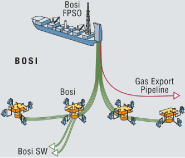
Bosi
The Bosi development will consist of a floating production, storage, and offloading vessel (FPSO) and subsea system that will become ExxonMobil’s deepest operated development to date (over 5500 feet water depth). The project will build on the successes of the recently completed Erha/Erha North project, and will continue to expand the capabilities and capacities of local Nigerian businesses. Development planning continues on Bosi, which is currently at the stage of concept selection and optimization. The Bosi development is expected to produce 135 thousand barrels of oil per day from the Bosi and Bosi Southwest fields.
EQUATORIAL GUINEA
ExxonMobil is the largest producer in Equatorial Guinea and operates two blocks that cover 670,000 acres (gross). The Zafiro field is in Block B (ExxonMobil interest, 71 percent) in water depths between 400 and 2800 feet. In 2006 Zafiro production averaged nearly 240 thousand barrels of oil per day (gross) through the Serpentina FPSO, the Jade Platform, and the Zafiro Producer, a floating production unit. Exploration drilling is planned on both Blocks B and C in 2007.
CHAD
ExxonMobil is the primary producer in Chad, with average production in 2006 exceeding 150 thousand barrels of oil per day (gross). Development drilling is continuing in the Three Fields area (Kome, Miandoum, and Bolobo). The Nya field began production in 2005, and the Moundouli field began producing in 2006. The Maikeri and Timbre fields were discovered in 2005 and are expected to be on production in 2007. Exploration continued in 2006 with activities including drilling in the East Doseo and Doba basins.
MADAGASCAR
In 2004-2005, ExxonMobil identified and captured a dominant acreage position of 19.5 million acres (gross) in four, high-potential frontier exploration blocks offshore northwestern Madagascar. ExxonMobil has implemented a phased approach to its exploration activities, leveraging proprietary deepwater geologic and engineering experience from around the globe. To date, work has included new 2D and 3D seismic surveys with plans for a wildcat.
LIBYA
Libya Contract Area 44 is an undrilled offshore area of nearly 2.6 million acres with water depths up to 10,800 feet that was licensed to ExxonMobil (100 percent working interest) in December 2005 for a five-year exploration period. Acquisition of 4500 kilometers of 2D seismic data will be completed in 2007. The data will be used to delineate and prioritize prospects within the block prior to the likely drilling of a first exploration well in 2009.
50 EXXON MOBIL CORPORATION§2006 FINANCIAL & OPERATING REVIEW
Asia Pacific/Middle East
ExxonMobil’s operations in the Asia Pacific/Middle East region accounted for about 22 percent of the company’s 2006 net oil and gas production and about 16 percent of Upstream earnings. Those percentages are expected to increase in the future, primarily due to new developments expected to come onstream in Qatar.
ASIA PACIFIC/MIDDLE EAST HIGHLIGHTS
| | | | | | | | | | | | | |
| | | 2006 | | | 2005 | | | 2004 | |
Earnings(billions of dollars) | | | 4.1 | | | | 3.3 | | | | 2.7 | |
Proved Reserves(1)(BOEB) | | | 8.1 | | | | 6.3 | | | | 5.0 | |
Acreage(gross acres, million) | | | 21.7 | | | | 15.0 | | | | 17.9 | |
Net Liquids Production(MBD) | | | 0.5 | | | | 0.3 | | | | 0.4 | |
Net Gas Available for Sale(BCFD) | | | 2.6 | | | | 2.1 | | | | 2.2 | |
| | |
| (1) | | See Frequently Used Terms on pages 88 through 91. |
INDONESIA
ExxonMobil operates Indonesia’s Arun natural gas field (ExxonMobil interest, 100 percent), which supplies gas to the PT Arun LNG plant. In 2006 net production from the Arun field, Arun satellite fields, and the North Sumatra Offshore field averaged 365 million cubic feet of gas per day.
Project activities have commenced to develop the Banyu Urip field in the Cepu Contract Area, onshore Java (ExxonMobil interest, 45 percent), after reaching agreement in 2005 with co-venturer PT Pertamina (Persero) and the government of Indonesia to enter into a 30-year Production Sharing Contract for development and further exploration. Studies are continuing into the development of the Jambaran and Cendana gas fields.
ExxonMobil, along with co-venturer PT Pertamina (Persero), is continuing to progress development plans for the Natuna D-Alpha gas field (ExxonMobil interest, 76 percent). The Natuna D-Alpha gas field has an estimated recoverable resource of 46 trillion cubic feet of natural gas (gross).
In 2006 ExxonMobil was awarded the 1.3 million-acre Surumana block offshore Sulawesi in the Makassar Strait (ExxonMobil interest, 100 percent).
Banyu Urip
The Banyu Urip development will consist of 50 wells drilled from four wellpads, a 165-thousand-barrels-per-day onshore central processing facility, and a 60-mile pipeline that will transport the processed oil to a 2-million-barrel floating storage and offloading vessel moored off the Tuban coast. Project activities commenced in mid-2006 following execution of commercial agreements and approval of the Plan of Development by the government of Indonesia.
MALAYSIA
ExxonMobil is a leading oil producer in Malaysia and the largest supplier of natural gas to peninsular Malaysia. Net production in 2006 was 64 thousand barrels of liquids per day and 519 million cubic feet of gas per day. The company operates 42 platforms offshore peninsular Malaysia, including the Guntong E platform, which started up in 2006 as part of the Guntong Compression Hub. ExxonMobil has plans to develop additional gas capacity to meet Malaysia’s growing demand through development of discovered undeveloped gas resources.
PHILIPPINES
In 2006 ExxonMobil farmed into the 2.2 million-acre SC-56 block in the deepwater Sandakan Basin southwest of the Philippine Islands (ExxonMobil interest, 50 percent).
Natuna
ExxonMobil, along with co-venturer PT Pertamina (Persero), is continuing to progress development plans for the Natuna D-Alpha gas field, a large gas field containing over 70 percent CO2 content. Numerous design and cost studies have been undertaken to define the concept more fully. Efforts are now focused on optimizing the design and completing marketing arrangements for the gas.
EXXON MOBIL CORPORATION§2006 FINANCIAL & OPERATING REVIEW 51
Gippsland Basin
In the Bass Strait, ExxonMobil continues to operate offshore production facilities, a crude stabilization plant, three gas processing trains, and one fractionation plant, while supplying natural gas throughout southeast Australia. After 37 years of production, the development of this mature area is still active, with new exploration and infill drilling targets from our opportunity generation efforts. Gippsland Basin fields have produced more than 3.8 billion barrels of crude oil and condensate and more than 6.5 trillion cubic feet of gas.
Kipper / Tuna Gas Project
ExxonMobil is progressing phased development of the Kipper field and Tuna gas cap to meet gas commitments and develop 25 million barrels of liquids and over 325 billion cubic feet of gas. The first project stage is expected to start up in 2010 and will develop Kipper through two subsea wells that tie back to the West Tuna platform. Subsequent stages will further develop Kipper resources through additional subsea wells, an onshore CO2 treatment plant, and offshore compression.
AUSTRALIA AND PAPUA NEW GUINEA
In 2006 daily net production from ExxonMobil’s Australia and Papua New Guinea operations was 77 thousand barrels of liquids and 330 million cubic feet of gas.
Unitization of the Kipper field was agreed to in 2006, and the Kipper/Tuna project (ExxonMobil interest, 41 percent) commenced front-end engineering activities. Design and engineering activities progressed for the Greater Gorgon area offshore Western Australia (ExxonMobil interest, 25 percent).
In 2006 ExxonMobil was awarded the prospective 655,000-acre WA-374-P block offshore Western Australia (ExxonMobil interest, 25 percent). Also, the company farmed into part of the WA-268-P block offshore Western Australia (ExxonMobil interest, 25 percent) and participated in the successful Chandon-1 gas discovery.
In 2006 ExxonMobil progressed development plans for the Scarborough gas field (ExxonMobil interest, 50 percent). The Scarborough gas field has an estimated recoverable resource of approximately 10 trillion cubic feet of gas (gross).
In Papua New Guinea, the company is advancing the PNG Gas project. The Australian pipeline consortium exited the project following completion of front-end engineering and design. Multiple development options are now being explored, including an LNG project.
Greater Gorgon Project
Front-end engineering and design for the Gorgon and Jansz-Io field developments and for the installation of two 5-million-tons-per-year LNG trains on Barrow Island was completed at the end of 2006. Engineering optimization work, design enhancement studies, and regulatory approval processes are continuing into 2007 to assess commercial viability. If commercially viable, implementation of this initial project has potential to lead to future trains. New discoveries such as the 2006 Chandon-1 would be included in future expansion project activities.
52 EXXON MOBIL CORPORATION§2006 FINANCIAL & OPERATING REVIEW
UNITED ARAB EMIRATES
ExxonMobil participates in two oil concessions in the United Arab Emirates, one onshore and one offshore. In 2006 daily net production from the onshore concession was 130 thousand barrels of oil. Daily net production from the Upper Zakum offshore concession was 147 thousand barrels of oil.
QATAR
ExxonMobil and Qatar Petroleum, with other joint-venture partners, are further developing the giant North Field, the largest non-associated gas field in the world. Resources exceeding 25 billion oil-equivalent barrels (gross) will be developed through existing and planned LNG trains and pipeline sales projects with ExxonMobil interest. Natural gas from the North Field is cost competitive for supplying LNG to the Asia Pacific region, Europe, and North America.
In 2006 three existing LNG trains at the Qatargas joint venture produced 9.8 million tons (gross) (ExxonMobil interest, 10 percent). The RasGas joint ventures (ExxonMobil interest, 25 to 34 percent) produced 15.1 million tons of LNG in 2006 (gross).
Work is progressing on the Qatargas II and Ras Laffan LNG 3 projects (ExxonMobil interest, 18 to 30 percent), which together include a total of four LNG trains with capacity of 7.8 million tons per year each. Deliveries from Qatargas II are planned primarily into the United Kingdom gas market via the South Hook LNG terminal. Deliveries from Ras Laffan LNG 3 are targeted for the U.S. gas market via the Golden Pass LNG terminal currently under construction, as well as to the Asian market. Also included in the supply-chain development are newly designed Q-Flex and Q-Max large LNG ships that will realize significant benefits from economies of scale. Associated condensate and natural gas liquids are being exported to markets worldwide.
Following the successful start-up of Phase I of the Al Khaleej domestic gas project in 2005 (ExxonMobil interest, 100 percent), major engineering and construction contracts for a second phase were awarded in 2006.
In early 2007, it was announced that ExxonMobil will participate with Qatar Petroleum in the initial phase of the Barzan Project, expected to deliver about 1.5 billion cubic feet per day of sales gas to domestic markets to support the State of Qatar’s infrastructure and industry growth. Additionally, Qatar Petroleum has offered ExxonMobil participation in future phases of the Barzan Project. In parallel with this participation, ExxonMobil and Qatar Petroleum have agreed not to progress the Gas-to-Liquids (GTL) project that was the subject of a Heads of Agreement signed in 2004.
Upper Zakum Project
In March 2006, ExxonMobil and Abu Dhabi National Oil Company (ADNOC) signed agreements through which ExxonMobil received a 28-percent interest in the Upper Zakum field effective January 1, 2006. This is one of the world’s largest oil fields, with approximately 50 billion barrels originally in place, and less than 10 percent of the resource has been produced to date. ExxonMobil’s industry-leading capabilities to improve oil recovery, efficiently build production capacity, transfer technology, and develop ADNOC staff were key considerations in our selection. As part of this agreement, an ExxonMobil Technology Center will be established in Abu Dhabi to apply industry’s most advanced technology to Upper Zakum in areas of reservoir management, well management, and production operations. ExxonMobil will provide support for training and personnel development, and is advising in the establishment of a specialized research and development facility at the Petroleum Institute, the leading technical university in Abu Dhabi.
ExxonMobil has engaged with the operator Zakum Abu Dhabi Operating Company on implementation of best practices and supplied secondees to support development efforts, with the objective of achieving a 50-percent increase in production through drilling, facility expansions, and joint technical studies.
EXXON MOBIL CORPORATION§2006 FINANCIAL & OPERATING REVIEW 53
RasGas Train 5
Ras Laffan Liquefied Natural Gas Company II Train 5 (shown above) is designed as the last of the current series of 4.7-million-tons-per-year LNG trains. By capturing the learnings from the development of RasGas Trains 3 and 4, the project has realized cost reductions despite a heated market environment, and Train 5 has been constructed 15 percent faster than previous trains. Onshore facilities came online well ahead of schedule in November 2006, while offshore facilities started up in January 2007.
Qatargas II Trains 4 and 5
This joint development project further develops Qatar’s North Field through the addition of two 7.8-million-tons-per-year onshore LNG liquefaction trains. Qatargas Trains 4 and 5, along with RasGas Trains 6 and 7, will apply the “design one, build multiple” concept to the next generation of LNG train sizes. Construction is under way, with Train 4 planned to start up in 2008.
RasGas Trains 6 and 7
Ras Laffan Liquefied Natural Gas Company 3, a joint venture between Qatar Petroleum and ExxonMobil, will build and operate two 7.8-million-tons-per-year LNG trains (shown above, under construction). Train 6 is planned to supply the U.S. market via the Golden Pass terminal. Train 7 will supply Asia. Construction is in progress on both liquefaction trains and also on two offshore production platforms to supply feed gas from Qatar’s North Field.
Al Khaleej Gas
The Al Khaleej Gas project was developed to supply Qatar’s domestic natural gas market. The first phase started up in 2005 on the RasGas site and includes offshore production, gas sweetening, and natural gas liquids extraction. Phase 1 has a peak gas sales capacity of 750 million cubic feet per day (gross) and a liquids production rate of 45 thousand barrels per day. Engineering, procurement, and construction contracts for a second phase to supply 1250 million cubic feet per day of gas sales and 70 thousand barrels per day of liquids were awarded in 2006, and start-up is expected in 2009.
QATAR EXISTING AND PLANNED LNG TRAINS
| | | | | | | | | | | | | | | |
| Joint | | | | | | Capacity | | Working | | Scheduled |
| Venture | | Train | | (MTA)(1) | | Interest | | Completion |
| | | | | | | | | | | (%) | | | | |
| Qatargas | | | 1,2,3 | | | | 9.7 | | | 10 | | Complete |
| Qatargas II | | | 4 | | | | 7.8 | | | 30 | | | 2008 |
| Qatargas II | | | 5 | | | | 7.8 | | | 18 | | | 2009 |
| RasGas | | | 1,2 | | | | 6.6 | | | 25 | | Complete
|
| RasGas | | | 3 | | | | 4.7 | | | 30 | | Complete
|
| RasGas | | | 4 | | | | 4.7 | | | 34 | | Complete
|
| RasGas | | | 5 | | | | 4.7 | | | 30 | | | 2007 |
| RasGas | | | 6 | | | | 7.8 | | | 30 | | | 2008 |
| RasGas | | | 7 | | | | 7.8 | | | 30 | | | 2009 |
| |
Total | | | | | | | 61.6 | | | | | | | |
| | |
| (1) | | Million tons per year. |
54 EXXON MOBIL CORPORATION§2006 FINANCIAL & OPERATING REVIEW
Russia/Caspian
ExxonMobil’s operations in the Russia/Caspian region accounted for about 3 percent of the company’s 2006 net oil and gas production and about 5 percent of Upstream earnings, with those percentages expected to increase as new projects come onstream.
In the Caspian, ExxonMobil holds the unique position of participating in the development of three of the largest fields in the world: Kashagan and Tengiz in Kazakhstan, and Azeri-Chirag-Gunashli in Azerbaijan.
RUSSIA/CASPIAN HIGHLIGHTS
| | | | | | | | | | | | | |
| | | 2006 | | | 2005 | | | 2004 | |
Earnings(billions of dollars) | | | 1.2 | | | | 0.9 | | | | 0.4 | |
Proved Reserves(1)(BOEB) | | | 2.1 | | | | 2.2 | | | | 2.3 | |
Acreage(gross acres, million) | | | 2.7 | | | | 3.1 | | | | 3.1 | |
Net Liquids Production(MBD) | | | 0.1 | | | | 0.1 | | | | 0.1 | |
Net Gas Available for Sale(BCFD) | | | 0.1 | | | | 0.1 | | | | 0.1 | |
| | |
| (1) | | See Frequently Used Terms on pages 88 through 91. |
Sakhalin-1 Future Phases
Following the 2006 gas sales and purchase Heads of Agreement, ExxonMobil and China National Petroleum Company are now working towards a detailed agreement. The initial investment at Chayvo will be followed by development of the Odoptu and Arkutun-Dagi fields.
Sakhalin-1 Chayvo Phase 1
In August of 2006 oil began flowing into the newly constructed export system, which includes a 220-kilometer pipeline, a year-round export terminal at DeKastri and a single point mooring for loading tankers. In October 2006, the Chayvo Onshore Processing Facility (OPF) was started up and ramp-up to full production commenced. Peak production of 250 thousand barrels per day was reached in February 2007. Additionally, the project is delivering up to 140 million cubic feet of gas per day during the 2006-2007 winter season to the Russian domestic gas market in the Khabarovsk Krai.
The Sakhalin-1 project brings significant benefits to the Russian State, including direct revenues; hands-on training at ExxonMobil facilities in the U.S. and Canada for Russian operations technicians; thousands of jobs for Russian nationals; and major infrastructure improvements in the region, including roads, bridges, an airport, a seaport, and public-use medical facilities. The Russian content of contracts awarded to date for the Sakhalin-1 project exceeds $3.6 billion.
RUSSIA
ExxonMobil operates and holds a 30-percent interest in the Sakhalin-1 blocks offshore Sakhalin Island, eastern Russia. Production from Phase 1 commenced in 2005, and the permanent onshore processing facilities and export system were commissioned in 2006.
In October 2006, a Heads of Agreement was signed with China National Petroleum Company (CNPC) for gas pipeline sales from Sakhalin-1 to China. Other regional gas export options continue to be evaluated.
Exploration activities on the Sakhalin III blocks are pending resolution of award of exploration and production licenses by the Russian government. ExxonMobil continues to pursue new opportunities to participate jointly with Russian companies in Russia’s energy industry.
AZERBAIJAN
Production from the Azeri-Chirag-Gunashli development (ExxonMobil interest, 8 percent) in the southern Caspian Sea averaged 469 thousand barrels of oil per day (gross) in 2006, with the start-up of Phase 2. The Phase 3 project is progressing, with expected start-up in 2008.
EXXON MOBIL CORPORATION§2006 FINANCIAL & OPERATING REVIEW 55
Azeri–Chirag–Gunashli
Following the 2005 start-up of Phase 1 of the Azeri-Chirag-Gunashli (ACG) development, Phase 2 develops the west and east ends of the Azeri field with two additional platforms that started up in January and November 2006. Phase 3 will develop the deepwater Gunashli field and is planned to start up in 2008. Estimated recovery from Phases 1, 2, and 3 totals 5.4 billion oil-equivalent barrels (gross). Total oil production is expected to exceed 1 million barrels per day (gross) by 2010.
KAZAKHSTAN
ExxonMobil participates in the Tengizchevroil (TCO) joint venture (ExxonMobil interest, 25 percent), which includes a production license area encompassing the Tengiz field, an associated processing plant complex, and the nearby Korolev field. Including an exploration license adjacent to the production area, TCO holds a total of 840 thousand acres (gross).
Under the North Caspian Production Sharing Agreement (NCPSA) (ExxonMobil interest, 19 percent), development activities are under way to initiate production from the giant Kashagan field, located offshore in the northern Caspian Sea.
Caspian Exploration
During 2006, ExxonMobil continued to explore in the Caspian Sea region. In addition to ongoing studies and acquisition of new seismic data, we participated in the drilling of three exploration wells in Kazakhstan. A deep onshore well was drilled on the Tengiz Exploration License 18 kilometers west of the Tengiz field. Two offshore wells were drilled within the North Caspian Production Sharing Agreement area as part of the continued evaluation of the Kalamkas and Kairan discoveries.
Tengiz
Current production capacity of the Tengiz field in Kazakhstan is about 310 thousand barrels of oil per day with over 3 billion barrels of oil resources developed (gross) and 1 billion barrels produced to date. Planned expansions ($15 billion, gross) are expected to add more than 500 thousand barrels per day of oil production (gross) and develop an incremental 3.3 billion barrels of oil. The first expansion will integrate a second-generation gas-handling project with sour-gas injection, resulting in incremental production of 285 thousand barrels of oil per day (gross). Construction is under way with initial oil production expected in 2008.
Kashagan
Development of Kashagan is occurring in phases, with the first phase targeting approximately 5 billion barrels of oil (gross) at a production rate of 450 thousand barrels per day. Phase 1 development, currently under way, will include an offshore production and separation hub on an artificial island, several drilling islands, three onshore oil-stabilization trains, and two onshore gas treatment plants. Future phases are expected to increase recovery to 13 billion barrels of oil (gross) at a production rate of 1 million barrels of oil per day.
56 EXXON MOBIL CORPORATION§ 2006 FINANCIAL & OPERATING REVIEW
Upstream Operating Statistics
NET LIQUIDS PRODUCTION(1) —Including Oil Sands and Non-Consolidated Operations
| | | | | | | | | | | | | | | | | | | | | |
| (thousands of barrels per day) | | 2006 | | | 2005 | | | 2004 | | | 2003 | | | 2002 | |
| |
United States | | | | | | | | | | | | | | | | | | | | |
| Alaska | | | 127 | | | | 159 | | | | 174 | | | | 188 | | | | 197 | |
| Lower 48 | | | 287 | | | | 317 | | | | 383 | | | | 422 | | | | 484 | |
| Total United States | | | 414 | | | | 477 | | | | 557 | | | | 610 | | | | 681 | |
Canada | | | 312 | | | | 346 | | | | 355 | | | | 363 | | | | 349 | |
| Total North America | | | 726 | | | | 823 | | | | 912 | | | | 973 | | | | 1,030 | |
| |
Europe | | | | | | | | | | | | | | | | | | | | |
| United Kingdom | | | 186 | | | | 202 | | | | 235 | | | | 278 | | | | 305 | |
| Norway | | | 320 | | | | 327 | | | | 328 | | | | 280 | | | | 263 | |
| Other | | | 14 | | | | 17 | | | | 20 | | | | 21 | | | | 24 | |
| Total Europe | | | 520 | | | | 546 | | | | 583 | | | | 579 | | | | 592 | |
| |
Africa | | | | | | | | | | | | | | | | | | | | |
| Nigeria | | | 427 | | | | 299 | | | | 276 | | | | 260 | | | | 213 | |
| Angola | | | 193 | | | | 181 | | | | 95 | | | | 43 | | | | 35 | |
| Equatorial Guinea | | | 103 | | | | 122 | | | | 136 | | | | 124 | | | | 98 | |
| Other | | | 58 | | | | 64 | | | | 65 | | | | 15 | | | | 3 | |
| Total Africa | | | 781 | | | | 666 | | | | 572 | | | | 442 | | | | 349 | |
| |
Asia Pacific/Middle East | | | | | | | | | | | | | | | | | | | | |
| Australia | | | 69 | | | | 73 | | | | 91 | | | | 111 | | | | 122 | |
| Malaysia | | | 64 | | | | 82 | | | | 94 | | | | 105 | | | | 115 | |
| Middle East | | | 340 | | | | 163 | | | | 158 | | | | 149 | | | | 127 | |
| Other | | | 12 | | | | 14 | | | | 17 | | | | 21 | | | | 23 | |
| Total Asia Pacific/Middle East | | | 485 | | | | 332 | | | | 360 | | | | 386 | | | | 387 | |
| |
Russia/Caspian | | | 127 | | | | 107 | | | | 91 | | | | 88 | | | | 91 | |
| |
Other areas | | | 42 | | | | 49 | | | | 53 | | | | 48 | | | | 47 | |
| |
Total worldwide | | | 2,681 | | | | 2,523 | | | | 2,571 | | | | 2,516 | | | | 2,496 | |
| |
| | | | | | | | | | | | | | | | | | | | | |
Gas Plant Liquids Included Above | | | | | | | | | | | | | | | | | | | | |
| United States | | | 61 | | | | 68 | | | | 86 | | | | 90 | | | | 111 | |
| Non-U.S. | | | 175 | | | | 172 | | | | 168 | | | | 166 | | | | 178 | |
| |
Total worldwide | | | 236 | | | | 240 | | | | 254 | | | | 256 | | | | 289 | |
| |
| | | | | | | | | | | | | | | | | | | | | |
Oil Sands and Non-Consolidated Volumes Included Above | | | | | | | | | | | | | | | | | | | | |
| United States | | | 87 | | | | 93 | | | | 101 | | | | 106 | | | | 106 | |
| Canada | | | 58 | | | | 53 | | | | 59 | | | | 52 | | | | 57 | |
| Europe | | | 6 | | | | 7 | | | | 9 | | | | 9 | | | | 9 | |
| Asia Pacific/Middle East | | | 172 | | | | 146 | | | | 140 | | | | 127 | | | | 102 | |
| Russia/Caspian | | | 71 | | | | 72 | | | | 74 | | | | 71 | | | | 74 | |
| |
Total worldwide | | | 394 | | | | 371 | | | | 383 | | | | 365 | | | | 348 | |
| |
| | |
| (1) | | Net liquids production quantities are the volumes of crude oil and natural gas liquids withdrawn from ExxonMobil’s oil and gas reserves, excluding royalties and quantities due to others when produced, and are based on the volumes delivered from the lease or at the point measured for royalty and/or severance tax purposes. Volumes include 100 percent of the production of majority-owned affiliates, including liquids production from oil-sands operations in Canada, and ExxonMobil’s ownership of the production by companies owned 50 percent or less. |
EXXON MOBIL CORPORATION§ 2006 FINANCIAL & OPERATING REVIEW 57
NET NATURAL GAS PRODUCTION AVAILABLE FOR SALE(1) — Including Non-Consolidated Operations
| | | | | | | | | | | | | | | | | | | | | |
| (millions of cubic feet per day) | | 2006 | | | 2005 | | | 2004 | | | 2003 | | | 2002 | |
| |
United States | | | 1,625 | | | | 1,739 | | | | 1,947 | | | | 2,246 | | | | 2,375 | |
Canada | | | 851 | | | | 918 | | | | 972 | | | | 943 | | | | 1,024 | |
| Total North America | | | 2,476 | | | | 2,657 | | | | 2,919 | | | | 3,189 | | | | 3,399 | |
| |
Europe | | | | | | | | | | | | | | | | | | | | |
| The Netherlands | | | 1,536 | | | | 1,595 | | | | 1,725 | | | | 1,591 | | | | 1,601 | |
| United Kingdom | | | 990 | | | | 1,126 | | | | 1,196 | | | | 1,234 | | | | 1,417 | |
| Norway | | | 686 | | | | 709 | | | | 645 | | | | 667 | | | | 503 | |
| Germany | | | 874 | | | | 885 | | | | 1,048 | | | | 1,006 | | | | 942 | |
| Total Europe | | | 4,086 | | | | 4,315 | | | | 4,614 | | | | 4,498 | | | | 4,463 | |
| |
Asia Pacific/Middle East | | | | | | | | | | | | | | | | | | | | |
| Australia | | | 330 | | | | 338 | | | | 397 | | | | 450 | | | | 453 | |
| Malaysia | | | 519 | | | | 488 | | | | 511 | | | | 563 | | | | 690 | |
| Middle East | | | 1,353 | | | | 846 | | | | 642 | | | | 455 | | | | 408 | |
| Indonesia | | | 365 | | | | 410 | | | | 578 | | | | 745 | | | | 825 | |
| Other | | | 29 | | | | 32 | | | | 33 | | | | 45 | | | | 51 | |
| Total Asia Pacific/Middle East | | | 2,596 | | | | 2,114 | | | | 2,161 | | | | 2,258 | | | | 2,427 | |
| |
Russia/Caspian | | | 92 | | | | 77 | | | | 73 | | | | 73 | | | | 77 | |
| |
Other areas | | | 84 | | | | 88 | | | | 97 | | | | 101 | | | | 86 | |
| |
Total worldwide | | | 9,334 | | | | 9,251 | | | | 9,864 | | | | 10,119 | | | | 10,452 | |
| |
| | | | | | | | | | | | | | | | | | | | | |
Non-Consolidated Natural Gas Volumes Included Above | | | | | | | | | | | | | | | | | | | | |
| United States | | | 1 | | | | 2 | | | | 2 | | | | 2 | | | | 2 | |
| Europe | | | 1,500 | | | | 1,548 | | | | 1,667 | | | | 1,531 | | | | 1,539 | |
| Asia Pacific/Middle East | | | 1,000 | | | | 807 | | | | 642 | | | | 455 | | | | 408 | |
| Russia/Caspian | | | 75 | | | | 73 | | | | 74 | | | | 73 | | | | 77 | |
| |
Total worldwide | | | 2,576 | | | | 2,430 | | | | 2,385 | | | | 2,061 | | | | 2,026 | |
| |
| | |
| (1) | | Net natural gas available for sale quantities are the volumes withdrawn from ExxonMobil’s natural gas reserves, excluding royalties and volumes due to others when produced, and excluding gas purchased from others, gas consumed in producing operations, field processing plant losses, volumes used for gas lift, gas injection and cycling operations, quantities flared, and volume shrinkage due to the removal of condensate or natural gas liquids fractions. |
NATURAL GAS SALES(1)
| | | | | | | | | | | | | | | | | | | | | |
| (millions of cubic feet per day) | | 2006 | | | 2005 | | | 2004 | | | 2003 | | | 2002 | |
| |
| United States | | | 1,686 | | | | 1,833 | | | | 2,277 | | | | 4,793 | | | | 6,939 | |
| Canada | | | 1,026 | | | | 1,094 | | | | 1,253 | | | | 1,919 | | | | 2,051 | |
| Europe | | | 5,728 | | | | 6,015 | | | | 6,262 | | | | 6,610 | | | | 7,544 | |
| Asia Pacific/Middle East | | | 2,379 | | | | 1,901 | | | | 1,973 | | | | 2,092 | | | | 2,241 | |
| Russia/Caspian | | | 112 | | | | 86 | | | | 77 | | | | 78 | | | | 82 | |
| Other | | | 94 | | | | 92 | | | | 100 | | | | 103 | | | | 106 | |
| |
Total worldwide | | | 11,025 | | | | 11,021 | | | | 11,942 | | | | 15,595 | | | | 18,963 | |
| |
| | |
| (1) | | Natural gas sales include 100 percent of the sales of ExxonMobil- and majority-owned affiliates and ExxonMobil’s ownership of sales by companies owned 50 percent or less. Numbers include sales of gas purchased from third parties. |
58 EXXON MOBIL CORPORATION§ 2006 FINANCIAL & OPERATING REVIEW
NUMBER OF NET WELLS DRILLED ANNUALLY(1)
| | | | | | | | | | | | | | | | | | | | | | | | | | | | | | | | | | | | | | | | | | | | | | | | | | | | | | | | | | | | | |
| | | Productive | | | Dry | | | Total | |
| (net wells drilled) | | 2006 | | | 2005 | | | 2004 | | | 2003 | | | 2002 | | | 2006 | | | 2005 | | | 2004 | | | 2003 | | | 2002 | | | 2006 | | | 2005 | | | 2004 | | | 2003 | | | 2002 | |
| |
Exploratory(2) | | | 21 | | | | 24 | | | | 21 | | | | 38 | | | | 46 | | | | 12 | | | | 13 | | | | 15 | | | | 28 | | | | 23 | | | | 33 | | | | 37 | | | | 36 | | | | 66 | | | | 69 | |
| Development | | | 1,041 | | | | 946 | | | | 1,164 | | | | 1,060 | | | | 1,287 | | | | 11 | | | | 14 | | | | 18 | | | | 34 | | | | 29 | | | | 1,052 | | | | 960 | | | | 1,182 | | | | 1,094 | | | | 1,316 | |
Total | | | 1,062 | | | | 970 | | | | 1,185 | | | | 1,098 | | | | 1,333 | | | | 23 | | | | 27 | | | | 33 | | | | 62 | | | | 52 | | | | 1,085 | | | | 997 | | | | 1,218 | | | | 1,160 | | | | 1,385 | |
| |
NET ACREAGE AT YEAR END(3)
| | | | | | | | | | | | | | | | | | | | | | | | | | | | | | | | | | | | | | | | | |
| | | Undeveloped | | | Developed | |
| (thousands of net acres) | | 2006 | | | 2005 | | | 2004 | | | 2003 | | | 2002 | | | 2006 | | | 2005 | | | 2004 | | | 2003 | | | 2002 | |
| |
| United States | | | 6,062 | | | | 6,413 | | | | 7,055 | | | | 7,353 | | | | 7,309 | | | | 5,178 | | | | 5,260 | | | | 5,480 | | | | 5,655 | | | | 5,695 | |
Canada(4) | | | 4,995 | | | | 4,971 | | | | 6,144 | | | | 5,204 | | | | 8,851 | | | | 2,128 | | | | 2,266 | | | | 2,527 | | | | 2,457 | | | | 2,382 | |
| Europe | | | 2,727 | | | | 2,778 | | | | 2,245 | | | | 2,611 | | | | 2,687 | | | | 4,418 | | | | 4,687 | | | | 4,715 | | | | 4,746 | | | | 4,874 | |
| Africa | | | 24,075 | | | | 29,048 | | | | 21,797 | | | | 11,447 | | | | 12,205 | | | | 717 | | | | 545 | | | | 475 | | | | 462 | | | | 685 | |
| Asia Pacific/Middle East | | | 7,462 | | | | 3,797 | | | | 4,180 | | | | 8,694 | | | | 12,088 | | | | 1,655 | | | | 1,570 | | | | 2,436 | | | | 3,079 | | | | 3,047 | |
| Russia/Caspian | | | 449 | | | | 569 | | | | 561 | | | | 601 | | | | 628 | | | | 116 | | | | 116 | | | | 103 | | | | 103 | | | | 103 | |
| Other | | | 17,229 | | | | 19,513 | | | | 19,688 | | | | 15,141 | | | | 17,459 | | | | 232 | | | | 232 | | | | 388 | | | | 388 | | | | 387 | |
Total worldwide | | | 62,999 | | | | 67,089 | | | | 61,670 | | | | 51,051 | | | | 61,227 | | | | 14,444 | | | | 14,676 | | | | 16,124 | | | | 16,890 | | | | 17,173 | |
| |
NET CAPITALIZED COSTS AT YEAR END(3)
| | | | | | | | | | | | | | | | | | | | | |
| (millions of dollars) | | 2006 | | | 2005 | | | 2004 | | | 2003 | | | 2002 | |
| |
| United States | | | 16,530 | | | | 16,097 | | | | 16,217 | | | | 16,711 | | | | 15,739 | |
Canada(4) | | | 9,035 | | | | 9,096 | | | | 8,907 | | | | 8,114 | | | | 6,114 | |
| Europe | | | 15,182 | | | | 13,556 | | | | 16,169 | | | | 15,830 | | | | 12,872 | |
| Africa | | | 14,280 | | | | 12,744 | | | | 10,706 | | | | 8,606 | | | | 5,755 | |
| Asia Pacific/Middle East | | | 8,813 | | | | 6,718 | | | | 6,675 | | | | 7,094 | | | | 6,078 | |
| Russia/Caspian | | | 8,246 | | | | 7,158 | | | | 5,336 | | | | 3,975 | | | | 2,964 | |
| Other | | | 1,041 | | | | 1,210 | | | | 1,237 | | | | 1,216 | | | | 1,237 | |
Total worldwide | | | 73,127 | | | | 66,579 | | | | 65,247 | | | | 61,546 | | | | 50,759 | |
| |
COSTS INCURRED IN PROPERTY ACQUISITION, EXPLORATION, AND DEVELOPMENT ACTIVITIES(3)
| | | | | | | | | | | | | | | | | | | | | | | | | | | | | | | | | |
| | | | | | | | | | | | | | | | | | | Asia Pacific/ | | | Russia/ | | | | | | | |
| (millions of dollars) | | United States | | | Canada(4) | | | Europe | | | Africa | | | Middle East | | | Caspian | | | Other | | | Worldwide | |
| |
During 2006 | | | | | | | | | | | | | | | | | | | | | | | | | | | | | | | | |
| Property acquisition costs | | | 54 | | | | 100 | | | | 11 | | | | 16 | | | | 405 | | | | 11 | | | | — | | | | 597 | |
| Exploration costs | | | 382 | | | | 125 | | | | 202 | | | | 518 | | | | 219 | | | | 139 | | | | 100 | | | | 1,685 | |
| Development costs | | | 1,838 | | | | 948 | | | | 2,660 | | | | 3,433 | | | | 1,718 | | | | 1,452 | | | | 54 | | | | 12,103 | |
Total | | | 2,274 | | | | 1,173 | | | | 2,873 | | | | 3,967 | | | | 2,342 | | | | 1,602 | | | | 154 | | | | 14,385 | |
| |
| During 2005 | | | | | | | | | | | | | | | | | | | | | | | | | | | | | | | | |
| Property acquisition costs | | | 11 | | | | 6 | | | | — | | | | 53 | | | | 41 | | | | 330 | | | | 12 | | | | 453 | |
| Exploration costs | | | 286 | | | | 75 | | | | 152 | | | | 507 | | | | 181 | | | | 160 | | | | 59 | | | | 1,420 | |
| Development costs | | | 1,695 | | | | 1,079 | | | | 1,493 | | | | 3,189 | | | | 850 | | | | 2,157 | | | | 98 | | | | 10,561 | |
Total | | | 1,992 | | | | 1,160 | | | | 1,645 | | | | 3,749 | | | | 1,072 | | | | 2,647 | | | | 169 | | | | 12,434 | |
| |
| During 2004 | | | | | | | | | | | | | | | | | | | | | | | | | | | | | | | | |
| Property acquisition costs | | | 14 | | | | 1 | | | | — | | | | 92 | | | | 2 | | | | 25 | | | | — | | | | 134 | |
| Exploration costs | | | 233 | | | | 80 | | | | 143 | | | | 382 | | | | 141 | | | | 190 | | | | 86 | | | | 1,255 | |
| Development costs | | | 1,581 | | | | 1,196 | | | | 1,381 | | | | 2,788 | | | | 668 | | | | 1,435 | | | | 73 | | | | 9,122 | |
Total | | | 1,828 | | | | 1,277 | | | | 1,524 | | | | 3,262 | | | | 811 | | | | 1,650 | | | | 159 | | | | 10,511 | |
| |
During 2003(5) | | | | | | | | | | | | | | | | | | | | | | | | | | | | | | | | |
| Property acquisition costs | | | 17 | | | | 7 | | | | 4 | | | | 17 | | | | — | | | | — | | | | — | | | | 45 | |
| Exploration costs | | | 253 | | | | 102 | | | | 171 | | | | 264 | | | | 151 | | | | 173 | | | | 67 | | | | 1,181 | |
| Development costs | | | 1,780 | | | | 1,079 | | | | 1,968 | | | | 3,117 | | | | 870 | | | | 1,015 | | | | 27 | | | | 9,856 | |
Total | | | 2,050 | | | | 1,188 | | | | 2,143 | | | | 3,398 | | | | 1,021 | | | | 1,188 | | | | 94 | | | | 11,082 | |
| |
| | |
| (1) | | A regional breakout of this data is included on page 13 of ExxonMobil’s 2006 Form 10-K. |
| |
| (2) | | These include near-field and appraisal wells classified as exploratory for SEC reporting. |
| |
| (3) | | Includes non-consolidated interests and Canadian oil-sands mining operations and is not directly comparable to data in Appendix A of ExxonMobil’s 2007 Proxy Statement, or pages 6 and 7 of ExxonMobil’s 2006 Form 10-K, which due to financial reporting requirements treat Canadian oil sands as a mining operation. |
| |
| (4) | | Canadian oil-sands data included above: net acreage of 29,000 developed acres and 210,000 undeveloped acres at year-end 2006, net capitalized cost of about $2.9 billion at year-end 2006, property acquisition costs of $100 million, and development costs of $152 million incurred during 2006. |
| |
| (5) | | Per FAS 143, development costs beginning in 2003 also included new asset retirement obligations established in the current year, as well as increases or decreases to the asset retirement obligation resulting from changes in cost estimates or abandonment date. |
EXXON MOBIL CORPORATION§ 2006 FINANCIAL & OPERATING REVIEW 59
PROVED OIL AND GAS RESERVES(1)
| | | | | | | | | | | | | | | | | | | | | |
| | | 2006 | | | 2005 | | | 2004 | | | 2003 | | | 2002 | |
| |
| Liquids, Including Oil Sands and Non-Consolidated Reserves (millions of barrels at year end) |
| | | | | | | | | | | | | | | | | | | | | |
Net Proved developed and undeveloped reserves | | | | | | | | | | | | | | | | | | | | |
| United States | | | 2,177 | | | | 2,424 | | | | 2,894 | | | | 3,218 | | | | 3,352 | |
Canada(2) | | | 1,552 | | | | 1,701 | | | | 1,848 | | | | 1,975 | | | | 2,085 | |
| Europe | | | 750 | | | | 886 | | | | 1,029 | | | | 1,204 | | | | 1,359 | |
| Africa | | | 2,266 | | | | 2,527 | | | | 2,654 | | | | 2,742 | | | | 2,626 | |
| Asia Pacific/Middle East | | | 2,765 | | | | 1,908 | | | | 1,688 | | | | 1,383 | | | | 1,372 | |
| Russia/Caspian | | | 1,766 | | | | 1,798 | | | | 1,922 | | | | 1,822 | | | | 1,302 | |
| Other | | | 433 | | | | 451 | | | | 478 | | | | 512 | | | | 527 | |
Total worldwide excluding year-end price/cost effects | | | 11,709 | | | | 11,695 | | | | 12,513 | | | | 12,856 | | | | 12,623 | |
| |
| Year-end price/cost effects | | | (141 | ) | | | (466 | ) | | | (862 | ) | | | — | | | | — | |
| |
Total worldwide | | | 11,568 | | | | 11,229 | | | | 11,651 | | | | 12,856 | | | | 12,623 | |
| |
Proportional interest in oil sands and non-consolidated
reserves included above, excluding year-end price/cost effects |
| United States | | | 369 | | | | 391 | | | | 402 | | | | 426 | | | | 444 | |
Canada (oil sands)(2) | | | 718 | | | | 738 | | | | 757 | | | | 781 | | | | 800 | |
| Europe | | | 12 | | | | 11 | | | | 17 | | | | 20 | | | | 26 | |
| Asia Pacific/Middle East | | | 1,399 | | | | 1,353 | | | | 1,161 | | | | 767 | | | | 779 | |
| Russia/Caspian | | | 909 | | | | 923 | | | | 981 | | | | 973 | | | | 949 | |
| | | | | | | | | | | | | | | | | | | | | |
Net proved developed reserves included above | | | | | | | | | | | | | | | | | | | | |
| United States | | | 1,777 | | | | 2,006 | | | | 2,551 | | | | 2,711 | | | | 2,835 | |
Canada(2) | | | 1,410 | | | | 1,117 | | | | 1,089 | | | | 1,301 | | | | 1,255 | |
| Europe | | | 568 | | | | 665 | | | | 778 | | | | 821 | | | | 817 | |
| Africa | | | 1,279 | | | | 1,218 | | | | 1,117 | | | | 1,107 | | | | 1,057 | |
| Asia Pacific/Middle East | | | 1,720 | | | | 1,189 | | | | 1,045 | | | | 1,105 | | | | 1,162 | |
| Russia/Caspian | | | 652 | | | | 629 | | | | 634 | | | | 546 | | | | 498 | |
| Other | | | 210 | | | | 227 | | | | 129 | | | | 132 | | | | 147 | |
| |
Total worldwide | | | 7,616 | | | | 7,051 | | | | 7,343 | | | | 7,723 | | | | 7,771 | |
| |
| |
| Natural Gas, Including Non-Consolidated Reserves (billions of cubic feet at year end) |
| | | | | | | | | | | | | | | | | | | | | |
Net proved developed and undeveloped reserves | | | | | | | | | | | | | | | | | | | | |
| United States | | | 10,231 | | | | 11,362 | | | | 10,578 | | | | 11,424 | | | | 12,239 | |
| Canada | | | 1,485 | | | | 1,735 | | | | 1,979 | | | | 2,341 | | | | 2,882 | |
| Europe | | | 18,847 | | | | 20,575 | | | | 21,916 | | | | 23,849 | | | | 24,336 | |
| Africa | | | 986 | | | | 841 | | | | 771 | | | | 583 | | | | 436 | |
| Asia Pacific/Middle East | | | 31,878 | | | | 26,662 | | | | 19,938 | | | | 13,993 | | | | 13,467 | |
| Russia/Caspian | | | 2,103 | | | | 2,173 | | | | 1,989 | | | | 1,934 | | | | 1,671 | |
| Other | | | 467 | | | | 619 | | | | 769 | | | | 645 | | | | 687 | |
Total worldwide excluding year-end price/cost effects | | | 65,997 | | | | 63,967 | | | | 57,940 | | | | 54,769 | | | | 55,718 | |
| |
| Year-end price/cost effects | | | 1,563 | | | | 2,940 | | | | 2,422 | | | | — | | | | — | |
| |
Total worldwide | | | 67,560 | | | | 66,907 | | | | 60,362 | | | | 54,769 | | | | 55,718 | |
| |
Proportional Interest in non-consolidated reserves included above, excluding year-end price/cost effects | | | | | | | | | | | | | | | | | | | | |
| United States | | | 131 | | | | 136 | | | | 140 | | | | 152 | | | | 177 | |
| Europe | | | 11,867 | | | | 12,340 | | | | 12,873 | | | | 13,703 | | | | 13,828 | |
| Asia Pacific/Middle East | | | 20,800 | | | | 18,697 | | | | 13,339 | | | | 6,055 | | | | 5,692 | |
| Russia/Caspian | | | 1,290 | | | | 1,326 | | | | 1,473 | | | | 1,464 | | | | 1,440 | |
| | | | | | | | | | | | | | | | | | | | | |
Net proved developed reserves included above | | | | | | | | | | | | | | | | | | | | |
| United States | | | 9,389 | | | | 10,499 | | | | 9,254 | | | | 9,637 | | | | 10,128 | |
| Canada | | | 1,374 | | | | 1,527 | | | | 1,647 | | | | 1,962 | | | | 2,294 | |
| Europe | | | 15,331 | | | | 16,558 | | | | 16,881 | | | | 14,966 | | | | 12,928 | |
| Africa | | | 823 | | | | 376 | | | | 279 | | | | 155 | | | | 112 | |
| Asia Pacific/Middle East | | | 13,788 | | | | 13,343 | | | | 9,018 | | | | 8,473 | | | | 8,274 | |
| Russia/Caspian | | | 1,258 | | | | 1,062 | | | | 841 | | | | 713 | | | | 637 | |
| Other | | | 254 | | | | 313 | | | | 279 | | | | 328 | | | | 370 | |
| |
Total worldwide | | | 42,217 | | | | 43,678 | | | | 38,199 | | | | 36,234 | | | | 34,743 | |
| |
| | |
| (1) | | See Frequently Used Terms on pages 88 through 91. |
| |
| (2) | | Includes proven reserves from Canadian oil-sands operations in Canada and, therefore, is not directly comparable to data shown in Appendix A of ExxonMobil’s 2007 Proxy Statement, which due to financial reporting requirements treat Canadian oil sands as a mining operation. |
60 EXXON MOBIL CORPORATION§ 2006 FINANCIAL & OPERATING REVIEW
PROVED OIL AND GAS RESERVES REPLACEMENT(1) — Units are million barrels of oil or billion cubic feet of gas unless specified otherwise
| | | | | | | | | | | | | | | | | | | | | | | | | |
| | | | | | | | | | | | | | | | | | | | | | | Average | |
| | | 2006 | | | 2005 | | | 2004 | | | 2003 | | | 2002 | | | 2002-2006 | |
| |
Liquids(2)(millions of barrels) | | | | | | | | | | | | | | | | | | | | | | | | |
| Revisions | | | 57 | | | | (333 | ) | | | 97 | | | | 375 | | | | 355 | | | | 110 | |
| Improved recovery | | | 27 | | | | 30 | | | | 22 | | | | 111 | | | | 94 | | | | 57 | |
| Extensions/discoveries | | | 246 | | | | 516 | | | | 595 | | | | 674 | | | | 777 | | | | 562 | |
| Purchases | | | 746 | | | | 113 | | | | 10 | | | | 1 | | | | — | | | | 174 | |
| Sales | | | (86 | ) | | | (227 | ) | | | (132 | ) | | | (16 | ) | | | (13 | ) | | | (95 | ) |
| |
| Total additions before year-end price/cost effects | | | 990 | | | | 99 | | | | 592 | | | | 1,145 | | | | 1,213 | | | | 808 | |
| Remove prior year-end price/cost effects | | | 466 | | | | 862 | | | | — | | | NA | | | NA | | | NA | |
| Current year-end price/cost effects | | | (141 | ) | | | (466 | ) | | | (862 | ) | | NA | | | NA | | | NA | |
| Total additions | | | 1,315 | | | | 495 | | | | (270 | ) | | NA | | | NA | | | NA | |
| Production | | | 976 | | | | 917 | | | | 935 | | | | 912 | | | | 902 | | | | 928 | |
| |
Reserves replacement ratio, excluding sales(2)(percent) | | | 110 | | | | 36 | | | | 77 | | | | 127 | | | | 136 | | | | 97 | |
Reserves replacement ratio, including sales(2)(percent) | | | 101 | | | | 11 | | | | 63 | | | | 126 | | | | 134 | | | | 87 | |
Reserves replacement ratio, including sales and year-end price/cost effects(2)(percent) | | | 135 | | | | 54 | | | | — | | | NA | | | NA | | | NA | |
| |
| | | | | | | | | | | | | | | | | | | | | | | | | |
Natural Gas(2)(billions of cubic feet) | | | | | | | | | | | | | | | | | | | | | | | | |
| Revisions | | | 1,993 | | | | 4,261 | | | | 256 | | | | 1,462 | | | | 1,447 | | | | 1,884 | |
| Improved recovery | | | 12 | | | | 9 | | | | 37 | | | | 25 | | | | 4 | | | | 18 | |
| Extensions/discoveries | | | 3,808 | | | | 5,667 | | | | 7,282 | | | | 1,719 | | | | 2,597 | | | | 4,214 | |
| Purchases | | | 57 | | | | 53 | | | | 9 | | | | 10 | | | | 2 | | | | 26 | |
| Sales | | | (104 | ) | | | (229 | ) | | | (477 | ) | | | (120 | ) | | | (43 | ) | | | (195 | ) |
| |
| Total additions before year-end price/cost effects | | | 5,766 | | | | 9,761 | | | | 7,107 | | | | 3,096 | | | | 4,007 | | | | 5,947 | |
| Remove prior year-end price/cost effects | | | (2,940 | ) | | | (2,422 | ) | | | — | | | NA | | | NA | | | NA | |
| Current year-end price/cost effects | | | 1,563 | | | | 2,940 | | | | 2,422 | | | NA | | | NA | | | NA | |
| Total additions | | | 4,389 | | | | 10,279 | | | | 9,529 | | | NA | | | NA | | | NA | |
| Production | | | 3,736 | | | | 3,734 | | | | 3,936 | | | | 4,045 | | | | 4,235 | | | | 3,937 | |
| |
Reserves replacement ratio, excluding sales(2)(percent) | | | 157 | | | | 268 | | | | 193 | | | | 80 | | | | 96 | | | | 156 | |
Reserves replacement ratio, including sales(2)(percent) | | | 154 | | | | 261 | | | | 181 | | | | 77 | | | | 95 | | | | 151 | |
Reserves replacement ratio, including sales and year-end price/cost effects(2)(percent) | | | 117 | | | | 275 | | | | 242 | | | NA | | | NA | | | NA | |
| |
| | | | | | | | | | | | | | | | | | | | | | | | | |
Oil-Equivalent(2)(millions of barrels) | | | | | | | | | | | | | | | | | | | | | | | | |
| Revisions | | | 390 | | | | 377 | | | | 140 | | | | 619 | | | | 597 | | | | 424 | |
| Improved recovery | | | 29 | | | | 31 | | | | 28 | | | | 116 | | | | 95 | | | | 60 | |
| Extensions/discoveries | | | 881 | | | | 1,461 | | | | 1,809 | | | | 961 | | | | 1,210 | | | | 1,264 | |
| Purchases | | | 755 | | | | 122 | | | | 11 | | | | 2 | | | | — | | | | 178 | |
| Sales | | | (104 | ) | | | (265 | ) | | | (211 | ) | | | (36 | ) | | | (21 | ) | | | (127 | ) |
| |
| Total additions before year-end price/cost effects | | | 1,951 | | | | 1,726 | | | | 1,777 | | | | 1,662 | | | | 1,881 | | | | 1,799 | |
| Remove prior year-end price/cost effects | | | (24 | ) | | | 458 | | | | — | | | NA | | | NA | | | NA | |
| Current year-end price/cost effects | | | 119 | | | | 24 | | | | (459 | ) | | NA | | | NA | | | NA | |
| Total additions | | | 2,046 | | | | 2,208 | | | | 1,318 | | | NA | | | NA | | | NA | |
| Production | | | 1,598 | | | | 1,539 | | | | 1,591 | | | | 1,587 | | | | 1,608 | | | | 1,585 | |
| |
Reserves replacement ratio, excluding sales(2)(percent) | | | 129 | | | | 129 | | | | 125 | | | | 107 | | | | 118 | | | | 122 | |
Reserves replacement ratio, including sales(2)(percent) | | | 122 | | | | 112 | | | | 112 | | | | 105 | | | | 117 | | | | 114 | |
Reserves replacement ratio, including sales and year-end price/cost effects(2)(percent) | | | 128 | | | | 143 | | | | 83 | | | NA | | | NA | | | NA | |
| |
2006 Reserves Changes by Region
| | | | | | | | | | | | | | | | | | | | | | | | | | | | | | | | | | | | | | | | | | | | | | | | | | | | | | | | | | | | | | | | | |
| | | Crude Oil and Natural Gas Liquids(millions of barrels) | | | Natural Gas(billions of cubic feet) | |
| | | | | | | | | | | | | | | | | | | Asia Pacific/ | | | | | | | | | | | | | | | | | | | | | | | | | | | | | | | Asia Pacific/ | | | | | | | | | | |
| | | United | | | | | | | | | | | | | | | Middle | | | Russia/ | | | | | | | | | | | United | | | | | | | | | | | | | | | Middle | | | Russia/ | | | | | | | |
| | | States | | | Canada | | | Europe | | | Africa | | | East | | | Caspian | | | Other | | | Total | | | States | | | Canada | | | Europe | | | Africa | | | East | | | Caspian | | | Other | | | Total | |
| |
| Revisions | | | (85 | ) | | | (7 | ) | | | 52 | | | | (30 | ) | | | 122 | | | | 8 | | | | (3 | ) | | | 57 | | | | (656 | ) | | | 128 | | | | (353 | ) | | | 170 | | | | 2,842 | | | | (21 | ) | | | (117 | ) | | | 1,993 | |
| Improved recovery | | | 21 | | | | — | | | | — | | | | — | | | | — | | | | 6 | | | | — | | | | 27 | | | | 12 | | | | — | | | | — | | | | — | | | | — | | | | — | | | | — | | | | 12 | |
| Extensions/discoveries | | | 2 | | | | — | | | | 12 | | | | 54 | | | | 178 | | | | — | | | | — | | | | 246 | | | | 269 | | | | 10 | | | | 145 | | | | 1 | | | | 3,383 | | | | — | | | | — | | | | 3,808 | |
| Purchases | | | 4 | | | | — | | | | 8 | | | | — | | | | 734 | | | | — | | | | — | | | | 746 | | | | 19 | | | | — | | | | 38 | | | | — | | | | — | | | | — | | | | — | | | | 57 | |
| Sales | | | (40 | ) | | | (28 | ) | | | (18 | ) | | | — | | | | — | | | | — | | | | — | | | | (86 | ) | | | (57 | ) | | | (44 | ) | | | (3 | ) | | | — | | | | — | | | | — | | | | — | | | | (104 | ) |
| |
| Total additions before year-end price/cost effects | | | (98 | ) | | | (35 | ) | | | 54 | | | | 24 | | | | 1,034 | | | | 14 | | | | (3 | ) | | | 990 | | | | (413 | ) | | | 94 | | | | (173 | ) | | | 171 | | | | 6,225 | | | | (21 | ) | | | (117 | ) | | | 5,766 | |
| Remove 2005 year-end price/cost effects | | | (102 | ) | | | 131 | | | | (8 | ) | | | 215 | | | | 12 | | | | 218 | | | | — | | | | 466 | | | | (2,466 | ) | | | 30 | | | | (847 | ) | | | — | | | | 264 | | | | 79 | | | | — | | | | (2,940 | ) |
| 2006 year-end price/cost effects | | | 98 | | | | 128 | | | | 11 | | | | (177 | ) | | | (66 | ) | | | (135 | ) | | | — | | | | (141 | ) | | | 1,949 | | | | 32 | | | | 793 | | | | — | | | | (1,111 | ) | | | (100 | ) | | | — | | | | 1,563 | |
| Total additions | | | (102 | ) | | | 224 | | | | 57 | | | | 62 | | | | 980 | | | | 97 | | | | (3 | ) | | | 1,315 | | | | (930 | ) | | | 156 | | | | (227 | ) | | | 171 | | | | 5,378 | | | | (42 | ) | | | (117 | ) | | | 4,389 | |
| Production | | | 149 | | | | 114 | | | | 190 | | | | 285 | | | | 177 | | | | 46 | | | | 15 | | | | 976 | | | | 718 | | | | 344 | | | | 1,555 | | | | 26 | | | | 1,009 | | | | 49 | | | | 35 | | | | 3,736 | |
| Net change | | | (251 | ) | | | 110 | | | | (133 | ) | | | (223 | ) | | | 803 | | | | 51 | | | | (18 | ) | | | 339 | | | | (1,648 | ) | | | (188 | ) | | | (1,782 | ) | | | 145 | | | | 4,369 | | | | (91 | ) | | | (152 | ) | | | 653 | |
| |
Reserves replacement ratio, excluding sales(2)(percent) | | | — | | | | — | | | | 38 | | | | 8 | | | | 584 | | | | 30 | | | | — | | | | 110 | | | | — | | | | 40 | | | | — | | | | 658 | | | | 617 | | | | — | | | | — | | | | 157 | |
Reserves replacement ratio, including sales(2)(percent) | | | — | | | | — | | | | 28 | | | | 8 | | | | 584 | | | | 30 | | | | — | | | | 101 | | | | — | | | | 27 | | | | — | | | | 658 | | | | 617 | | | | — | | | | — | | | | 154 | |
Reserves replacement ratio, including sales and year-end price/cost effects(2)(percent) | | | — | | | | 196 | | | | 30 | | | | 22 | | | | 554 | | | | 211 | | | | — | | | | 135 | | | | — | | | | 45 | | | | — | | | | 658 | | | | 533 | | | | — | | | | — | | | | 117 | |
| |
See footnotes on page 61.
EXXON MOBIL CORPORATION§ 2006 FINANCIAL & OPERATING REVIEW 61
PROVED OIL AND GAS RESERVES REPLACEMENT(1) — Units are million barrels of oil or billion cubic feet of gas unless specified otherwise
| | | | | | | | | | | | | | | | | | | | | | | | | |
| | | | | | | | | | | | | | | | | | | | | | | Average | |
| | | 2006 | | | 2005 | | | 2004 | | | 2003 | | | 2002 | | | 2002-2006 | |
| |
Non-U.S. | | | | | | | | | | | | | | | | | | | | | | | | |
E&P costs(millions of dollars) | | | 12,111 | | | | 10,442 | | | | 8,683 | | | | 9,032 | | | | 7,295 | | | | 9,513 | |
| |
| Oil reserves additions | | | 1,417 | | | | 794 | | | | (246 | ) | | | 1,063 | | | | 1,116 | | | | 829 | |
| Oil production | | | 827 | | | | 747 | | | | 737 | | | | 695 | | | | 663 | | | | 734 | |
| |
| Gas reserves additions | | | 5,319 | | | | 8,145 | | | | 7,626 | | | | 2,900 | | | | 3,635 | | | | 5,525 | |
| Gas production | | | 3,018 | | | | 2,959 | | | | 3,077 | | | | 3,034 | | | | 3,177 | | | | 3,053 | |
| |
Oil-equivalent reserves additions, excluding sales(2) | | | 2,172 | | | | 1,918 | | | | 1,974 | | | | 1,554 | | | | 1,722 | | | | 1,868 | |
Oil-equivalent reserves additions, including sales(2) | | | 2,118 | | | | 1,766 | | | | 1,900 | | | | 1,547 | | | | 1,722 | | | | 1,810 | |
| Oil-equivalent reserves additions, including sales and price/cost effects | | | 2,303 | | | | 2,151 | | | | 1,025 | | | NA | | | NA | | | NA | |
| Oil-equivalent production | | | 1,330 | | | | 1,240 | | | | 1,250 | | | | 1,201 | | | | 1,193 | | | | 1,243 | |
| |
Reserves replacement ratio, excluding sales(2)(percent) | | | 163 | | | | 155 | | | | 158 | | | | 129 | | | | 144 | | | | 150 | |
Reserves replacement ratio, including sales(2)(percent) | | | 159 | | | | 142 | | | | 152 | | | | 129 | | | | 144 | | | | 146 | |
Reserves replacement ratio, including sales and year-end price/cost effects(2)(percent) | | | 173 | | | | 173 | | | | 82 | | | NA | | | NA | | | NA | |
Reserves replacement costs(3)(dollars per barrel) | | | 5.58 | | | | 5.44 | | | | 4.40 | | | | 5.81 | | | | 4.24 | | | | 5.09 | |
| |
| | | | | | | | | | | | | | | | | | | | | | | | | |
United States | | | | | | | | | | | | | | | | | | | | | | | | |
E&P costs(millions of dollars) | | | 2,274 | | | | 1,992 | | | | 1,828 | | | | 2,050 | | | | 2,156 | | | | 2,060 | |
| |
| Oil reserves additions | | | (102 | ) | | | (299 | ) | | | (24 | ) | | | 82 | | | | 97 | | | | (49 | ) |
| Oil production | | | 149 | | | | 170 | | | | 198 | | | | 217 | | | | 239 | | | | 194 | |
| |
| Gas reserves additions | | | (930 | ) | | | 2,134 | | | | 1,903 | | | | 196 | | | | 372 | | | | 735 | |
| Gas production | | | 718 | | | | 775 | | | | 859 | | | | 1,011 | | | | 1,058 | | | | 884 | |
| |
Oil-equivalent reserves additions, excluding sales(2) | | | (117 | ) | | | 73 | | | | 14 | | | | 144 | | | | 180 | | | | 59 | |
Oil-equivalent reserves additions, including sales(2) | | | (167 | ) | | | (40 | ) | | | (123 | ) | | | 115 | | | | 159 | | | | (11 | ) |
| Oil-equivalent reserves additions, including sales and year-end price/cost effects | | | (257 | ) | | | 57 | | | | 293 | | | NA | | | NA | | | NA | |
| Oil-equivalent production | | | 268 | | | | 299 | | | | 341 | | | | 386 | | | | 415 | | | | 342 | |
| |
Reserves replacement ratio, excluding sales(2)(percent) | | | — | | | | 24 | | | | 4 | | | | 37 | | | | 43 | | | | 17 | |
Reserves replacement ratio, including sales(2)(percent) | | | — | | | | — | | | | — | | | | 30 | | | | 38 | | | | — | |
Reserves replacement ratio, including sales and year-end price/cost effects(2)(percent) | | | — | | | | 19 | | | | 86 | | | NA | | | NA | | | NA | |
Reserves replacement costs(3)(dollars per barrel) | | | — | | | | 27.29 | | | | 130.57 | | | | 14.24 | | | | 11.98 | | | | 35.03 | |
| |
| | | | | | | | | | | | | | | | | | | | | | | | | |
Worldwide | | | | | | | | | | | | | | | | | | | | | | | | |
E&P costs(millions of dollars) | | | 14,385 | | | | 12,434 | | | | 10,511 | | | | 11,082 | | | | 9,451 | | | | 11,573 | |
| |
| Oil reserves additions | | | 1,315 | | | | 495 | | | | (270 | ) | | | 1,145 | | | | 1,213 | | | | 780 | |
| Oil production | | | 976 | | | | 917 | | | | 935 | | | | 912 | | | | 902 | | | | 928 | |
| |
| Gas reserves additions | | | 4,389 | | | | 10,279 | | | | 9,529 | | | | 3,096 | | | | 4,007 | | | | 6,260 | |
| Gas production | | | 3,736 | | | | 3,734 | | | | 3,936 | | | | 4,045 | | | | 4,235 | | | | 3,937 | |
| |
Oil-equivalent reserves additions, excluding sales(2) | | | 2,055 | | | | 1,991 | | | | 1,988 | | | | 1,698 | | | | 1,902 | | | | 1,927 | |
Oil-equivalent reserves additions, including sales(2) | | | 1,951 | | | | 1,726 | | | | 1,777 | | | | 1,662 | | | | 1,881 | | | | 1,799 | |
| Oil-equivalent reserves additions, including sales and price/cost effects | | | 2,046 | | | | 2,208 | | | | 1,318 | | | NA | | | NA | | | NA | |
| Oil-equivalent production | | | 1,598 | | | | 1,539 | | | | 1,591 | | | | 1,587 | | | | 1,608 | | | | 1,585 | |
| |
Reserves replacement ratio, excluding sales(2)(percent) | | | 129 | | | | 129 | | | | 125 | | | | 107 | | | �� | 118 | | | | 122 | |
Reserves replacement ratio, including sales(2)(percent) | | | 122 | | | | 112 | | | | 112 | | | | 105 | | | | 117 | | | | 114 | |
Reserves replacement ratio, including sales and year-end price/cost effects(2)(percent) | | | 128 | | | | 143 | | | | 83 | | | NA | | | NA | | | NA | |
Reserves replacement costs(3)(dollars per barrel) | | | 7.00 | | | | 6.25 | | | | 5.29 | | | | 6.53 | | | | 4.97 | | | | 6.01 | |
| |
| | |
| (1) | | The data shown above and on the preceding page include reserves, production, and costs from Canadian oil-sands operations. This is a more complete summary of ExxonMobil’s exploration and production operations than the data in Appendix A of ExxonMobil’s 2007 Proxy Statement, which due to financial reporting requirements, treat Canadian oil sands as a mining operation. See Frequently Used Terms on pages 88 through 91. |
| |
| (2) | | See Frequently Used Terms on pages 88 through 91. |
| |
| (3) | | Calculation based on exploration and production costs divided by oil-equivalent reserves additions. All values exclude the impact of asset sales; i.e., reserves sold and proceeds received; and price/cost related effects associated with using December 31 prices and costs. See Frequently Used Terms on pages 88 through 91. |
62 EXXON MOBIL CORPORATION§ 2006 FINANCIAL & OPERATING REVIEW
OIL AND GAS EXPLORATION AND PRODUCTION EARNINGS
The revenue, cost, and earnings data are shown both on a total dollar and unit basis, and are inclusive of non-consolidated and Canadian oil-sands operations. They are not directly comparable to the data in Appendix A of ExxonMobil’s 2007 Proxy Statement, which due to financial reporting requirements, treat Canadian oil sands as a mining operation. The data displayed here provide a more complete summary of ExxonMobil’s exploration and production operations.
| | | | | | | | | | | | | | | | | | | | | | | | | | | | | | | | | | | | | | | | | | | | | | | | | |
| | | Total Revenues and Costs, Including Non-Consolidated Interests and Oil Sands | | | Revenues and Costs per Unit of Sales or Production(1) | |
| | | | | | | | | | | | | | | | | | | Asia | | | | | | | | | | | | | | | | | | | | | | | | | | | |
| | | | | | | | | | | | | | | | | | | Pacific/ | | | | | | | | | | | | | | | | | | | | | | | Outside | | | | |
| | | United | | | | | | | | | | | | | | | Middle | | | Russia/ | | | | | | | | | | | United | | | | | | | North | | | | |
| | | States | | | Canada | | | Europe | | | Africa | | | East | | | Caspian | | | Other | | | Total | | | States | | | Canada | | | America | | | Worldwide | |
| | | |
| 2006 | | (millions of dollars)
| | (dollars per unit of sales)
|
| Revenue | | | | | | | | | | | | | | | | | | | | | | | | | | | | | | | | | | | | | | | | | | | | | | | | |
| Crude oil and NGL | | | 8,417 | | | | 5,642 | | | | 11,069 | | | | 17,253 | | | | 11,027 | | | | 2,569 | | | | 763 | | | | 56,740 | | | | 55.63 | | | | 49.77 | | | | 60.80 | | | | 58.70 | |
| Natural gas | | | 3,689 | | | | 1,944 | | | | 11,333 | | | | — | | | | 4,225 | | | | 38 | | | | 40 | | | | 21,269 | | | | 6.22 | | | | 6.26 | | | | 6.25 | | | | 6.24 | |
| | | | | |
| | | | | | | | | | | | | | | | | | | | | | | | | | | | | | | | | | | (dollars per barrel of net oil-equivalent production)
|
| Total revenue | | | 12,106 | | | | 7,586 | | | | 22,402 | | | | 17,253 | | | | 15,252 | | | | 2,607 | | | | 803 | | | | 78,009 | | | | 48.41 | | | | 45.75 | | | | 51.58 | | | | 50.44 | |
| Less costs: | | | | | | | | | | | | | | | | | | | | | | | | | | | | | | | | | | | | | | | | | | | | | | | | |
| Production costs excluding taxes | | | 2,367 | | | | 1,983 | | | | 2,669 | | | | 965 | | | | 892 | | | | 233 | | | | 92 | | | | 9,201 | | | | 9.46 | | | | 11.96 | | | | 4.29 | | | | 5.95 | |
| Depreciation and depletion | | | 1,264 | | | | 958 | | | | 2,354 | | | | 2,096 | | | | 747 | | | | 373 | | | | 165 | | | | 7,957 | | | | 5.06 | | | | 5.78 | | | | 5.07 | | | | 5.14 | |
| Exploration expenses | | | 247 | | | | 75 | | | | 169 | | | | 330 | | | | 157 | | | | 116 | | | | 97 | | | | 1,191 | | | | 0.99 | | | | 0.45 | | | | 0.77 | | | | 0.77 | |
| Taxes other than income | | | 833 | | | | 67 | | | | 2,885 | | | | 1,612 | | | | 5,048 | | | | 66 | | | | 79 | | | | 10,590 | | | | 3.33 | | | | 0.40 | | | | 8.57 | | | | 6.85 | |
| Related income tax | | | 2,711 | | | | 1,066 | | | | 8,667 | | | | 6,878 | | | | 4,687 | | | | 596 | | | | 192 | | | | 24,797 | | | | 10.84 | | | | 6.43 | | | | 18.59 | | | | 16.03 | |
| | | |
| Results of producing activities | | | 4,684 | | | | 3,437 | | | | 5,658 | | | | 5,372 | | | | 3,721 | | | | 1,223 | | | | 178 | | | | 24,273 | | | | 18.73 | | | | 20.73 | | | | 14.29 | | | | 15.70 | |
Other earnings(2) | | | 503 | | | | (209 | ) | | | 891 | | | | 122 | | | | 39 | | | | 3 | | | | 321 | | | | 1,670 | | | | 2.01 | | | | (1.26 | ) | | | 1.21 | | | | 1.08 | |
| | | |
| Total earnings, excluding power and coal | | | 5,187 | | | | 3,228 | | | | 6,549 | | | | 5,494 | | | | 3,760 | | | | 1,226 | | | | 499 | | | | 25,943 | | | | 20.74 | | | | 19.47 | | | | 15.50 | | | | 16.78 | |
| Power and coal | | | (19 | ) | | | — | | | | — | | | | — | | | | 306 | | | | — | | | | — | | | | 287 | | | | | | | | | | | | | | | | | |
| | | | | | | | | | | | | | | | | |
Total earnings | | | 5,168 | | | | 3,228 | | | | 6,549 | | | | 5,494 | | | | 4,066 | | | | 1,226 | | | | 499 | | | | 26,230 | | | | | | | | | | | | | | | | | |
| | | | | | | | | | | | | | | | | |
| | | | | | | |
| 2005 | | (millions of dollars) | | | (dollars per unit of sales) | |
| Revenue | | | | | | | | | | | | | | | | | | | | | | | | | | | | | | | | | | | | | | | | | | | | | | | | |
| Crude oil and NGL | | | 8,081 | | | | 5,251 | | | | 9,841 | | | | 12,333 | | | | 6,396 | | | | 1,819 | | | | 656 | | | | 44,377 | | | | 46.29 | | | | 41.42 | | | | 50.73 | | | | 48.59 | |
| Natural gas | | | 4,633 | | | | 2,492 | | | | 9,095 | | | | — | | | | 3,165 | | | | 21 | | | | 38 | | | | 19,444 | | | | 7.30 | | | | 7.43 | | | | 5.12 | | | | 5.76 | |
| | | | | |
| | | | | | | | | | | | | | | | | | | | | | | | | | | | | | | | | | | (dollars per barrel of net oil-equivalent production)
|
| Total revenue | | | 12,714 | | | | 7,743 | | | | 18,936 | | | | 12,333 | | | | 9,561 | | | | 1,840 | | | | 694 | | | | 63,821 | | | | 45.41 | | | | 42.48 | | | | 42.46 | | | | 43.02 | |
| Less costs: | | | | | | | | | | | | | | | | | | | | | | | | | | | | | | | | | | | | | | | | | | | | | | | | |
| Production costs excluding taxes | | | 1,786 | | | | 1,782 | | | | 2,461 | | | | 840 | | | | 624 | | | | 209 | | | | 105 | | | | 7,807 | | | | 6.38 | | | | 9.78 | | | | 4.15 | | | | 5.26 | |
| Depreciation and depletion | | | 1,291 | | | | 1,037 | | | | 2,362 | | | | 1,319 | | | | 716 | | | | 199 | | | | 58 | | | | 6,982 | | | | 4.61 | | | | 5.68 | | | | 4.56 | | | | 4.71 | |
| Exploration expenses | | | 158 | | | | 49 | | | | 77 | | | | 310 | | | | 122 | | | | 164 | | | | 101 | | | | 981 | | | | 0.56 | | | | 0.27 | | | | 0.76 | | | | 0.66 | |
| Taxes other than income | | | 761 | | | | 61 | | | | 2,113 | | | | 1,158 | | | | 2,501 | | | | 57 | | | | 3 | | | | 6,654 | | | | 2.72 | | | | 0.33 | | | | 5.71 | | | | 4.49 | |
| Related income tax | | | 3,138 | | | | 1,656 | | | | 7,130 | | | | 5,143 | | | | 2,596 | | | | 411 | | | | 159 | | | | 20,233 | | | | 11.21 | | | | 9.09 | | | | 15.11 | | | | 13.64 | |
| | | |
| Results of producing activities | | | 5,580 | | | | 3,158 | | | | 4,793 | | | | 3,563 | | | | 3,002 | | | | 800 | | | | 268 | | | | 21,164 | | | | 19.93 | | | | 17.33 | | | | 12.17 | | | | 14.26 | |
Other earnings(2) | | | 633 | | | | (70 | ) | | | 2,101 | | | | 166 | | | | 6 | | | | 109 | | | | (61 | ) | | | 2,884 | | | | 2.26 | | | | (0.39 | ) | | | 2.27 | | | | 1.95 | |
| | | |
| Total earnings, excluding power and coal | | | 6,213 | | | | 3,088 | | | | 6,894 | | | | 3,729 | | | | 3,008 | | | | 909 | | | | 207 | | | | 24,048 | | | | 22.19 | | | | 16.94 | | | | 14.44 | | | | 16.21 | |
| Power and coal | | | (13 | ) | | | — | | | | — | | | | — | | | | 314 | | | | — | | | | — | | | | 301 | | | | | | | | | | | | | | | | | |
| | | | | | | | | | | | | | | | | |
Total earnings | | | 6,200 | | | | 3,088 | | | | 6,894 | | | | 3,729 | | | | 3,322 | | | | 909 | | | | 207 | | | | 24,349 | | | | | | | | | | | | | | | | | |
| | | | | |
| | |
| (1) | | The per unit data is divided into two separate sections: (a) revenue per unit of sales from ExxonMobil’s own production; and, (b) operating costs and earnings per unit of net oil-equivalent production. Units for crude oil and natural gas liquids (NGL) are barrels, while units for natural gas are thousands of cubic feet. The volumes of crude oil and natural gas liquids production and net natural gas production available for sale used in this calculation are shown on pages 56 and 57. The volumes of natural gas were converted to oil-equivalent barrels based on a conversion factor of 6 thousand cubic feet per barrel. |
| |
| (2) | | Includes earnings related to transportation operations, LNG liquefaction and transportation operations, sale of third-party purchases, technical services agreements, other nonoperating activities, and adjustments for minority interests. |
EXXON MOBIL CORPORATION§ 2006 FINANCIAL & OPERATING REVIEW 63
Oil and Gas Exploration and Production Earnings (continued)
| | | | | | | | | | | | | | | | | | | | | | | | | | | | | | | | | | | | | | | | | | | | | | | | | |
| | | Total Revenues and Costs, Including Non-Consolidated Interests and Oil Sands | | | Revenues and Costs per Unit of Sales or Production(1) | |
| | | | | | | | | | | | | | | | | | | Asia | | | | | | | | | | | | | | | | | | | | | | | | | | | |
| | | | | | | | | | | | | | | | | | | Pacific/ | | | | | | | | | | | | | | | | | | | | | | | Outside | | | | |
| | | United | | | | | | | | | | | | | | | Middle | | | Russia/ | | | | | | | | | | | United | | | | | | | North | | | | |
| | | States | | | Canada | | | Europe | | | Africa | | | East | | | Caspian | | | Other | | | Total | | | States | | | Canada | | | America | | | Worldwide | |
| | | |
| 2004 | | (millions of dollars)
| | (dollars per unit of sales)
|
| Revenue | | | | | | | | | | | | | | | | | | | | | | | | | | | | | | | | | | | | | | | | | | | | | | | | |
| Crude oil and NGL | | | 7,119 | | | | 4,148 | | | | 7,647 | | | | 7,301 | | | | 5,071 | | | | 1,061 | | | | 462 | | | | 32,809 | | | | 34.92 | | | | 31.92 | | | | 35.51 | | | | 34.88 | |
| Natural gas | | | 3,943 | | | | 1,860 | | | | 7,642 | | | | — | | | | 2,629 | | | | 18 | | | | 40 | | | | 16,132 | | | | 5.53 | | | | 5.23 | | | | 4.06 | | | | 4.47 | |
| | | | | |
| | | | | | | | | | | | | | | | | | | | | | | | | | | | | | | | | | | (dollars per barrel of net oil-equivalent production)
|
| Total revenue | | | 11,062 | | | | 6,008 | | | | 15,289 | | | | 7,301 | | | | 7,700 | | | | 1,079 | | | | 502 | | | | 48,941 | | | | 34.28 | | | | 31.74 | | | | 30.92 | | | | 31.72 | |
| Less costs: | | | | | | | | | | | | | | | | | | | | | | | | | | | | | | | | | | | | | | | | | | | | | | | | |
| Production costs excluding taxes | | | 1,787 | | | | 1,444 | | | | 2,209 | | | | 719 | | | | 695 | | | | 180 | | | | 82 | | | | 7,116 | | | | 5.54 | | | | 7.63 | | | | 3.77 | | | | 4.61 | |
| Depreciation and depletion | | | 1,454 | | | | 1,020 | | | | 2,296 | | | | 839 | | | | 740 | | | | 98 | | | | 60 | | | | 6,507 | | | | 4.50 | | | | 5.38 | | | | 3.91 | | | | 4.22 | |
| Exploration expenses | | | 202 | | | | 104 | | | | 137 | | | | 321 | | | | 104 | | | | 189 | | | | 76 | | | | 1,133 | | | | 0.63 | | | | 0.55 | | | | 0.80 | | | | 0.73 | |
| Taxes other than income | | | 571 | | | | 52 | | | | 1,747 | | | | 722 | | | | 1,702 | | | | 42 | | | | 3 | | | | 4,839 | | | | 1.77 | | | | 0.28 | | | | 4.09 | | | | 3.14 | |
| Related income tax | | | 2,546 | | | | 1,147 | | | | 4,971 | | | | 2,789 | | | | 1,949 | | | | 201 | | | | 97 | | | | 13,700 | | | | 7.89 | | | | 6.06 | | | | 9.71 | | | | 8.88 | |
| | | |
| Results of producing activities | | | 4,502 | | | | 2,241 | | | | 3,929 | | | | 1,911 | | | | 2,510 | | | | 369 | | | | 184 | | | | 15,646 | | | | 13.95 | | | | 11.84 | | | | 8.64 | | | | 10.14 | |
Other earnings(2) | | | 458 | | | | (313 | ) | | | 459 | | | | 201 | | | | (85 | ) | | | 13 | | | | (7 | ) | | | 726 | | | | 1.42 | | | | (1.65 | ) | | | 0.56 | | | | 0.47 | |
| | | |
| Total earnings, excluding power and coal | | | 4,960 | | | | 1,928 | | | | 4,388 | | | | 2,112 | | | | 2,425 | | | | 382 | | | | 177 | | | | 16,372 | | | | 15.37 | | | | 10.19 | | | | 9.20 | | | | 10.61 | |
| Power and coal | | | (12 | ) | | | — | | | | — | | | | — | | | | 315 | | | | — | | | | — | | | | 303 | | | | | | | | | | | | | | | | | |
| | | | | | | | | | | | | | | | | |
Total earnings | | | 4,948 | | | | 1,928 | | | | 4,388 | | | | 2,112 | | | | 2,740 | | | | 382 | | | | 177 | | | | 16,675 | | | | | | | | | | | | | | | | | |
| | | | | | | | | | | | | | | | | |
| | | | |
|
| 2003 | | (millions of dollars) | | | (dollars per unit of sales) | |
| Revenue | | | | | | | | | | | | | | | | | | | | | | | | | | | | | | | | | | | | | | | | | | | | | | | | |
| Crude oil and NGL | | | 5,785 | | | | 3,307 | | | | 5,683 | | | | 4,499 | | | | 4,014 | | | | 755 | | | | 326 | | | | 24,369 | | | | 26.00 | | | | 24.80 | | | | 27.47 | | | | 26.72 | |
| Natural gas | | | 4,152 | | | | 1,587 | | | | 6,720 | | | | — | | | | 2,342 | | | | 16 | | | | 38 | | | | 14,855 | | | | 5.07 | | | | 4.61 | | | | 3.60 | | | | 4.02 | |
| | | | | |
| | | | | | | | | | | | | | | | | | | | | | | | | | | | | | | | | | | (dollars per barrel of net oil-equivalent production)
|
| Total revenue | | | 9,937 | | | | 4,894 | | | | 12,403 | | | | 4,499 | | | | 6,356 | | | | 771 | | | | 364 | | | | 39,224 | | | | 27.67 | | | | 25.75 | | | | 24.77 | | | | 25.57 | |
| Less costs: | | | | | | | | | | | | | | | | | | | | | | | | | | | | | | | | | | | | | | | | | | | | | | | | |
| Production costs excluding taxes | | | 1,780 | | | | 1,372 | | | | 1,951 | | | | 564 | | | | 640 | | | | 150 | | | | 79 | | | | 6,536 | | | | 4.96 | | | | 7.22 | | | | 3.44 | | | | 4.26 | |
| Depreciation and depletion | | | 1,574 | | | | 821 | | | | 1,997 | | | | 459 | | | | 797 | | | | 92 | | | | 62 | | | | 5,802 | | | | 4.37 | | | | 4.32 | | | | 3.46 | | | | 3.78 | |
| Exploration expenses | | | 257 | | | | 92 | | | | 166 | | | | 217 | | | | 152 | | | | 95 | | | | 54 | | | | 1,033 | | | | 0.72 | | | | 0.48 | | | | 0.69 | | | | 0.67 | |
| Taxes other than income | | | 554 | | | | 42 | | | | 1,594 | | | | 528 | | | | 1,154 | | | | 41 | | | | 3 | | | | 3,916 | | | | 1.54 | | | | 0.22 | | | | 3.37 | | | | 2.55 | |
| Related income tax | | | 2,017 | | | | 808 | | | | 3,420 | | | | 1,496 | | | | 1,664 | | | | 138 | | | | 39 | | | | 9,582 | | | | 5.62 | | | | 4.25 | | | | 6.86 | | | | 6.25 | |
| | | |
| Results of producing activities | | | 3,755 | | | | 1,759 | | | | 3,275 | | | | 1,235 | | | | 1,949 | | | | 255 | | | | 127 | | | | 12,355 | | | | 10.46 | | | | 9.26 | | | | 6.95 | | | | 8.06 | |
Other earnings(2) | | | 149 | | | | (246 | ) | | | 1,977 | | | | 14 | | | | (62 | ) | | | 9 | | | | (6 | ) | | | 1,835 | | | | 0.41 | | | | (1.30 | ) | | | 1.96 | | | | 1.19 | |
| | | |
| Total earnings, excluding power and coal | | | 3,904 | | | | 1,513 | | | | 5,252 | | | | 1,249 | | | | 1,887 | | | | 264 | | | | 121 | | | | 14,190 | | | | 10.87 | | | | 7.96 | | | | 8.91 | | | | 9.25 | |
| Power and coal | | | 1 | | | | — | | | | — | | | | — | | | | 311 | | | | — | | | | — | | | | 312 | | | | | | | | | | | | | | | | | |
| | | | | | | | | | | | | | | | | |
Total earnings | | | 3,905 | | | | 1,513 | | | | 5,252 | | | | 1,249 | | | | 2,198 | | | | 264 | | | | 121 | | | | 14,502 | | | | | | | | | | | | | | | | | |
| | | | | | | | | | | | | | | | | |
| | | | |
|
| 2002 | | (millions of dollars)
| | (dollars per unit of sales)
|
| Revenue | | | | | | | | | | | | | | | | | | | | | | | | | | | | | | | | | | | | | | | | | | | | | | | | |
| Crude oil and NGL | | | 5,203 | | | | 2,715 | | | | 4,979 | | | | 3,064 | | | | 3,486 | | | | 643 | | | | 235 | | | | 20,325 | | | | 20.95 | | | | 21.56 | | | | 23.15 | | | | 22.33 | |
| Natural gas | | | 2,320 | | | | 876 | | | | 5,304 | | | | — | | | | 2,020 | | | | 14 | | | | 15 | | | | 10,549 | | | | 2.68 | | | | 2.34 | | | | 2.86 | | | | 2.77 | |
| | | | | |
| | | | | | | | | | | | | | | | | | | | | | | | | | | | | | | | | | | (dollars per barrel of net oil-equivalent production)
|
| Total revenue | | | 7,523 | | | | 3,591 | | | | 10,283 | | | | 3,064 | | | | 5,506 | | | | 657 | | | | 250 | | | | 30,874 | | | | 19.14 | | | | 18.94 | | | | 20.49 | | | | 19.96 | |
| Less costs: | | | | | | | | | | | | | | | | | | | | | | | | | | | | | | | | | | | | | | | | | | | | | | | | |
| Production costs excluding taxes | | | 1,675 | | | | 1,010 | | | | 1,674 | | | | 455 | | | | 676 | | | | 129 | | | | 89 | | | | 5,708 | | | | 4.26 | | | | 5.33 | | | | 3.13 | | | | 3.69 | |
| Depreciation and depletion | | | 1,644 | | | | 716 | | | | 1,869 | | | | 354 | | | | 713 | | | | 97 | | | | 76 | | | | 5,469 | | | | 4.19 | | | | 3.77 | | | | 3.22 | | | | 3.54 | |
| Exploration expenses | | | 222 | | | | 66 | | | | 133 | | | | 177 | | | | 112 | | | | 162 | | | | 85 | | | | 957 | | | | 0.56 | | | | 0.35 | | | | 0.69 | | | | 0.62 | |
| Taxes other than income | | | 477 | | | | 33 | | | | 1,007 | | | | 345 | | | | 882 | | | | 36 | | | | 3 | | | | 2,783 | | | | 1.21 | | | | 0.17 | | | | 2.36 | | | | 1.80 | |
| Related income tax | | | 1,153 | | | | 566 | | | | 2,828 | | | | 972 | | | | 1,407 | | | | 60 | | | | (161 | ) | | | 6,825 | | | | 2.93 | | | | 2.99 | | | | 5.30 | | | | 4.41 | |
| | | |
| Results of producing activities | | | 2,352 | | | | 1,200 | | | | 2,772 | | | | 761 | | | | 1,716 | | | | 173 | | | | 158 | | | | 9,132 | | | | 5.99 | | | | 6.33 | | | | 5.79 | | | | 5.90 | |
Other earnings(2) | | | 165 | | | | (202 | ) | | | 228 | | | | 76 | | | | (102 | ) | | | (6 | ) | | | 1 | | | | 160 | | | | 0.41 | | | | (1.07 | ) | | | 0.20 | | | | 0.10 | |
| | | |
| Total earnings, excluding power and coal | | | 2,517 | | | | 998 | | | | 3,000 | | | | 837 | | | | 1,614 | | | | 167 | | | | 159 | | | | 9,292 | | | | 6.40 | | | | 5.26 | | | | 5.99 | | | | 6.00 | |
| Power and coal | | | 7 | | | | — | | | | — | | | | — | | | | 299 | | | | — | | | | — | | | | 306 | | | | | | | | | | | | | | | | | |
| | | | | | | | | | | | | | | | | |
Total earnings | | | 2,524 | | | | 998 | | | | 3,000 | | | | 837 | | | | 1,913 | | | | 167 | | | | 159 | | | | 9,598 | | | | | | | | | | | | | | | | | |
| | | | | |
See footnotes on page 62.
64 EXXON MOBIL CORPORATION§ 2006 FINANCIAL & OPERATING REVIEW
ExxonMobil’s Baytown, Texas, refinery is the largest in the United States, with capacity to process over 560 thousand barrels per day of crude oil into low-sulfur gasoline and diesel, chemical feedstocks, lubricants, specialties, and other petroleum products.
Downstream
Refining & Supply, Fuels Marketing, and Lubricants & Specialties
| | | | | | | | | | | | | | | | | | | | | |
| DOWNSTREAM STATISTICAL RECAP | | 2006 | | | 2005 | | | 2004 | | | 2003 | | | 2002 | |
| |
Earnings(millions of dollars) | | | 8,454 | | | | 7,992 | | | | 5,706 | | | | 3,516 | | | | 1,300 | |
Refinery throughput(thousands of barrels per day) | | | 5,603 | | | | 5,723 | | | | 5,713 | | | | 5,510 | | | | 5,443 | |
Petroleum product sales(1)(thousands of barrels per day) | | | 7,247 | | | | 7,519 | | | | 7,511 | | | | 7,270 | | | | 7,075 | |
Average capital employed(millions of dollars) | | | 23,628 | | | | 24,680 | | | | 27,173 | | | | 26,965 | | | | 26,045 | |
Return on average capital employed(percent) | | | 35.8 | | | | 32.4 | | | | 21.0 | | | | 13.0 | | | | 5.0 | |
Capital expenditures(millions of dollars) | | | 2,729 | | | | 2,495 | | | | 2,405 | | | | 2,781 | | | | 2,450 | |
| | |
| (1) | | Petroleum product sales data are reported net of purchases/sales contracts with the same counterparty. |
EXXON MOBIL CORPORATION§ 2006 FINANCIAL & OPERATING REVIEW 65
DOWNSTREAM STRATEGIES
ExxonMobil’s Downstream is a large, diversified, and profitable business, with marketing presence and refining complexes the world over. Our Downstream strategies position the company to be the industry leader, capable of outperforming the competition under a variety of market conditions:
| § | | Maintain best-in-class operations, in all respects |
| |
| § | | Provide quality, valued products and services to our customers |
| |
| § | | Lead industry in efficiency and effectiveness |
| |
| § | | Capitalize on integration with other ExxonMobil businesses |
| |
| § | | Selectively invest for resilient, advantaged returns |
| |
| § | | Maximize value from leading-edge technology |
Execution of these strategies combined with overall operations excellence continues to deliver superior results. Our financial objectives in the Downstream can be summarized into three broad areas – margin enhancement, cost efficiency, and capital discipline.
| | |
| (1) | | Royal Dutch Shell, BP, and Chevron values are estimated on a consistent basis with ExxonMobil, based on public information. |
2006 Results And Highlights
Continued leadership in safety, reliability, scale, and technology contributed to our best-ever financial performance and superior operating results.
Earnings were a record $8.5 billion,up 6 percent versus 2005.
More than $2 billion of pretax operating cost efficiencies and revenue enhancements were achieved.We have delivered an average of $1.7 billion in pretax improvements per year since 2001 through improvements delivered through our industry-leading proprietary technology, scale, and collaboration via our global functional organization.
Downstream capital expenditures were $2.7 billion in 2006,up more than 9 percent versus 2005, reflecting additional investment required to meet low-sulfur fuel and regulatory requirements.
Return on capital employed was 36 percent,up from 32 percent in 2005.
Refinery throughput was 5.6 million barrels a day,down 2 percent versus 2005, reflecting increased turnaround workload.
Petroleum product sales continued to be strong at 7.2 million barrels per day, largely due to industry demand and operating performance.
DOWNSTREAM COMPETITIVE ADVANTAGES
Portfolio Quality– We are the world’s largest global refiner, manufacturer of lube basestocks, and supplier and marketer of petroleum products. Our large, world-class facilities are located in major markets around the world.
Global Integration– Over 75 percent of our refining capacity is integrated with lubes and/or chemicals. Our global functional organization delivers efficient development and deployment of best practices and new technology.
Discipline and Consistency- Our processes and efficient execution have established us as an industry leader in operations excellence and cost effectiveness.
Value Maximization- Our molecule management technology allows us to optimize raw materials, maximize premium products, and optimize product placement.
Long-Term Perspective- We maintain a disciplined capital approach focused on selective and resilient investments that build on our advantages.
| 66 | | EXXON MOBIL CORPORATION§ 2006 FINANCIAL & OPERATING REVIEW |
Refining & Supply
ExxonMobil’s network of reliable and efficient manufacturing plants, transportation systems and distribution centers provides clean fuels, lubricants, and other high-value products and feedstocks to customers around the world. Our global supply organization optimizes our system – the supply of raw materials to our refineries, products supplied to our customers, and Upstream equity crude placement. Our proven business model is founded on continuous operations improvement, leveraging our global scale and integration to improve margins and deliver cost efficiencies, and a disciplined capital investment program to meet growing demand for high-quality products.
LARGEST GLOBAL REFINER
| | | |
| Refinery interests | | 40 |
Distillation capacity(barrels per day) | | 6.4 million |
Lube basestock capacity(barrels per day) | | 150 thousand |
Crude oil and product tanker interests(>1kDWT) | | 25 |
| Major petroleum products terminals | | 261 |
PURSUING OPERATIONS EXCELLENCE
Our goal is flawless operations. We continuously strive to improve personnel and operations safety, security, operations reliability, environmental performance, and business controls. We rely on the commitment of our people, global management systems, networks, and business planning processes to continually improve performance. For example, our Operations Integrity Management System (OIMS) framework establishes common worldwide expectations for mitigating operations integrity risks that are inherent in our business. Our processes and efficient execution have established us as an industry leader in operations excellence.
| | |
| (1) | | Royal Dutch Shell and BP values calculated on a consistent basis with ExxonMobil, based on public information. |
| |
| (2) | | Conversion capacity includes cat cracking, hydrocracking, and coking. |
LEVERAGING GLOBAL SCALE & INTEGRATION
We are the world’s largest global refining company, with the most distillation, conversion and lube basestock production capacity. On average, our refineries are over 60 percent larger than the industry average and are more integrated with chemical and lubes operations. This provides us greater flexibility to optimize operations and to produce higher-value products with lower feedstock and operating costs.
| | |
| (1) | | Royal Dutch Shell, BP, and Industry values calculated on a consistent basis with ExxonMobil, based on public information. |
EXXON MOBIL CORPORATION§ 2006 FINANCIAL & OPERATING REVIEW 67
Besides our scale and integration, our global functional organization, established networks, and research programs ensure rapid and efficient development and deployment of best practices and technology. We continue to leverage these structural advantages to generate more than a billion dollars before tax each year in refining “self-help” margin improvements and operating efficiencies.
These structural advantages are difficult for competitors to duplicate.
INCREASING MARGIN
We improve margin by maximizing utilization of refining capacity, economically growing capacity, reducing the cost of raw materials, and improving yields of high-value products.
Utilization/Capacity– ExxonMobil increases refinery utilization and throughput by improving reliability, eliminating constraints, shortening the time required to complete turnarounds, optimizing intervals between downtimes, and expanding market outlets. Our improvements are driven by the disciplined application of management systems such as our Global Reliability System and our Molecule Management Program.
We also economically increase the capacity of our refineries through low-cost debottlenecks that are resilient even in low margin environments. For example, last year we expanded distillation capacity at our Antwerp, Belgium, refinery by over 20 thousand barrels per day via low-cost debottlenecking steps. In total, we have effectively added the equivalent capacity of a new industry-average-size refinery to our portfolio every three years, and an average-size conversion unit every year, at a fraction of grassroots cost.
Raw Materials– We continue to find new, innovative methods to reduce raw material costs. We have expanded the application of advanced molecular fingerprinting and modeling technologies that improve our understanding of the behavior and characteristics of materials moving through our refineries. This technology enables us to more precisely select and blend crudes with properties that will maximize margins through our operating facilities.
We are also an industry leader in utilizing challenged crudes that are typically discounted in the marketplace because they have properties that make them difficult to process. Since 2003, we have increased our processing of acidic, synthetic, and other challenged crudes by 40 percent.
PIPELINE REVERSAL
In 2006 we completed a pipeline reversal from Patoka, Illinois, to Port Arthur, Texas, allowing up to 60 thousand barrels per day of advantaged Canadian crude to be processed at our Beaumont and Baytown refineries.
Product Yield– In addition to benefiting raw material selection, our Molecule Management technology also enables us to optimize the yields and blending of high-value products on a real-time basis. The approach is built on ExxonMobil’s proprietary technology and petroleum knowledge base, something our competitors cannot easily duplicate. Overall, our Molecule Management Program is currently delivering about $750 million per year in benefits, and we are in the process of extending optimization technologies into our transportation systems. We expect the overall prize to grow to $1 billion per year before the end of the decade.
68 EXXON MOBIL CORPORATION§ 2006 FINANCIAL & OPERATING REVIEW
IMPROVING OPERATING EFFICIENCY
Our worldwide cash operating costs at our refineries are substantially below the industry average, as confirmed by external benchmarking with Solomon Associates, Inc. We achieve this by leveraging our scale and integration as well as our leading-edge technology to produce efficiencies. We have been successful in developing energy and cost efficiencies that largely offset inflation pressures and increased expenses for operations improvements, new process units, and production growth.
Energy Initiatives– Improved energy efficiency is a key contributor to our cost performance. In 2006 we sustained our improvement trend, and have been improving our energy efficiency at a rate about twice that of industry. ExxonMobil’s proprietary Global Energy Management System (GEMS) focuses on opportunities that reduce the energy consumed at our refineries and chemical complexes. Approximately $1.5 billion of annual pretax savings has been identified to date, equal to 15 to 20 percent of the energy consumed at our refining and chemical facilities. As of year-end 2006, we have captured over 50 percent of these savings.
We continue to make significant investments in cogeneration facilities, which require substantially less energy and result in lower emissions versus separate conventional steam and power generation. In addition to the large facility we recently started up at Beaumont, Texas, we have several cogeneration facilities being progressed for start-up in future years. Besides reducing energy consumption, our GEMS system and cogeneration also reduce greenhouse gas emissions.
Cost Efficiencies– In addition to energy efficiency, we are capturing other cost efficiencies. We have merged support organizations at our integrated sites to capture economies of scale and rolled out a global training initiative to improve productivity. We have also lowered repair costs through improved equipment health monitoring and the use of advanced erosion-resistant materials.
| | |
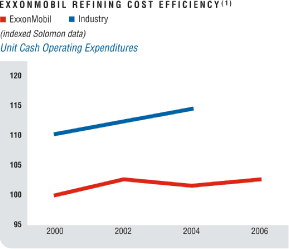 | | 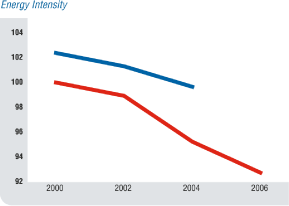 |
| (1) Solomon data available for even years only. | | |
MAINTAINING CAPITAL DISCIPLINE
Refining & Supply capital expenditures are focused on selective and resilient investments that yield competitive advantage. These investments meet product quality requirements, reduce environmental impact, further upgrade safety systems, lower operating costs, and produce higher-value products and chemical feedstocks using lower-cost raw materials. We also continue to implement projects that enhance refinery capacity and yield at much less than grassroots cost and generate an attractive return, even at bottom-of-cycle market conditions.
EXXON MOBIL CORPORATION§ 2006 FINANCIAL & OPERATING REVIEW 69
In 2006 we installed a number of projects at our terminals in Texas, the Mid-Atlantic, and the Northeast to blend ethanol into motor gasoline to meet new U.S. renewable fuels standards.
In 2006 we also completed construction and successfully started up several projects that produce lower-sulfur motor fuels, primarily ultra-low-sulfur diesel in North America, and additional start-ups are planned for 2007. ExxonMobil’s proprietarySCANfiningtechnology provides a competitive edge by producing lower-sulfur gasoline with less octane loss and a minimum of new investment. Similarly, ExxonMobil’s proprietary catalyst technology is being used at several locations to produce ultra-low-sulfur diesel.
ExxonMobil’s Capital Project System continues to provide industry-leading performance in project development and execution. Our project cost effectiveness typically averages 5 to 10 percent better than the refining industry average, as confirmed by external benchmarking with Independent Project Analysis, Inc. Leveraging our global scale and utilizing a rigorous post-project appraisal process, we continue to improve our project execution efficiency.
EMERGING MARKET GROWTH
World-class scale and integration, industry-leading efficiency, leading-edge technology, and globally respected brands enable ExxonMobil to take advantage of attractive emerging-growth opportunities around the globe. For example, our assets are well-positioned and configured to supply liquids demand growth in Asia Pacific, which we estimate will average over 2 percent growth annually through 2030.
FUJIAN – AN INTEGRATED APPROACH
| § | | In February 2007, ExxonMobil along with our partners Saudi Aramco, Sinopec, and Fujian Province announced the signing of contracts for the first fully-integrated refining, petrochemicals, and fuels marketing joint-venture projects with foreign participation in China. |
| |
| § | | The project upgrades an existing refinery in Quanzhou, Fujian Province, from 80 thousand barrels per day to a 240-thousand-barrels-per-day, high-conversion facility. It also includes a world-scale integrated chemical plant, with a new 800-thousand-tons-per-year steam cracker, polyolefins and aromatics plants. |
| |
| § | | There will be a paired fuels marketing joint-venture that will include approximately 750 retail sites. |
| |
| § | | The combined venture allows participation across the value chain from crude processing through fuels and chemical marketing and is the only fully integrated project announced in China with foreign participation. The integrated approach, combined with leading technology, scale, and world-class operations positions this project to be highly competitive in the growing China market. |
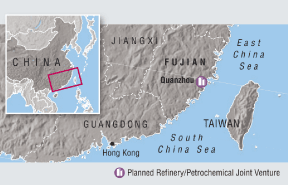
70 EXXON MOBIL CORPORATION§ 2006 FINANCIAL & OPERATING REVIEW
Fuels Marketing
ExxonMobil Fuels Marketing continues to create long-term value by selling high-quality products and services to millions of customers each day across the globe. Our respectedExxon, Mobil, Esso, andOn the Run brands serve customers on the move at nearly 34,000 retail service stations. ExxonMobil fuel products and services are also provided through our three business-to-business segments – Industrial and Wholesale, Aviation, and Marine – to over 1 million customers worldwide.
DIVERSE CUSTOMER BASE PROVIDES GLOBAL OUTLET
| | | |
| Service stations | | ~34,000 |
| Industrial and wholesale customers | | 1 million |
| Aviation operations | | 650 airports |
| Marine operations | | 200 ports |
Fuels Marketing provides a ratable and secure outlet for our refineries and continues to be well-positioned to successfully compete in a dynamic and competitive marketplace by maintaining focus on key business fundamentals: superior safety and environmental performance, operating efficiencies from our global scale and integration, disciplined capital management, and customer focused marketing initiatives.
OPERATING EFFICIENCIES AND INTEGRATION
We continue to leverage integration between our marketing and refining businesses. Downstream cross-functional teams focus on optimizing product placement across the broad spectrum of customer segments to capture the highest value for our refined molecules. Highgrading sales to higher-value channels increased fuels income by over $100 million in 2006.
Operating efficiencies continue to be captured from the global application of innovative technologies, centralization of support activities, and simplification and automation of work processes. In 2006, the combined impact of our efficiency initiatives reduced ongoing operating expenses by $150 million. In addition, improved category management in our convenience stores, car wash operations, and strategic alliances with leading food and grocery marketers have together resulted in nonfuels income growth of $75 million in 2006. The combined benefit of these improvements enhance the resiliency of our retail outlets by further reducing the fuels margin we require for our service stations to break-even.
EXXON MOBIL CORPORATION§ 2006 FINANCIAL & OPERATING REVIEW 71
DISCIPLINED CAPITAL MANAGEMENT
The Fuels Marketing capital management strategy combines selective investments and ongoing portfolio highgrading to optimize the profitability of our business. Investments are prioritized through a rigorous, disciplined, and globally consistent market-planning process using sophisticated tools and models to assess factors such as customer demographics and preferences. Our selective investment approach is complemented by equally selective divestments that high-grade our asset base and optimize returns. This disciplined approach has reduced our number of retail service stations by nearly 20 percent and improved our capital efficiency by 13 percent since 2002.
GROWING NONFUELS INCOME
Drawing on our worldwide retailing experience and extensive consumer and market research, Fuels Marketing offers a portfolio of innovative market specific retail formats and products to fully meet our customers’ needs and expectations by delivering convenience, quality, and value. Further increasing nonfuels income continues to be one of the key priorities to optimize retail site profitability.
In certain markets, we use strategic alliances with leading food and grocery marketers to complement our brand and enhance our convenience store offering by leveraging the strength of our partners’ brand value, expertise, and distribution network. Examples include our alliances withTescoin the United Kingdom and Thailand,Doutorand7-Elevenin Japan,NTUC Fairpricein Singapore, andTim Hortonsin Canada.
72 EXXON MOBIL CORPORATION§ 2006 FINANCIAL & OPERATING REVIEW
Lubricants & Specialties
ExxonMobil is the world’s No.1 supplier of lube basestocks and a leader in marketing finished lubricants and specialty products. We market products under three strong global brands,Mobil,Exxon, andEsso. Anchoring these brands isMobil 1, the world’s leading synthetic motor oil. Many leading original equipment manufacturers around the world trust us to deliver technically superior products that provide the lubrication they need to protect and keep their vehicle engines and industrial machines running at peak performance. We have a dedicated organization and strong distributor network that supply high quality lubricants and provide technical application expertise to customers throughout the globe.
GLOBAL LUBRICANTS LEADERSHIP POSITION
| | | |
| Lube basestock refineries | 13 | |
| Average capacity per lube refinery | 2 times industry | |
| Blend plants | 48 | |
| Lube basestock market share | 19 percent | |
| Finished lubricant market share | 13 percent | |
LEVERAGING OUR BRAND AND TECHNOLOGY
ExxonMobil continues to meet customer needs for automotive, industrial, commercial, aviation, and marine applications around the world. Customers rely on our products because of their quality, reliability, technological leadership, and close association with many leading original equipment manufacturers. Our products have demonstrated the ability to withstand performance stresses and are backed by technical services designed to provide customers with worry-free operations.
| | |
| (1) | | Royal Dutch Shell and BP values estimated based on public information. |
We continue to introduce new and innovative high-quality products, building on our reputation as a leader in technology. In 2006 we introduced into the Mexican market a new high-endurance motor oil line –Mobil 1 Rendimiento Prolongado,Mobil Super 7500, andMobil Super Alto Kilometraje. These products provide consumers protection for their vehicles’ engines for longer oil-change intervals than conventional lubricants. Also in 2006, we introducedMobil 1 ESP, a low-ash lubricant for diesel engines that prolongs life of emission systems, into the U.S. market following a successful 2005 launch in Europe. In basestocks, our proprietaryMSDW-2 catalyst continues to be the industry’s leading technology for producing high-quality lube basestocks at lower costs.
STRATEGIC GLOBAL ALLIANCES
Globally respected brands and industry-leading technology enable ExxonMobil to build long-lasting and successful strategic global alliances with automotive and industrial equipment manufacturers. A strong global presence allows ExxonMobil to better serve customers with worldwide operations and meet their demand for consistently reliable, high-quality products and services.
Motorsports sponsorships, like those inFormula 1with the McLaren Mercedes and Toyota teams, andNASCARandIRLwith Penske Racing, provide ideal environments for developing and demonstrating our high-performance lubricants. Additionally, we have relationships with strategic accounts that extend off the track, through our technology partnerships with Toyota, DaimlerChrysler, General Motors, Peugeot, and Porsche, where we collaborate on developing innovative new lubricants. This long-term strategic approach leads to long-standing partnerships. In 2006, ExxonMobil celebrated 10 years of partnership with Porsche. Porsche recommendsMobil 1motor oil exclusively and every newPorscheautomobile rolls off the assembly line filled withMobil 1oil.
EXXON MOBIL CORPORATION§ 2006 FINANCIAL & OPERATING REVIEW 73
MOBIL 1LUBE CHANGE CENTERS
As the global market continues its trend towards the “do-it-for-me” customer, ExxonMobil Lubricants & Specialties is leveraging its flagship brand,Mobil 1, to build premier oil-change service centers in key markets around the globe, including the United States, Japan, Egypt, and China.
Launched in 2003, ExxonMobil now has close to 500 of these premierMobil 1centers worldwide, with the United States representing more than half of those locations. Growth is expected to continue annually at about 10 percent globally. Oil changes at these centers not only includeMobil 1, the high-performance synthetic oil, but also otherMobilbranded premium products.
GROWING FLAGSHIP AND PREMIUM PRODUCTS
ExxonMobil continues to increase its leading market share in the growing synthetic lubes business.
| § | | Mobil 1is the recommended engine oil for more than 50 percent of new luxury vehicles in North America. No other motor oil holds as many engine specification approvals. The list of high-performance vehicles whose manufacturers recommendMobil 1oil is growing and includesAston Martin,Bentley,Cadillac,Chrysler,Corvette,Dodge,Mercedes Benz,Porsche,Saab, andAcuravehicles. |
| |
| § | | In Russia and Finland, we introducedMobil 1 Arctic, which is formulated to provide maximum protection for engines in cold climates. |
| |
| § | | ExxonMobil continues to strengthen its participation in the industrial lubricants sector. Our salesforce is well trained to assist customers in developing solutions to their lubrication challenges. In 2006 we introducedMobilgear 600XP, formulated to deliver exceptional, long-lasting protection for industrial gearboxes and increased productivity. |
GROWTH IN PROFITABLE EMERGING MARKETS
As economies around the world develop and industrialize, they bring increased demand for high-quality industrial and automotive lubricants. For example, in China and Russia, we have leveraged our well-recognized brands, strong equipment manufacturer relationships, and technical expertise to become a leading international lubes marketer in those markets. In these two countries alone, we have grown our business nearly two-fold since 2000.
| | |
| | | |
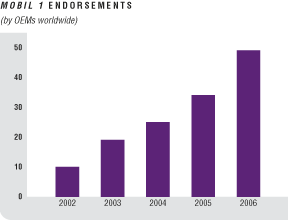
An increasing number of original equipment manufacturers around the world are endorsing Mobil 1 as the recommended lubricant for their vehicles. | | 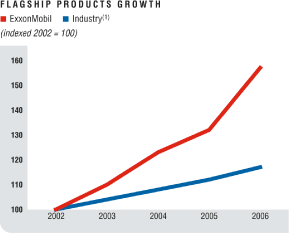
(1) Source: ExxonMobil analysis of available industry data. |
| 74 | | EXXON MOBIL CORPORATION§ 2006 FINANCIAL & OPERATING REVIEW |
Downstream Operating Statistics
REFINING CAPACITY AT YEAR-END 2006(1)
| | | | | | | | | | | | | | | | | | | | | | | | | | | | | | | | | | | | | | | | | |
| | | | | | | | | | | | | | | | | | | Capacity at 100% | | |
| | | | | | | | | | | | | | | ExxonMobil | | | | | | | | | | | | | | | | | | | | | | ExxonMobil |
| | | | | | | | | | | | | | | Share | | Atmospheric | | Catalytic | | | | Residuum | | | | | | Interest |
| (thousands of barrels per day) | | | | | | | | | | | | | | KBD(2) | | Distillation | | Cracking | | Hydrocracking | | Conversion(3) | | Lubricants(4) | | % |
| |
United States | | | | | | | | | | | | | | | | | | | | | | | | | | | | | | | | | | | | | | | | |
| Torrance | | California | | | = | | | | | | | | 150 | | | | 150 | | | | 96 | | | | 21 | | | | 53 | | | | — | | | | 100 | |
| Joliet | | Illinois | | | = | 5 | | | | | | | 238 | | | | 238 | | | | 93 | | | | — | | | | 56 | | | | — | | | | 100 | |
| Baton Rouge | | Louisiana | | < | = | | | | | | | | 503 | | | | 503 | | | | 229 | | | | 27 | | | | 114 | | | | 17 | | | | 100 | |
| Chalmette | | Louisiana | | | = | 5 | | | | | | | 97 | | | | 193 | | | | 68 | | | | 19 | | | | 38 | | | | — | | | | 50 | |
| Billings | | Montana | | | = | | | | | | | | 60 | | | | 60 | | | | 23 | | | | 6 | | | | 10 | | | | — | | | | 100 | |
| Baytown | | Texas | | < | = | | | | | | | | 563 | | | | 563 | | | | 208 | | | | 27 | | | | 84 | | | | 22 | | | | 100 | |
| Beaumont | | Texas | | < | = | | | | | | | | 349 | | | | 349 | | | | 112 | | | | 62 | | | | 48 | | | | 13 | | | | 100 | |
| Total United States | | | | | | | | | | | | | | | 1,960 | | | | 2,056 | | | | 829 | | | | 162 | | | | 403 | | | | 52 | | | | | |
| |
| | | | | | | | | | | | | | | | | | | | | | | | | | | | | | | | | | | | | | | | | |
Canada | | | | | | | | | | | | | | | | | | | | | | | | | | | | | | | | | | | | | | | | |
| Strathcona | | Alberta | | | | | | | | | | | 187 | | | | 187 | | | | 61 | | | | — | | | | — | | | | 2 | | | | 69.6 | |
| Dartmouth | | Nova Scotia | | | | 5 | | | | | | | 82 | | | | 82 | | | | 30 | | | | — | | | | — | | | | — | | | | 69.6 | |
| Nanticoke | | Ontario | | | = | 5 | | | | | | | 112 | | | | 112 | | | | 48 | | | | — | | | | — | | | | — | | | | 69.6 | |
| Sarnia | | Ontario | | < | = | | | | | | | | 121 | | | | 121 | | | | 30 | | | | 18 | | | | 24 | | | | 6 | | | | 69.6 | |
| Total Canada | | | | | | | | | | | | | | | 502 | | | | 502 | | | | 169 | | | | 18 | | | | 24 | | | | 8 | | | | | |
| |
| | | | | | | | | | | | | | | | | | | | | | | | | | | | | | | | | | | | | | | | | |
Europe | | | | | | | | | | | | | | | | | | | | | | | | | | | | | | | | | | | | | | | | |
| Antwerp | | Belgium | | < | = | | | | | | | | 298 | | | | 298 | | | | 35 | | | | — | | | | — | | | | — | | | | 100 | |
| Fos-sur-Mer | | France | | | = | 5 | | | | | | | 119 | | | | 119 | | | | 29 | | | | — | | | | — | | | | — | | | | 82.9 | |
| Port Jerome- Gravenchon | | France | | < | = | | | | | | | | 233 | | | | 233 | | | | 35 | | | | — | | | | — | | | | 13 | | | | 82.9 | |
| Ingolstadt | | Germany | | | = | 5 | | | | | | | 106 | | | | 106 | | | | 28 | | | | — | | | | — | | | | — | | | | 100 | |
| Karlsruhe | | Germany | | | = | 5 | | | | | | | 76 | | | | 302 | | | | 87 | | | | — | | | | 26 | | | | — | | | | 25 | |
| Augusta | | Italy | | | = | 5 | | | | | | | 198 | | | | 198 | | | | 46 | | | | — | | | | — | | | | 18 | | | | 100 | |
| Trecate | | Italy | | | = | 5 | | | | | | | 174 | | | | 174 | | | | 32 | | | | — | | | | — | | | | — | | | | 75.4 | |
| Rotterdam | | The Netherlands | | < | = | | | | | | | | 188 | | | | 188 | | | | — | | | | 51 | | | | 41 | | | | — | | | | 100 | |
| Slagen | | Norway | | | | | | | | | | | 110 | | | | 110 | | | | — | | | | — | | | | 32 | | | | — | | | | 100 | |
| Fawley | | United Kingdom | | < | = | | | | | | | | 326 | | | | 326 | | | | 75 | | | | — | | | | 33 | | | | 11 | | | | 100 | |
| Total Europe | | | | | | | | | | | | | | | 1,828 | | | | 2,054 | | | | 367 | | | | 51 | | | | 132 | | | | 42 | | | | | |
| |
| | | | | | | | | | | | | | | | | | | | | | | | | | | | | | | | | | | | | | | | | |
Japan | | | | | | | | | | | | | | | | | | | | | | | | | | | | | | | | | | | | | | | | |
| Chiba | | Japan | | | = | | | | | | | | 88 | | | | 175 | | | | 34 | | | | 40 | | | | — | | | | — | | | | 50 | |
Kawasaki(5) | | Japan | | < | = | | | | | | | | 296 | | | | 296 | | | | 88 | | | | 23 | | | | — | | | | — | | | | 50 | |
Okinawa(5) | | Japan | | | | | | | | | | | 90 | | | | 90 | | | | — | | | | — | | | | — | | | | — | | | | 43.8 | |
Sakai(5) | | Japan | | | = | 5 | | | | | | | 140 | | | | 140 | | | | 40 | | | | — | | | | — | | | | — | | | | 50 | |
Wakayama(5) | | Japan | | | = | 5 | | | | | | | 155 | | | | 155 | | | | 37 | | | | — | | | | — | | | | 7 | | | | 50 | |
| Total Japan | | | | | | | | | | | | | | | 769 | | | | 856 | | | | 199 | | | | 63 | | | | — | | | | 7 | | | | | |
| |
| | |
| < | | Integrated refinery and chemical complex |
| |
| = | | Cogeneration capacity |
| |
| 5 | | Refineries with some chemical production |
| |
| (1) | | Capacity data is based on 100 percent of rated refinery process unit stream-day capacities under normal operating conditions, less the impact of shutdowns for regular repair and maintenance activities, averaged over an extended period of time. ExxonMobil has additional interests with a total net capacity of 6 thousand barrels per day of lubes in Dunkirk, France; Jeddah, Saudi Arabia; and Yanbu, Saudi Arabia. |
| |
| (2) | | ExxonMobil share reflects 100 percent of atmospheric distillation capacity in operations of ExxonMobil and majority-owned subsidiaries. For companies owned 50 percent or less, ExxonMobil share is the greater of ExxonMobil’s equity interest or that portion of distillation capacity normally available to ExxonMobil. |
| |
| (3) | | Includes thermal cracking, visbreaking, coking, and hydrorefining processes. |
| |
| (4) | | Lubricants capacity based on dewaxed oil production. |
| |
| (5) | | Operated by majority-owned subsidiaries. |
| |
| (6) | | Facility mothballed. |
EXXON MOBIL CORPORATION§ 2006 FINANCIAL & OPERATING REVIEW 75
Refining Capacity at Year-End 2006 (continued)(1)
| | | | | | | | | | | | | | | | | | | | | | | | | | | | | | | | | | | | | | | | | |
| | | | | | | | | | | | | | | | | | | Capacity at 100% | | |
| | | | | | | | | | | | | | | ExxonMobil | | | | | | | | | | | | | | | | | | | | | | ExxonMobil |
| | | | | | | | | | | | | | | Share | | Atmospheric | | Catalytic | | | | | | Residuum | | | | | | Interest |
| (thousands of barrels per day) | | | | | | | | | | | | | | KBD(2) | | Distillation | | Cracking | | Hydrocracking | | Conversion(3) | | Lubricants(4) | | % |
| |
Asia Pacific excluding Japan | | | | | | | | | | | | | | | | | | | | | | | | | | | | | | | | | | | | | | | | |
Adelaide(6) | | Australia | | | | | | | | | | | — | | | | — | | | | — | | | | — | | | | — | | | | — | | | | 100 | |
| Altona | | Australia | | | | | | | | | | | 78 | | | | 78 | | | | 29 | | | | — | | | | — | | | | — | | | | 100 | |
| Port Dickson | | Malaysia | | | | | | | | | | | 86 | | | | 86 | | | | — | | | | — | | | | — | | | | — | | | | 65 | |
| Whangerei | | New Zealand | | | | | | | | | | | 28 | | | | 104 | | | | — | | | | 26 | | | | — | | | | — | | | | 19.2 | |
| Jurong/PAC | | Singapore | | < | = | | | | | | | | 605 | | | | 605 | | | | — | | | | 34 | | | | 116 | | | | 33 | | | | 100 | |
| Sriracha | | Thailand | | < | = | | | | | | | | 174 | | | | 174 | | | | 42 | | | | — | | | | — | | | | — | | | | 87.5 | |
| Total Asia Pacific excluding Japan | | | | | | | | | | | 971 | | | | 1,047 | | | | 71 | | | | 60 | | | | 116 | | | | 33 | | | | | |
| |
| | | | | | | | | | | | | | | | | | | | | | | | | | | | | | | | | | | | | | | | | |
Latin America/Other | | | | | | | | | | | | | | | | | | | | | | | | | | | | | | | | | | | | | | | | |
| Campana | | Argentina | | | = | 5 | | | | | | | 85 | | | | 85 | | | | 27 | | | | — | | | | 24 | | | | — | | | | 100 | |
| Acajutla | | El Salvador | | | | | | | | | | | 22 | | | | 22 | | | | — | | | | — | | | | — | | | | — | | | | 65 | |
| Martinique | | Martinique | | | | | | | | | | | 2 | | | | 17 | | | | — | | | | — | | | | — | | | | — | | | | 14.5 | |
| Managua | | Nicaragua | | | | 5 | | | | | | | 20 | | | | 20 | | | | — | | | | — | | | | — | | | | — | | | | 100 | |
| Yanbu | | Saudi Arabia | | | | | | | | | | | 200 | | | | 400 | | | | 91 | | | | — | | | | 46 | | | | — | | | | 50 | |
| Total Latin America/Other | | | | | | | | | | | | | | | 329 | | | | 544 | | | | 118 | | | | — | | | | 70 | | | | — | | | | | |
| |
Total worldwide | | | | | | | | | | | | | | | 6,359 | | | | 7,059 | | | | 1,753 | | | | 354 | | | | 745 | | | | 142 | | | | | |
| |
| | |
| < | | Integrated refinery and chemical complex |
| = | | Cogeneration capacity |
| 5 | | Refineries with some chemical production |
| |
| (1) | | Capacity data is based on 100 percent of rated refinery process unit stream-day capacities under normal operating conditions, less the impact of shutdowns for regular repair and maintenance activities, averaged over an extended period of time. ExxonMobil has additional interests with a total net capacity of 6 thousand barrels per day of lubes in Dunkirk, France; Jeddah, Saudi Arabia; and Yanbu, Saudi Arabia. |
| |
| (2) | | ExxonMobil share reflects 100 percent of atmospheric distillation capacity in operations of ExxonMobil and majority-owned subsidiaries. For companies owned 50 percent or less, ExxonMobil share is the greater of ExxonMobil’s equity interest or that portion of distillation capacity normally available to ExxonMobil. |
| |
| (3) | | Includes thermal cracking, visbreaking, coking, and hydrorefining processes. |
| |
| (4) | | Lubricants capacity based on dewaxed oil production. |
| |
| (5) | | Operated by majority-owned subsidiaries. |
| |
| (6) | | Facility mothballed. |
| | |
| (1) | | ExxonMobil capacity on a 100-percent basis, excluding divestments. |
| | |
| (1) | | ExxonMobil capacity on a 100-percent basis, excluding divestments. Conversion includes cat cracking, hydrocracking, and coking. |
| 76 | | EXXON MOBIL CORPORATION§ 2006 FINANCIAL & OPERATING REVIEW |
THROUGHPUT, CAPACITY, AND UTILIZATION(1)
| | | | | | | | | | | | | | | | | | | | | |
| | | 2006 | | | 2005 | | | 2004 | | | 2003 | | | 2002 | |
| |
Refinery Throughput(2)(thousands of barrels per day) | | | | | | | | | | | | | | | | | | | | |
| United States | | | 1,760 | | | | 1,794 | | | | 1,850 | | | | 1,806 | | | | 1,834 | |
| Canada | | | 442 | | | | 466 | | | | 468 | | | | 450 | | | | 447 | |
| Europe | | | 1,672 | | | | 1,672 | | | | 1,663 | | | | 1,566 | | | | 1,539 | |
| Japan | | | 649 | | | | 691 | | | | 685 | | | | 704 | | | | 671 | |
| Asia Pacific excluding Japan | | | 785 | | | | 799 | | | | 738 | | | | 686 | | | | 708 | |
| Latin America/Other | | | 295 | | | | 301 | | | | 309 | | | | 298 | | | | 244 | |
| |
Total worldwide | | | 5,603 | | | | 5,723 | | | | 5,713 | | | | 5,510 | | | | 5,443 | |
| |
| | | | | | | | | | | | | | | | | | | | | |
Average Refinery Capacity(3)(thousands of barrels per day) | | | | | | | | | | | | | | | | | | | | |
| United States | | | 1,957 | | | | 1,949 | | | | 1,940 | | | | 1,919 | | | | 1,895 | |
| Canada | | | 502 | | | | 502 | | | | 502 | | | | 501 | | | | 500 | |
| Europe | | | 1,817 | | | | 1,803 | | | | 1,786 | | | | 1,768 | | | | 1,756 | |
| Japan | | | 769 | | | | 769 | | | | 772 | | | | 774 | | | | 770 | |
| Asia Pacific excluding Japan | | | 971 | | | | 997 | | | | 1,014 | | | | 1,027 | | | | 1,048 | |
| Latin America/Other | | | 329 | | | | 323 | | | | 317 | | | | 308 | | | | 299 | |
| |
Total worldwide | | | 6,345 | | | | 6,343 | | | | 6,331 | | | | 6,297 | | | | 6,268 | |
| |
| | | | | | | | | | | | | | | | | | | | | |
Utilization of Refining Capacity(percent) | | | | | | | | | | | | | | | | | | | | |
| United States | | | 90 | | | | 92 | | | | 95 | | | | 94 | | | | 97 | |
| Canada | | | 88 | | | | 93 | | | | 93 | | | | 90 | | | | 89 | |
| Europe | | | 92 | | | | 93 | | | | 93 | | | | 89 | | | | 88 | |
| Japan | | | 84 | | | | 90 | | | | 89 | | | | 91 | | | | 87 | |
| Asia Pacific excluding Japan | | | 81 | | | | 80 | | | | 73 | | | | 67 | | | | 68 | |
| Latin America/Other | | | 90 | | | | 93 | | | | 97 | | | | 97 | | | | 82 | |
| |
Total worldwide | | | 88 | | | | 90 | | | | 90 | | | | 88 | | | | 87 | |
| |
| | |
| (1) | | Excludes ExxonMobil’s minor interests in certain small refineries. |
| |
| (2) | | Refinery throughput includes 100 percent of crude oil and feedstocks sent directly to atmospheric distillation units in operations of ExxonMobil and majority-owned subsidiaries. For companies owned 50 percent or less, throughput includes the greater of either crude and feedstocks processed for ExxonMobil or ExxonMobil’s equity interest in raw material inputs. |
| |
| (3) | | Refinery capacity is the stream-day capability to process inputs to atmospheric distillation units under normal operating conditions, less the impact of shutdowns for regular repair and maintenance activities, averaged over an extended period of time. These annual averages include partial-year impacts for capacity additions or deletions during the year. Any idle capacity that cannot be made operable in a month or less has been excluded. Capacity volumes include 100 percent of the capacity of refinery facilities managed by ExxonMobil or majority-owned subsidiaries. At facilities of companies owned 50 percent or less, the greater of either that portion of capacity normally available to ExxonMobil or ExxonMobil’s equity interest is included. |
LOW-SULFUR GASOLINE AND DIESEL FACILITY START-UPS
| | | | | |
| 2006 | | Location |
| Distillate Hydrotreater | | Joliet, Illinois |
| Distillate Hydrotreater | | Baton Rouge, Louisiana |
| Distillate Hydrotreater | | Billings, Montana |
| Distillate Hydrotreater Upgrade | | Baytown, Texas |
| Distillate Hydrotreater Upgrade | | Beaumont, Texas |
| Distillate Hydrotreater | | Dartmouth, Canada |
| Distillate Hydrotreater | | Nanticoke, Canada |
| Distillate Hydrotreater | | Sarnia, Canada |
| Distillate Hydrotreater | | Strathcona, Canada |
SCANfiningUnit & Related Facilities | | Wakayama, Japan |
| Distillate Hydrotreater Upgrade | | Yanbu, Saudi Arabia |
| | | | | |
| 2007(Anticipated) | | Location |
| Distillate Hydrotreater | | Baton Rouge, Louisiana |
SCANfiningUnit | | Chiba, Japan |
SCANfiningUnit | | Sakai, Japan |
SCANfiningUnit | | Kawasaki, Japan |
EXXON MOBIL CORPORATIONn2006 FINANCIAL & OPERATING REVIEW 77
RETAIL SITES
| | | | | | | | | | | | | | | | | | | | | |
| (number of sites at year end) | | 2006 | | | 2005 | | | 2004 | | | 2003 | | | 2002 | |
| |
United States | | | | | | | | | | | | | | | | | | | | |
| Owned/leased | | | 2,375 | | | | 2,544 | | | | 2,698 | | | | 3,072 | | | | 3,346 | |
| Distributors/resellers | | | 8,742 | | | | 8,992 | | | | 9,421 | | | | 9,401 | | | | 9,787 | |
| | | | | | | | | | | | | | | | | | | | | |
Canada | | | | | | | | | | | | | | | | | | | | |
| Owned/leased | | | 613 | | | | 690 | | | | 720 | | | | 787 | | | | 865 | |
| Distributors/resellers | | | 1,327 | | | | 1,288 | | | | 1,258 | | | | 1,287 | | | | 1,283 | |
| | | | | | | | | | | | | | | | | | | | | |
Europe | | | | | | | | | | | | | | | | | | | | |
| Owned/leased | | | 4,508 | | | | 4,569 | | | | 4,727 | | | | 4,817 | | | | 4,955 | |
| Distributors/resellers | | | 2,886 | | | | 3,022 | | | | 3,154 | | | | 3,582 | | | | 3,813 | |
| | | | | | | | | | | | | | | | | | | | | |
Asia Pacific | | | | | | | | | | | | | | | | | | | | |
| Owned/leased | | | 2,696 | | | | 2,795 | | | | 2,912 | | | | 2,912 | | | | 3,026 | |
| Distributors/resellers | | | 5,368 | | | | 5,662 | | | | 5,888 | | | | 6,318 | | | | 6,682 | |
| | | | | | | | | | | | | | | | | | | | | |
Latin America | | | | | | | | | | | | | | | | | | | | |
| Owned/leased | | | 1,246 | | | | 1,325 | | | | 1,388 | | | | 1,429 | | | | 1,449 | |
| Distributors/resellers | | | 3,008 | | | | 3,155 | | | | 3,437 | | | | 3,891 | | | | 4,465 | |
| | | | | | | | | | | | | | | | | | | | | |
Middle East/Africa | | | | | | | | | | | | | | | | | | | | |
| Owned/leased | | | 713 | | | | 933 | | | | 1,214 | | | | 1,360 | | | | 1,443 | |
| Distributors/resellers | | | 366 | | | | 457 | | | | 557 | | | | 632 | | | | 672 | |
| | | | | | | | | | | | | | | | | | | | | |
Total | | | | | | | | | | | | | | | | | | | | |
| Owned/leased | | | 12,151 | | | | 12,856 | | | | 13,659 | | | | 14,377 | | | | 15,084 | |
| Distributors/resellers | | | 21,697 | | | | 22,576 | | | | 23,715 | | | | 25,111 | | | | 26,702 | |
| |
Total worldwide | | | 33,848 | | | | 35,432 | | | | 37,374 | | | | 39,488 | | | | 41,786 | |
| |
78 EXXON MOBIL CORPORATIONn2006 FINANCIAL & OPERATING REVIEW
PETROLEUM PRODUCT SALES(1)BY GEOGRAPHIC AREA
| | | | | | | | | | | | | | | | | | | | | |
| | | | | | | | | | | Including Purchases/Sales with |
| | | | | | | | | | | the Same Counterparty |
| (thousands of barrels per day) | | 2006 | | | 2005 | | | 2004 | | | 2003 | | | 2002 | |
| | |
United States | | | | | | | | | | | | | | | | | | | | |
| Motor gasoline, naphthas | | | 1,598 | | | | 1,646 | | | | 1,695 | | | | 1,606 | | | | 1,608 | |
| Heating oils, kerosene, diesel oils | | | 520 | | | | 494 | | | | 484 | | | | 456 | | | | 432 | |
| Aviation fuels | | | 236 | | | | 259 | | | | 250 | | | | 234 | | | | 256 | |
| Heavy fuels | | | 81 | | | | 90 | | | | 98 | | | | 93 | | | | 92 | |
| Lubricants, specialty, and other petroleum products | | | 294 | | | | 333 | | | | 345 | | | | 340 | | | | 343 | |
| Total United States | | | 2,729 | | | | 2,822 | | | | 2,872 | | | | 2,729 | | | | 2,731 | |
| | |
| | | | | | | | | | | | | | | | | | | | | |
Canada | | | | | | | | | | | | | | | | | | | | |
| Motor gasoline, naphthas | | | 204 | | | | 209 | | | | 250 | | | | 249 | | | | 246 | |
| Heating oils, kerosene, diesel oils | | | 143 | | | | 145 | | | | 186 | | | | 184 | | | | 176 | |
| Aviation fuels | | | 24 | | | | 25 | | | | 33 | | | | 29 | | | | 27 | |
| Heavy fuels | | | 32 | | | | 37 | | | | 37 | | | | 36 | | | | 31 | |
| Lubricants, specialty, and other petroleum products | | | 70 | | | | 82 | | | | 109 | | | | 104 | | | | 113 | |
| Total Canada | | | 473 | | | | 498 | | | | 615 | | | | 602 | | | | 593 | |
| | |
| | | | | | | | | | | | | | | | | | | | | |
Europe | | | | | | | | | | | | | | | | | | | | |
| Motor gasoline, naphthas | | | 427 | | | | 424 | | | | 557 | | | | 558 | | | | 571 | |
| Heating oils, kerosene, diesel oils | | | 738 | | | | 734 | | | | 895 | | | | 840 | | | | 815 | |
| Aviation fuels | | | 188 | | | | 182 | | | | 203 | | | | 197 | | | | 192 | |
| Heavy fuels | | | 202 | | | | 204 | | | | 214 | | | | 217 | | | | 213 | |
| Lubricants, specialty, and other petroleum products | | | 258 | | | | 280 | | | | 270 | | | | 249 | | | | 251 | |
| Total Europe | | | 1,813 | | | | 1,824 | | | | 2,139 | | | | 2,061 | | | | 2,042 | |
| | |
| | | | | | | | | | | | | | | | | | | | | |
Asia Pacific | | | | | | | | | | | | | | | | | | | | |
| Motor gasoline, naphthas | | | 409 | | | | 421 | | | | 513 | | | | 523 | | | | 442 | |
| Heating oils, kerosene, diesel oils | | | 493 | | | | 535 | | | | 594 | | | | 599 | | | | 518 | |
| Aviation fuels | | | 106 | | | | 112 | | | | 113 | | | | 109 | | | | 123 | |
| Heavy fuels | | | 288 | | | | 285 | | | | 222 | | | | 218 | | | | 201 | |
| Lubricants, specialty, and other petroleum products | | | 165 | | | | 208 | | | | 247 | | | | 226 | | | | 219 | |
| Total Asia Pacific | | | 1,461 | | | | 1,561 | | | | 1,689 | | | | 1,675 | | | | 1,503 | |
| | |
| | | | | | | | | | | | | | | | | | | | | |
Latin America | | | | | | | | | | | | | | | | | | | | |
| Motor gasoline, naphthas | | | 160 | | | | 166 | | | | 181 | | | | 180 | | | | 194 | |
| Heating oils, kerosene, diesel oils | | | 180 | | | | 188 | | | | 209 | | | | 203 | | | | 204 | |
| Aviation fuels | | | 48 | | | | 47 | | | | 46 | | | | 43 | | | | 44 | |
| Heavy fuels | | | 55 | | | | 48 | | | | 44 | | | | 40 | | | | 37 | |
| Lubricants, specialty, and other petroleum products | | | 26 | | | | 24 | | | | 24 | | | | 24 | | | | 23 | |
| Total Latin America | | | 469 | | | | 473 | | | | 504 | | | | 490 | | | | 502 | |
| | |
| | | | | | | | | | | | | | | | | | | | | |
Middle East/Africa | | | | | | | | | | | | | | | | | | | | |
| Motor gasoline, naphthas | | | 68 | | | | 91 | | | | 105 | | | | 122 | | | | 115 | |
| Heating oils, kerosene, diesel oils | | | 117 | | | | 134 | | | | 149 | | | | 150 | | | | 147 | |
| Aviation fuels | | | 49 | | | | 51 | | | | 53 | | | | 50 | | | | 49 | |
| Heavy fuels | | | 24 | | | | 25 | | | | 44 | | | | 34 | | | | 30 | |
| Lubricants, specialty, and other petroleum products | | | 44 | | | | 40 | | | | 40 | | | | 44 | | | | 45 | |
| Total Middle East/Africa | | | 302 | | | | 341 | | | | 391 | | | | 400 | | | | 386 | |
| | |
| | | | | | | | | | | | | | | | | | | | | |
Worldwide | | | | | | | | | | | | | | | | | | | | |
| Motor gasoline, naphthas | | | 2,866 | | | | 2,957 | | | | 3,301 | | | | 3,238 | | | | 3,176 | |
| Heating oils, kerosene, diesel oils | | | 2,191 | | | | 2,230 | | | | 2,517 | | | | 2,432 | | | | 2,292 | |
| Aviation fuels | | | 651 | | | | 676 | | | | 698 | | | | 662 | | | | 691 | |
| Heavy fuels | | | 682 | | | | 689 | | | | 659 | | | | 638 | | | | 604 | |
| Lubricants, specialty, and other petroleum products | | | 857 | | | | 967 | | | | 1,035 | | | | 987 | | | | 994 | |
| | |
Total worldwide(2) | | | 7,247 | | | | 7,519 | | | | 8,210 | | | | 7,957 | | | | 7,757 | |
| | | | | | | | | | | | | | | | | | | | | |
| Purchases/sales with the same counterparty included above | | | — | | | | — | | | | (699 | ) | | | (687 | ) | | | (682 | ) |
Total, net of purchases/sales with the same counterparty | | | 7,247 | | | | 7,519 | | | | 7,511 | | | | 7,270 | | | | 7,075 | |
| |
| | |
| (1) | | Petroleum product sales include 100 percent of the sales of ExxonMobil and majority-owned subsidiaries, and the ExxonMobil equity interest in sales by companies owned 50 percent or less. |
| |
| (2) | | 2006 and 2005 petroleum product sales data are reported net of purchases/sales contracts with the same counterparty. |
EXXON MOBIL CORPORATIONn2006 FINANCIAL & OPERATING REVIEW 79
PETROLEUM PRODUCT SALES
| | | | | | | | | | | | | | | | | | | | | |
| | | | | | | | | | | Including Purchases/Sales with |
| | | | | | | | | | | the Same Counterparty |
| (thousands of barrels per day) | | 2006 | | | 2005 | | | 2004 | | | 2003 | | | 2002 | |
| | |
Market and Supply Sales(1) | | | | | | | | | | | | | | | | | | | | |
| Market sales | | | | | | | | | | | | | | | | | | | | |
| Motor gasoline, naphthas | | | 2,133 | | | | 2,186 | | | | 2,248 | | | | 2,273 | | | | 2,288 | |
| Heating oils, kerosene, diesel oils | | | 1,544 | | | | 1,618 | | | | 1,625 | | | | 1,626 | | | | 1,625 | |
| Aviation fuels | | | 440 | | | | 475 | | | | 503 | | | | 514 | | | | 529 | |
| Heavy fuels | | | 396 | | | | 387 | | | | 382 | | | | 367 | | | | 358 | |
| Lubricants, specialty, and other petroleum products | | | 323 | | | | 316 | | | | 495 | | | | 483 | | | | 494 | |
Total market sales | | | 4,836 | | | | 4,982 | | | | 5,253 | | | | 5,263 | | | | 5,294 | |
| | |
Total supply sales | | | 2,411 | | | | 2,537 | | | | 2,957 | | | | 2,694 | | | | 2,463 | |
| | |
Total market and supply sales(2) | | | 7,247 | | | | 7,519 | | | | 8,210 | | | | 7,957 | | | | 7,757 | |
| | | | | | | | | | | | | | | | | | | | | |
| Purchases/sales with the same counterparty included above | | | — | | | | — | | | | (699 | ) | | | (687 | ) | | | (682 | ) |
| |
Total market and supply sales, net of purchases/sales
with the same counterparty | | | 7,247 | | | | 7,519 | | | | 7,511 | | | | 7,270 | | | | 7,075 | |
| |
| | |
| (1) | | Market sales are to retail site dealers, consumers (including government and military), jobbers, and small resellers. Supply sales are to large oil marketers, large unbranded resellers, and other oil companies. |
| |
| (2) | | 2006 and 2005 petroleum product sales data are reported net of purchases/sales contracts with the same counterparty. |
PREMIUM BRANDS DRIVE CONSUMER CONFIDENCE
ExxonMobil offers consumers premium products carrying the branding ofExxon, Mobil,andEsso.Additional lines include our industry-leading lubricant lineMobil 1,while service offerings such as ourOn the Runconvenience store format andWash n’ Runcar wash provide motorists with the things they need backed by brands they trust. A recent addition atOn the Runstores isBengal Traderscoffees, featuring a variety of blends, and fast becoming a recognized brand in itself.
80 EXXON MOBIL CORPORATIONn2006 FINANCIAL & OPERATING REVIEW
ExxonMobil’s world-scale petrochemical facilities around the world enabled record earnings performance in 2006. The Kemya facility shown here is one of two successful joint petrochemical ventures in the Kingdom of Saudi Arabia with Saudi Basic Industries Corporation.
Chemical
| | | | | | | | | | | | | | | | | | | | | |
| CHEMICAL STATISTICAL RECAP | | 2006 | | | 2005 | | | 2004 | | | 2003 | | | 2002 | |
| |
Earnings(millions of dollars) | | | 4,382 | | | | 3,943 | | | | 3,428 | | | | 1,432 | | | | 830 | |
Prime product sales(1)(thousands of metric tons) | | | 27,350 | | | | 26,777 | | | | 27,788 | | | | 26,567 | | | | 26,606 | |
Average capital employed(millions of dollars) | | | 13,183 | | | | 14,064 | | | | 14,608 | | | | 14,099 | | | | 13,645 | |
Return on average capital employed(percent) | | | 33.2 | | | | 28.0 | | | | 23.5 | | | | 10.2 | | | | 6.1 | |
Capital expenditures(millions of dollars) | | | 756 | | | | 654 | | | | 690 | | | | 692 | | | | 954 | |
| | |
| (1) | | Prime product sales include ExxonMobil’s share of equity company volumes and finished-product transfers to the Downstream. Carbon-black oil volumes are excluded. |
EXXON MOBIL CORPORATIONn2006 FINANCIAL & OPERATING REVIEW 81
CHEMICAL STRATEGIES
ExxonMobil Chemical continues to produce superior returns and earnings growth through the effective implementation of our fundamental strategies. Proven over several decades, they reflect our ongoing commitment to the petrochemical business:
| § | | Focus on businesses that capitalize on core competencies; |
| |
| § | | Capture full benefits of integration across ExxonMobil operations; |
| |
| § | | Consistently deliver best-in-class performance; |
| |
| § | | Build proprietary technology positions; and, |
| |
| § | | Selectively invest in advantaged projects. |
Together with the integrity of our business practices and operations, these strategies remain the foundation for our business, and ultimately, our performance.
| | |
| (1) | | Includes the chemical segments of Royal Dutch Shell, BP (through 2004), and Chevron, as well as Dow Chemical, the sole chemical-only competitor with a significant portfolio overlap. Competitor values are estimated on a consistent basis with ExxonMobil, based on public information. |
2006 Results and Highlights
Operational performance continued to be strong with best-ever results in safety and energy efficiency.
Earnings were a record $4.4 billion, up 11 percent versus 2005.ExxonMobil continued to benefit from our unique business portfolio, global presence, and feedstock and integration advantages.
Return on average capital employed reached 33 percent, up from 28 percent in 2005.ExxonMobil Chemical returns continue to exceed the average of our major chemical competitors. While making substantial investments to support long-term growth, our chemical segment achieved an average return of 16 percent over the last 10 years. During this period, our competitors averaged 8 percent.
2006 prime product sales volume of 27 million tons was 2 percent higher than 2005.Revenue of $49 billion increased 14 percent from 2005.
Plans were announced for a proposed major petrochemical complex in Qatar with Qatar Petroleum.In addition, a feasibility study was begun with Saudi Basic Industries Corporation (SABIC) to define a potential project to grow our existing joint petrochemical ventures at Yanbu and Al Jubail.
Capital expenditures were $756 millionwith continued selective investment targeting high-return efficiency projects, low-cost debottlenecks, and growth of our profitable specialty businesses. In addition, significant progress was made in advancing our study of a second, parallel petrochemical train at our Singapore complex.
CHEMICAL COMPETITIVE ADVANTAGES
Portfolio Quality— Our unique mix of chemical businesses delivers superior performance relative to competition throughout the business cycle.
Global Integration— Synergies with Upstream and Downstream operations continue to be identified and realized. Benefits are derived from the physical integration of sites, coordinated planning, global networks, feedstock integration, and shared services and best practices.
Discipline and Consistency— Our consistent and relentless focus on all aspects of operational excellence has produced industry-leading practices and systems.
Value Maximization— Our proprietary technology has successfully led to the development and growth of higher-valued premium products in both our commodity and specialty businesses.
Long-Term Perspective— Through a highly structured capital management approach, we invest only in projects that can compete in the toughest environments based on feedstock, technology, or marketing advantages.
82 EXXON MOBIL CORPORATIONn2006 FINANCIAL & OPERATING REVIEW
Fundamental Strategies
Through consistent deployment of our long-term strategies, we have demonstrated differentiated performance that has strengthened our position as a premier petrochemical company.
FOCUS ON BUSINESSES THAT CAPITALIZE ON CORE COMPETENCIES
ExxonMobil’s unique portfolio of chemical businesses has been developed over many years based on fundamental competitive advantages.
The company holds leadership positions for some of the largest-volume and highest-growth petrochemicals in the global economy. Our presence in commodity chemicals includes:
| § | | One of the largest producers of olefins, the basic petrochemical building blocks for numerous derivative products. |
| |
| § | | The largest worldwide producer of polyolefins, including polyethylene, the largest-volume plastic, and polypropylene, one of the fastest-growing and most versatile polymers. These product families are used in numerous areas ranging from food packaging to automotive and medical applications. |
| |
| § | | One of the largest global producers of paraxylene and benzene. Paraxylene is one of the fastest-growing petrochemicals and the main raw material for polyester fibers and polyethylene terephthalate (PET) recyclable bottles. Benzene is a primary building block for a broad array of products ranging from nylon to polystyrene. |
PREMIER PETROCHEMICAL COMPANY
| | |
| | | |
| Return on capital employed(10-year average) | 16 percent | |
| Businesses ranked 1 or 2 by market position | >90 percent | |
| Capital employed(at year end) | $13 billion | |
| Prime product sales(metric tons) | 27 million | |
| Percent integrated capacity | >90 percent | |
The company’s portfolio is balanced by a similar leadership presence in a diverse set of specialty businesses, composed of product families that deliver higher value through advanced performance. These businesses are grounded in proprietary technology, benefit from synergies across business lines and are strong performers throughout the business cycle. Our products are used in a wide range of industrial and consumer end uses, including many familiar applications such as tires, diapers, candy wrappers, hand tools, and high-quality inks.
Throughout ExxonMobil’s commodity and specialty businesses, a key focus area is the continued upgrade of products to meet evolving customer needs. These “premium products” have growth rates more than double that of our overall business. Extensive customer application support, proprietary technology, and strong intellectual property positions underpin our success in this area.
BUSINESSES
| | |
| | | Worldwide Rank |
| | | Based on Market Position |
| nCommodities | | |
| Paraxylene | | #1 |
| Olefins | | #2 |
| Polyethylene | | #2 |
| Polypropylene | | #5 |
| | | |
| nSpecialties | | |
| Butyl Polymers | | #1 |
| Fluids | | #1 |
| Plasticizers/Oxo | | #1 |
| Synthetics | | #1 |
| Oriented Polypropylene Films | | #1 |
| Adhesive Polymers | | #1 |
| Specialty Elastomers | | #2 |
| Petroleum Additives | | #2 |
EXXON MOBIL CORPORATIONn2006 FINANCIAL & OPERATING REVIEW 83
CAPTURE FULL BENEFITS OF INTEGRATION ACROSS EXXONMOBIL OPERATIONS
ExxonMobil Chemical’s manufacturing network is distributed across the globe. Over 90 percent of the chemical capacity that we own and operate is integrated with our large refining complexes or natural gas processing plants.
Integration benefits continue to be one of the key differentiating factors of our company. In addition to the flexibility and cost savings that physical integration of sites affords, optimization of feedstock and production plans through sophisticated models provides sustained advantages. At these joint sites, maintenance, laboratory, engineering and other services are shared. More broadly, best practices in areas such as safety, reliability, and training are transferred globally across all organizations.
ExxonMobil’s breadth of experience and commitment across the upstream, downstream and petrochemical businesses are demonstrated sources of competitive advantage. In addition, our petrochemical technology, market understanding and applications expertise enable the Corporation to offer potential partners and host governments a comprehensive, integrated approach to major project development.
CONSISTENTLY DELIVER
BEST-IN-CLASS PERFORMANCE
The company maintains a consistent and relentless focus on operational excellence. Through many years of effort, business practices and systems have been developed to ensure the uncompromised integrity of our operations and delivery of industry-leading performance.
The company’s disciplined approach to safety, productivity, reliability, and quality improvement has continually increased the contribution of existing assets. Over the last five years, improved reliability, elimination of constraints, and technology advances have added the equivalent capacity of about one-and-a-half steam crackers at significantly less than grassroots cost.
Energy efficiencies are being identified and captured at ExxonMobil facilities through the extensive use of our Global Energy Management System, a corporate-wide set of best practices and technologies. The energy consumed per unit of product output has decreased by more than 9 percent over the last four years — an improvement pace twice that of competition.
The company also benefits from marketing excellence initiatives aimed at continuously improving areas such as transactional excellence, optimization of supply chain networks, growth of premium products in target markets, working capital management, and continuous enhancement of enabling technology.
BUILD PROPRIETARY TECHNOLOGY POSITIONS
Technology is a major source of competitive advantage and differentiation. Our goal is to provide value to our customers by better understanding their needs and meeting their expectations through focused product innovation and application support. We also focus significant research toward the development of leading process technology and utilization of lower-cost, advantaged feedstocks.
84 EXXON MOBIL CORPORATION§ 2006 FINANCIAL & OPERATING REVIEW
SELECTIVELY INVEST IN ADVANTAGED PROJECTS
In 2006, the company made significant progress on plans for several world-scale advantaged projects to supply demand growth in Asia, and in particular China. Several of these projects would build on our advantaged geographic footprint of world-scale facilities strategically located in the Middle East and Singapore.
In addition, we continued to grow our specialty businesses and to progress low-cost expansion projects to serve existing and developing markets. These investments enable continued growth of premium products across our commodity and specialty businesses.
WELL-POSITIONED FOR ASIA GROWTH
| § | | Detailed project definition for a second world-scale steam cracker complex in Singapore continues. The project coordination and services contractor, as well as the front-end engineering and design contractors for several derivative units, were selected. In addition to the steam cracker, the project scope includes new world-scale polyethylene, polypropylene, and specialty elastomers plants; an aromatics extraction unit; and an oxo-alcohol expansion. The project would be integrated with the existing Singapore complex, providing feedstock, operating and investment synergies with existing refining and chemical facilities. |
| |
| § | | Project engineering and procurement activities continued on the Fujian integrated refining, petrochemical, and fuels marketing joint venture. This is the only fully integrated project in China and would involve construction of an 800 thousand-tons-per-year ethylene steam cracker, polyethylene and polypropylene units, and a 700 thousand-tons-per-year paraxylene unit. |
| § | | Qatar Petroleum and ExxonMobil Chemical Qatar signed a Heads of Agreement to progress studies for a world-scale petrochemical complex in Ras Laffan Industrial City, Qatar. The proposed complex includes a world-scale 1300 thousand-tons-per-year steam cracker, along with polyethylene and ethylene glycol units. The complex would utilize feedstock from gas development projects in Qatar’s North Field and supply competitively advantaged premium products to the Middle East, Asia, and Europe. |
| |
| § | | Saudi Basic Industries Corporation (SABIC) and affiliates of ExxonMobil Chemical announced a feasibility study to define a potential project to grow the existing joint petrochemical ventures at Yanbu and Al Jubail. The project would target supply of petrochemical products to serve emerging local and international markets. |
SPECIALTY BUSINESSES
| § | | A new facility at the Baton Rouge, Louisiana, complex will manufacture a broad spectrum of specialty compounded products as part of the company’s global strategy and commitment to provide engineered thermoplastic materials to the automotive and consumer products industries. |
| |
| § | | A 50-percent expansion of theEscorezhydrogenated tackifying resins facility at Notre Dame de Gravenchon, France, will help the company serve global demand for adhesives and support the high growth of the hot melt adhesives market. |
| |
| § | | A major expansion at Baytown, Texas, will increase the company’s capacity to produceExxon bromobutyl rubber by 60 percent to satisfy strong demand and high growth in the global halobutyl rubber market and tire industry. |
| | | | | | | | | |
| APPROVED PROJECT START-UPS | | Capacity(1) | |
| | | | | | | (metric tons | |
| | | Location | | per year) | |
Olefins/Polyolefins | | | | | | | | |
2006Ethylene (50% interest) | | Al Jubail, Saudi Arabia | | | 30,000 | |
2006Polypropylene | | Baton Rouge, Louisiana | | | 60,000 | |
2007Ethylene | | Singapore | | | 75,000 | |
2007Polyethylene | | Antwerp, Belgium | | | 27,000 | |
| | | | | | | | | |
Specialty Businesses | | | | | | | | |
2006Specialty Elastomers | | Pensacola, Florida | | 1 line | |
2006Polyethylene Film | | Nasu, Japan | | | 25,000 | (2) |
2006Oxo-Alcohols | | Singapore | | | 40,000 | |
2006Isopropyl Alcohol | | Baton Rouge, Louisiana | | | 40,000 | |
2006Halobutyl Rubber (50% interest) | | Kashima, Japan | | | 8,500 | |
2006Butyl Elastomers | | Baytown, Texas | | 1 line | |
2007Compounded Polymers | | Baton Rouge, Louisiana | | 3 lines | |
2008Adhesive Resins | | Notre Dame de Gravenchon, | | | | |
| | | France | | | 18,000 | |
2008Bromobutyl Rubber | | Baytown, Texas | | 60% increase | |
| | |
| (1) | | ExxonMobil equity share of capacity addition. |
| |
| (2) | | Thousand square meters per year. |
EXXON MOBIL CORPORATION§ 2006 FINANCIAL & OPERATING REVIEW 85
KEY PRODUCTS — MEETING DIVERSE CONSUMER NEEDS
In addition to being a premier supplier of olefins, polyolefins, and aromatics, ExxonMobil Chemical has strong market positions in a wide variety of other petrochemicals. The chart below highlights our key products and extensive integration, which extends back through refining and natural gas production.
86 EXXON MOBIL CORPORATION§ 2006 FINANCIAL & OPERATING REVIEW
Chemical Operating Statistics
LARGE/INTEGRATED PRODUCTION COMPLEXES (BASED ON SIZE OR BREADTH OF PRODUCT SLATE)
| | | | | | | | | | | | | | | | | | | | | | | | | | | | | | | | | |
| Capacity(millions ofmetric tons per year) | | Ethylene | | | Paraxylene | | | Polyethylene | | | Polypropylene | | | Additional Products | |
| |
North America | | | | | | | | | | | | | | | | | | | | | | | | | | | | | | | | |
| Baton Rouge, Louisiana | | | 1.0 | | | | — | | | | 1.3 | | | | 0.4 | | | P | | B | | E | | A | | | F | | | O | | |
| Baytown, Texas | | | 2.2 | | | | 0.6 | | | | — | | | | 0.8 | | | P | | B | | | | | | | F | | | | | |
| Beaumont, Texas | | | 0.8 | | | | 0.3 | | | | 1.0 | | | | — | | | P | | | | | | | | | | | | | S | |
| Mont Belvieu, Texas | | | — | | | | — | | | | 1.0 | | | | — | | | | | | | | | | | | | | | | | |
| Sarnia, Ontario | | | 0.3 | | | | — | | | | 0.5 | | | | — | | | P | | | | | | | | | F | | | O | | |
| | | | | | | | | | | | | | | | | | | | | | | | | | | | | | | | | |
Europe | | | | | | | | | | | | | | | | | | | | | | | | | | | | | | | | |
| Antwerp, Belgium | | | 0.5 | | | | — | | | | 0.3 | | | | — | | | P | | | | | | | | | F | | | O | | |
| Fawley, England | | | 0.1 | | | | — | | | | — | | | | — | | | P | | B | | | | | | | F | | | O | | |
| Fife, Scotland | | | 0.4 | | | | — | | | | — | | | | — | | | | | | | | | | | | | | | | | |
| Meerhout, Belgium | | | — | | | | — | | | | 0.5 | | | | — | | | | | | | | | | | | | | | | | |
| Notre-Dame-de-Gravenchon, France | | | 0.4 | | | | — | | | | 0.4 | | | | 0.4 | | | P | | B | | E | | A | | | | | | O | S | |
| Rotterdam, the Netherlands | | | — | | | | 0.6 | | | | — | | | | — | | | | | | | | | | | | | | | O | | |
| | | | | | | | | | | | | | | | | | | | | | | | | | | | | | | | | |
Middle East | | | | | | | | | | | | | | | | | | | | | | | | | | | | | | | | |
| Al Jubail, Saudi Arabia | | | 0.6 | | | | — | | | | 0.6 | | | | — | | | | | | | | | | | | | | | | | |
| Yanbu, Saudi Arabia | | | 1.0 | | | | — | | | | 0.6 | | | | 0.2 | | | P | | | | | | | | | | | | | |
| | | | | | | | | | | | | | | | | | | | | | | | | | | | | | | | | |
Asia Pacific | | | | | | | | | | | | | | | | | | | | | | | | | | | | | | | | |
| Kawasaki, Japan | | | 0.5 | | | | — | | | | 0.1 | | | | — | | | P | | B | | | | A | | | F | | | | | |
| Singapore | | | 0.8 | | | | 0.9 | | | | 0.6 | | | | 0.4 | | | P | | | | | | | | | F | | | O | | |
| Sriracha, Thailand | | | — | | | | 0.5 | | | | — | | | | — | | | | | | | | | | | | F | | | | | |
| All other | | | — | | | | 0.6 | | | | 0.1 | | | | — | | | | | | | | | | | | | | | | | |
| |
Total worldwide | | | 8.6 | | | | 3.5 | | | | 7.0 | | | | 2.2 | | | | | | | | | | | | | | | | | |
| |
PPropylene B Butyl E Specialty Elastomers AAdhesive Polymers F Fluids O Oxo S Synthetics
OTHER MANUFACTURING LOCATIONS(1)
| | | | | | | | | |
| Location | | Product | |
North America | | | | | | | | |
| Bayway, New Jersey | | | | 5 | | | | |
| Belleville, Ontario | | | | | | | u | |
| Chalmette, Louisiana | | | n | | | | | |
| Dartmouth, Nova Scotia | | | | | l | | | |
| Edison, New Jersey | | | | | l | | | |
Houston, Texas(2) | | | n | | | | | |
| Joliet, Illinois | | | n | | | | | |
| LaGrange, Georgia | | | | | | | u | |
| Pensacola, Florida | | | | 5 | | | | |
| Plaquemine, Louisiana | | | | 5 | | | | |
| Shawnee, Oklahoma | | | | | | | u | |
| Stratford, Connecticut | | | | | | | u | |
| | | | | | | | | |
Latin America | | | | | | | | |
| Campana, Argentina | | | n | | l | | | |
| Managua, Nicaragua | | | | | l | | | |
| Paulinia, Brazil | | | | | l | | | |
| | | | | | | | | |
Europe | | | | | | | |
| Amsterdam, the Netherlands | | | | | l | | | |
| Augusta, Italy | | | n | | | | | |
| Brindisi, Italy | | | | | | | u | |
| Cologne, Germany | | | | 5 | | | | |
| Fos-sur-Mer, France | | | n | | | | | |
| Geleen, the Netherlands | | | | 5 | | | | |
Harnes, France(2) | | | | | l | | | |
| Ingolstadt, Germany | | | n | | | | | |
| Karlsruhe, Germany | | | n | | | | | |
| Kerkrade, the Netherlands | | | | | | | u | |
| Newport, Wales | | | | 5 | | | | |
| Trecate, Italy | | | | | l | | | |
| Virton, Belgium | | | | | | | u | |
| | | | | | | | | |
Asia Pacific | | | | | | | | |
Adelaide, Australia(2) | | | | | l | | | |
| Jinshan, China | | | | 5 | | | | |
| Kashima, Japan | | | | 5 | | | | |
| Nasu, Japan | | | | | | | u | |
| Panyu, China | | | | | l | | | |
| Sakai, Japan | | | n | | l | | | |
| Wakayama, Japan | | | n | | | | | |
| | |
| (1) | | Includes joint-venture plants, with the exception of theInfineumadditives joint ventures. |
| |
| (2) | | Facility mothballed. |
| |
| n | | Olefins/Aromatics |
| |
| 5 | | Polymers |
| |
| l | | Other Chemicals |
| |
| u | | Films |
EXXON MOBIL CORPORATION§ 2006 FINANCIAL & OPERATING REVIEW 87
VOLUMES
| | | | | | | | | | | | | | | | | | | | | |
| Includes ExxonMobil’s share of equity companies | | 2006 | | | 2005 | | | 2004 | | | 2003 | | | 2002 | |
| |
Worldwide Production Volumes(thousands of metric tons) | | | | | | | | | | | | | | | | | | | | |
| Ethylene | | | 7,878 | | | | 7,930 | | | | 8,271 | | | | 7,567 | | | | 7,539 | |
| Polyethylene | | | 6,275 | | | | 6,213 | | | | 6,248 | | | | 6,091 | | | | 6,235 | |
| Polypropylene | | | 1,815 | | | | 1,680 | | | | 1,885 | | | | 1,965 | | | | 1,944 | |
| Paraxylene | | | 3,038 | | | | 2,785 | | | | 2,826 | | | | 2,531 | | | | 2,275 | |
| | | | | | | | | | | | | | | | | | | | | |
Prime Product Sales Volumes(1)(thousands of metric tons) | | | | | | | | | | | | | | | | | | | | |
Americas(2) | | | 11,907 | | | | 11,523 | | | | 12,842 | | | | 11,939 | | | | 12,614 | |
| Europe/Middle East/Africa | | | 7,497 | | | | 7,310 | | | | 7,334 | | | | 7,180 | | | | 7,002 | |
| Asia Pacific | | | 7,946 | | | | 7,944 | | | | 7,612 | | | | 7,448 | | | | 6,990 | |
| |
Total worldwide | | | 27,350 | | | | 26,777 | | | | 27,788 | | | | 26,567 | | | | 26,606 | |
| |
| | | | | | | | | | | | | | | | | | | | | |
Prime Product Sales Volumes(1)(thousands of metric tons) | | | | | | | | | | | | | | | | | | | | |
| Less-cyclical specialty businesses | | | 6,228 | | | | 6,083 | | | | 6,324 | | | | 6,113 | | | | 6,022 | |
| Olefins/polyolefins/aromatics/other | | | 21,122 | | | | 20,694 | | | | 21,464 | | | | 20,454 | | | | 20,584 | |
| |
Total | | | 27,350 | | | | 26,777 | | | | 27,788 | | | | 26,567 | | | | 26,606 | |
| |
| | |
| (1) | | Prime product sales include ExxonMobil’s share of equity-company volumes and finished product transfers to the Downstream. Carbon-black oil volumes are excluded. |
| |
| (2) | | Includes the United States, Canada, and Latin America.
|
88 EXXON MOBIL CORPORATION§ 2006 FINANCIAL & OPERATING REVIEW
Frequently Used Terms
Listed below are definitions of several of ExxonMobil’s key business and financial performance measures and other terms. These definitions are provided to facilitate understanding of the terms and their calculation. In the case of financial measures that we believe constitute “non-GAAP financial measures” under Securities and Exchange Commission Regulation G, we provide a reconciliation to the most comparable Generally Accepted Accounting Principles (GAAP) measure and other information required by that rule.
EARNINGS EXCLUDING DISCONTINUED OPERATIONS, ACCOUNTING CHANGE, AND OTHER SPECIAL ITEMS
In addition to reporting U.S. GAAP defined net income, ExxonMobil also presents a measure of earnings that excludes earnings from discontinued operations, a required accounting change, and other special items quantified and described in our quarterly and annual earnings press releases. Earnings excluding the aforementioned items is a non-GAAP financial measure, and is included to facilitate comparisons of base business performance across periods. A reconciliation to net income is shown on page 16. We also refer to earnings excluding discontinued operations, accounting changes, and other special items as normalized earnings. Earnings per share amounts use the same average common shares outstanding as used for the calculation of net income per common share and net income per common share - assuming dilution.
OPERATING COSTS
Operating costs are the combined total of production, manufacturing, selling, general, administrative, exploration, depreciation, and depletion expenses from the Consolidated Statement of Income and ExxonMobil’s share of similar costs for equity companies. Operating costs are the costs during the period to produce, manufacture, and otherwise prepare the company’s products for sale - including energy costs, staffing, maintenance, and other costs to explore for and produce oil and gas, and operate refining and chemical plants. Distribution and marketing expenses are also included. Operating costs exclude the cost of raw materials, taxes, discontinued operations, and interest expense. These expenses are on a before-tax basis. While ExxonMobil’s management is responsible for all revenue and expense elements of net income, operating costs, as defined below, represent the expenses most directly under management’s control. Information regarding these costs is therefore useful for investors and ExxonMobil management in evaluating management’s performance.
Reconciliation of Operating Costs
| | | | | | | | | | | | | |
| (millions of dollars) | | 2006 | | | 2005 | | | 2004 | |
| |
| From ExxonMobil’s Consolidated Statement of Income | | | | | | | | | | | | |
| Total costs and other deductions | | | 310,233 | | | | 311,248 | | | | 256,794 | |
| Less: | | | | | | | | | | | | |
| Crude oil and product purchases | | | 182,546 | | | | 185,219 | | | | 139,224 | |
| Interest expense | | | 654 | | | | 496 | | | | 638 | |
| Sales-based taxes | | | 30,381 | | | | 30,742 | | | | 27,263 | |
| Other taxes and duties | | | 39,203 | | | | 41,554 | | | | 40,954 | |
| Income applicable to minority and preferred interests | | | 1,051 | | | | 799 | | | | 776 | |
| |
| Subtotal | | | 56,398 | | | | 52,438 | | | | 47,939 | |
| ExxonMobil’s share of equity-company expenses | | | 4,947 | | | | 4,520 | | | | 4,209 | |
| |
| Total operating costs | | | 61,345 | | | | 56,958 | | | | 52,148 | |
| |
Components of Operating Costs
| | | | | | | | | | | | | |
| (millions of dollars) | | 2006 | | | 2005 | | | 2004 | |
| |
| From ExxonMobil’s Consolidated Statement of Income | | | | | | | | | | | | |
| Production and manufacturing expenses | | | 29,528 | | | | 26,819 | | | | 23,225 | |
| Selling, general, and administrative expenses | | | 14,273 | | | | 14,402 | | | | 13,849 | |
| Depreciation and depletion | | | 11,416 | | | | 10,253 | | | | 9,767 | |
| Exploration expenses, including dry holes | | | 1,181 | | | | 964 | | | | 1,098 | |
| |
| Subtotal | | | 56,398 | | | | 52,438 | | | | 47,939 | |
| ExxonMobil’s share of equity-company expenses | | | 4,947 | | | | 4,520 | | | | 4,209 | |
| |
| Total operating costs | | | 61,345 | | | | 56,958 | | | | 52,148 | |
| |
EXXON MOBIL CORPORATION§ 2006 FINANCIAL & OPERATING REVIEW 89
CAPITAL EMPLOYED
Capital employed is a measure of net investment. When viewed from the perspective of how the capital is used by the businesses, it includes ExxonMobil’s net share of property, plant, and equipment and other assets less liabilities, excluding both short-term and long-term debt. When viewed from the perspective of the sources of capital employed in total for the Corporation, it includes ExxonMobil’s share of total debt and shareholders’ equity. Both of these views include ExxonMobil’s share of amounts applicable to equity companies, which the Corporation believes should be included to provide a more comprehensive measure of capital employed.
| | | | | | | | | | | | | |
| (millions of dollars) | | 2006 | | | 2005 | | | 2004 | |
| |
Business uses: asset and liability perspective | | | | | | | | | | | | |
| Total assets | | | 219,015 | | | | 208,335 | | | | 195,256 | |
| Less liabilities and minority share of assets and liabilities | | | | | | | | | | | | |
| Total current liabilities excluding notes and loans payable | | | (47,115 | ) | | | (44,536 | ) | | | (39,701 | ) |
| Total long-term liabilities excluding long-term debt and equity of minority and preferred shareholders in affiliated companies | | | (45,905 | ) | | | (41,095 | ) | | | (41,554 | ) |
| Minority share of assets and liabilities | | | (4,948 | ) | | | (4,863 | ) | | | (5,285 | ) |
| Add ExxonMobil share of debt-financed equity-company net assets | | | 2,808 | | | | 3,450 | | | | 3,914 | |
| |
| Total capital employed | | | 123,855 | | | | 121,291 | | | | 112,630 | |
| |
| | | | | | | | | | | | | |
Total corporate sources: debt and equity perspective | | | | | | | | | | | | |
| Notes and loans payable | | | 1,702 | | | | 1,771 | | | | 3,280 | |
| Long-term debt | | | 6,645 | | | | 6,220 | | | | 5,013 | |
| Shareholders’ equity | | | 113,844 | | | | 111,186 | | | | 101,756 | |
| Less minority share of total debt | | | (1,144 | ) | | | (1,336 | ) | | | (1,333 | ) |
| Add ExxonMobil share of equity-company debt | | | 2,808 | | | | 3,450 | | | | 3,914 | |
| |
| Total capital employed | | | 123,855 | | | | 121,291 | | | | 112,630 | |
| |
RETURN ON AVERAGE CAPITAL EMPLOYED (ROCE)
Return on average capital employed is a performance measure ratio. From the perspective of the business segments, ROCE is annual business segment earnings divided by average business segment capital employed (average of beginning- and end-of-year amounts). These segment earnings include ExxonMobil’s share of segment earnings of equity companies, consistent with the Corporation’s definition of capital employed and exclude the cost of financing. The Corporation’s total ROCE is net income excluding the after-tax cost of financing, divided by total corporate average capital employed. The Corporation has consistently applied its ROCE definition for many years and views it as the best measure of historical capital productivity in our capital-intensive, long-term industry, both to evaluate management’s performance and to demonstrate to shareholders that capital has been used wisely over the long term. Additional measures, which tend to be more cash-flow based, are used to make investment decisions.
Return on Average Capital Employed
| | | | | | | | | | | | | |
| (millions of dollars) | | 2006 | | | 2005 | | | 2004 | |
| |
| Net income | | | 39,500 | | | | 36,130 | | | | 25,330 | |
| Financing costs (after tax) | | | | | | | | | | | | |
| Third-party debt | | | 44 | | | | (1 | ) | | | (137 | ) |
| ExxonMobil share of equity companies | | | (156 | ) | | | (144 | ) | | | (185 | ) |
| All other financing costs - net | | | 191 | | | | (295 | ) | | | 54 | |
| |
| Total financing costs | | | 79 | | | | (440 | ) | | | (268 | ) |
| |
| Earnings excluding financing costs | | | 39,421 | | | | 36,570 | | | | 25,598 | |
| |
| Average capital employed | | | 122,573 | | | | 116,961 | | | | 107,339 | |
| Return on average capital employed – corporate total | | | 32.2 | % | | | 31.3 | % | | | 23.8 | % |
TOTAL SHAREHOLDER RETURN
Shareholder return measures the change in value of an investment in stock over a specified period of time, assuming dividend reinvestment. We calculate shareholder return over a particular measurement period by: dividing (1) the sum of (a) the cumulative value of dividends received during the measurement period, assuming reinvestment, plus (b) the difference between the stock price at the end and at the beginning of the measurement period; by (2) the stock price at the beginning of the measurement period. For this purpose, we assume dividends are reinvested in stock at market prices at approximately the same time actual dividends are paid. Shareholder return is usually quoted on an annualized basis.
90 EXXON MOBIL CORPORATION§ 2006 FINANCIAL & OPERATING REVIEW
CAPITAL AND EXPLORATION EXPENDITURES (Capex)
Capital and exploration expenditures are the combined total of additions at cost to property, plant, and equipment and exploration expenses on a before-tax basis from the Consolidated Statement of Income. ExxonMobil’s Capex includes its share of similar costs for equity companies. Capex excludes depreciation on the cost of exploration support equipment and facilities recorded to property, plant, and equipment when acquired. While ExxonMobil’s management is responsible for all investments and elements of net income, particular focus is placed on managing the controllable aspects of this group of expenditures.
FINDING AND RESOURCE-ACQUISITION COSTS
Finding and resource-acquisition costs per oil-equivalent barrel is a performance measure that is calculated using the Exploration portion of Upstream capital and exploration expenditures and proved property acquisition costs divided by resource additions (in oil-equivalent barrels). ExxonMobil refers to new discoveries and acquisitions of discovered resources as resource additions. In addition to proved reserves, resource additions include quantities of oil and gas that are not yet classified as proved reserves, but which ExxonMobil believes will likely be moved into the proved reserves category and produced in the future.
| | | | | | | | | | | | | |
| | | 2006 | | | 2005 | | | 2004 | |
| |
Exploration portion of Upstream capital and exploration expenditures(millions of dollars) | | | 2,044 | | | | 1,693 | | | | 1,283 | |
Proved property acquisition costs(millions of dollars) | | | 234 | | | | 174 | | | | 93 | |
Total exploration and proved property acquisition costs(millions of dollars) | | | 2,278 | | | | 1,867 | | | | 1,376 | |
Resource additions(millions of oil-equivalent barrels) | | | 4,270 | | | | 4,365 | | | | 2,940 | |
Finding and resource-acquisition costs per oil-equivalent barrel(dollars) | | | 0.53 | | | | 0.43 | | | | 0.47 | |
LIQUIDS AND NATURAL GAS PROVED RESERVES
In this report, we use the term “proved reserves” to mean quantities of oil and gas that ExxonMobil has determined to be reasonably certain of recovery under existing economic and operating conditions on the basis of our long-standing, rigorous management review process. We only book proved reserves when we have made significant funding commitments for the related projects. In this report, we aggregate proved reserves of consolidated and equity companies, excluding royalties and quantities due others, since ExxonMobil does not view these reserves differently from a management perspective. To reflect management’s view of ExxonMobil’s total liquids reserves, proved reserves in this report also include oil-sands reserves from Canadian Syncrude operations, which are reported separately as mining reserves in our Form 10-K and proxy statement. Oil-sands reserves included in this report totaled 718 million barrels in 2006, 738 million barrels at year-end 2005, 757 million barrels at year-end 2004, 781 million barrels at year-end 2003, and 800 million barrels at year-end 2002. For our own management purposes and as discussed in this report, we determine proved reserves based on price and cost assumptions that are consistent with those used to make investment decisions. Therefore, the proved reserves in this report are not directly comparable to the data reported in our Form 10-K and proxy statement. Based on regulatory guidance, ExxonMobil began in 2004 to state our results in the Form 10-K and proxy statement to reflect the impacts on proved reserves of utilizing December 31 liquids and natural gas prices (“year-end price/cost effects”). On this basis, year-end proved reserves, including year-end price/cost effects, totaled 22.8 billion oil-equivalent barrels in 2006, 22.4 billion oil-equivalent barrels in 2005, and 21.7 billion oil-equivalent barrels in 2004. Excluding year-end price/cost effects, 2006 proved reserves totaled 22.7 billion oil-equivalent barrels, 2005 proved reserves totaled 22.4 billion oil-equivalent barrels, while 2004 proved reserves totaled 22.2 billion oil-equivalent barrels.
RESOURCES, RESOURCE BASE, AND RECOVERABLE RESOURCES
Resources, resource base, recoverable oil, recoverable hydrocarbons, recoverable resources, and similar terms used in this report are the total remaining estimated quantities of oil and gas that are expected to be ultimately recoverable. In addition to proved reserves, the resource base includes quantities of oil and gas that are not yet classified as proved reserves, but which ExxonMobil believes will likely be moved into the proved reserves category and produced in the future.
PROVED RESERVES REPLACEMENT RATIO
Proved reserves replacement ratio is a performance measure that is calculated using proved oil-equivalent reserves additions divided by oil-equivalent production. Both proved reserves additions and production include amounts applicable to equity companies. The ratio usually reported by ExxonMobil excludes sales and year-end price/cost effects, and includes Canadian oil-sands mining operations in both additions and production volumes. See the definition of “liquids and natural gas proved reserves” above and the listing of inclusions and exclusions on pages 60 and 61.
EXXON MOBIL CORPORATION§ 2006 FINANCIAL & OPERATING REVIEW 91
PROVED RESERVES REPLACEMENT COSTS
Proved reserves replacement costs per oil-equivalent barrel is a performance measure ratio. Proved reserves replacement costs per barrel are costs incurred in property acquisition and exploration, plus costs incurred in development activities divided by proved oil-equivalent reserves additions, excluding sales. Both the costs incurred and the proved reserves additions include amounts applicable to equity companies as well as Canadian oil-sands operations and exclude year-end price/cost effects. See the definition of “liquids and natural gas proved reserves” on the preceding page.
| | | | | | | | | | | | | |
| (millions of dollars) | | 2006 | | | 2005 | | | 2004 | |
| |
| Costs incurred | | | | | | | | | | | | |
| Property acquisition costs | | | 597 | | | | 453 | | | | 134 | |
| Exploration costs | | | 1,685 | | | | 1,420 | | | | 1,255 | |
| Development costs | | | 12,103 | | | | 10,561 | | | | 9,122 | |
| Total costs incurred | | | 14,385 | | | | 12,434 | | | | 10,511 | |
| |
| | | | | | | | | | | | | |
| (millions of barrels) | | 2006 | | | 2005 | | | 2004 | |
| |
| Proved oil-equivalent reserves additions | | | | | | | | | | | | |
| Revisions | | | 390 | | | | 377 | | | | 140 | |
| Improved recovery | | | 29 | | | | 31 | | | | 28 | |
| Extensions/discoveries | | | 881 | | | | 1,461 | | | | 1,809 | |
| Purchases | | | 755 | | | | 122 | | | | 11 | |
| Total oil-equivalent reserves additions | | | 2,055 | | | | 1,991 | | | | 1,988 | |
| |
| | | | | | | | | | | | | |
Proved reserves replacement costs(dollars per barrel) | | | 7.00 | | | | 6.25 | | | | 5.29 | |
HEAVY OIL
Heavy oil, for the purpose of this report, includes heavy oil, extra heavy oil, and bitumen, as defined by the World Petroleum Congress in 1987 based on API gravity and viscosity at reservoir conditions. Heavy oil has an API gravity between 10 and 22.3 degrees. The API gravity of extra heavy oil and bitumen is less than 10 degrees. Extra heavy oil has a viscosity less than 10 thousand centipoise, whereas the viscosity of bitumen is greater than 10 thousand centipoise. The term “oil sands” is used to indicate heavy oil (generally bitumen) that is recovered in a mining operation.
CASH FLOW FROM OPERATIONS AND ASSET SALES
Cash flow from operations and asset sales is the sum of the net cash provided by operating activities and proceeds from sales of subsidiaries, investments, and property, plant, and equipment from the Summary Statement of Cash Flows. This cash flow is the total sources of cash from both operating the Corporation’s assets and from the divesting of assets. The Corporation employs a long-standing and regular disciplined review process to ensure that all assets are contributing to the Corporation’s strategic and financial objectives. Assets are divested when they are no longer meeting these objectives, or are worth considerably more to others. Because of the regular nature of this activity, we believe it is useful for investors to consider sales proceeds together with cash provided by operating activities when evaluating cash available for investment in the business and financing activities, including shareholder distributions.
| | | | | | | | | | | | | |
| (millions of dollars) | | 2006 | | | 2005 | | | 2004 | |
| |
| Net cash provided by operating activities | | | 49,286 | | | | 48,138 | | | | 40,551 | |
| Sales of subsidiaries, investments and property, plant, and equipment | | | 3,080 | | | | 6,036 | | | | 2,754 | |
| |
| Cash flow from operations and asset sales | | | 52,366 | | | | 54,174 | | | | 43,305 | |
| |
DISTRIBUTIONS TO SHAREHOLDERS
The Corporation distributed cash to shareholders in the form of both dividends and share purchases. Shares are purchased both to reduce shares outstanding and to offset shares issued in conjunction with company benefit plans and programs. For purposes of calculating distributions to shareholders, the Corporation only includes the cost of those shares purchased to reduce shares outstanding.
| | | | | | | | | | | | | |
| (millions of dollars) | | 2006 | | | 2005 | | | 2004 | |
| |
| Dividends paid to ExxonMobil shareholders | | | 7,628 | | | | 7,185 | | | | 6,896 | |
| Cost of shares purchased to reduce shares outstanding | | | 25,000 | | | | 16,000 | | | | 8,000 | |
| |
| Distributions to ExxonMobil shareholders | | | 32,628 | | | | 23,185 | | | | 14,896 | |
| |
| Memo: Gross cost of shares purchased to offset shares issued under benefit plans and programs | | | 4,558 | | | | 2,221 | | | | 1,951 | |
92 EXXON MOBIL CORPORATION§ 2006 FINANCIAL & OPERATING REVIEW
Index
| | | | | |
| Acreage | | | 26, 27, 40, 44, 46, 50, 54, 58 | |
| Africa | | | 5, 10, 15, 19, 29, 33, 37, 39, 46-49 | |
| Americas gas market | | | 38-39 | |
| Asia Pacific/Middle East | | | 5, 8, 29, 37, 38, 39, 50-53, 69, 75, 76, 87 | |
| | | | | |
| Balance sheet | | | 21 | |
| Business strategies and competitive advantages | | | 3, 4-5, 10, 12, 14, 25, 65, 81 | |
| | | | | |
| Canada | | | 5, 27, 29, 31, 33, 34, 35, 38, 42, 43, 54, 71 | |
| Capital and exploration expenditures | | | 3, 18-19, 24, 90 | |
| Capital employed | | | 2, 3, 4, 17, 24, 25, 64, 65, 80, 81, 82, 89 | |
| Cash flow | | | 2, 3, 6, 21, 22, 23, 89, 91 | |
| Cash flow statement | | | 23, 91 | |
| Chemical businesses | | | 12, 14, 25, 30, 38, 80-87 | |
| Chemical capacity | | | 83 | |
| Chemical products | | | 84, 85 | |
| Chemical projects | | | 84 | |
| Chemical results | | | 80-81 | |
| Chemical volumes | | | 87 | |
| | | | | |
| Depreciation and depletion | | | 20-23, 62-63, 88 | |
| Dividend and shareholder distributions | | | 6 | |
| Downstream results | | | 64-65 | |
| | | | | |
| Earnings | | | 22-25, 36, 40, 44, 46, 50, 53, 54, 62, 63, 64, 65, 80, 81, 82, 88,89 | |
| Earnings, oil and gas | | | 62-63 | |
| Earnings per barrel | | | 25, 36 | |
| Energy management | | | 15, 68, 83 | |
| Energy outlook | | | 7-9 | |
| Europe | | | 5, 29, 37, 38, 39, 44-45, 52, 84 | |
| European gas market | | | 38-39 | |
| Exploration and resource capture milestones | | | 27 | |
| | | | | |
| Financial highlights | | | 3 | |
| Finding and resource acquisition costs | | | 25, 90 | |
| Frequently used terms | | | 88-91 | |
| Fuels marketing | | | 70-71 | |
| | | | | |
| Heavy oil | | | 8, 11, 26, 29, 30, 37, 40, 43, 91 | |
| | | | | |
| Income statement | | | 22 | |
| Integration | | | 5, 25, 65, 66, 67, 70, 81, 83, 85 | |
| | | | | |
| Key financial ratios | | | 3 | |
| | | | | |
| LNG | | | 15, 24, 28, 29, 30, 32, 35, 38, 39, 41, 45, 50-53 | |
| Lubricants & Specialties | | | 72-73 | |
| | | | | |
| Molecule management | | | 13, 65, 67 | |
| | | | | |
| Operating costs | | | 20, 62, 65, 66, 68, 88 | |
| | | | | |
| Petroleum product sales | | | 78-79 | |
| Production volumes | | | 56-57 | |
| Property, plant and equipment | | | 20 | |
| | | | | |
| Refinery utilization | | | 67, 76 | |
| Refining & Supply | | | 66-69 | |
| Refining capacity | | | 65, 67, 74-76 | |
| Reserves and resources | | | 28-29, 59-61, 90, 91 | |
| Reserves replacement costs | | | 61, 91 | |
| Reserves replacement ratio | | | 60-61, 90 | |
| Retail sites | | | 70, 77 | |
| Return on average capital employed | | | 2-4, 24, 25, 64, 80, 81, 89 | |
| Russia/Caspian | | | 5, 29, 35, 37, 39, 54-55, 63, 73 | |
| | | | | |
| Safety, health and environment | | | 14-15 | |
| Share purchases | | | 6, 91 | |
| South America | | | 43 | |
| | | | | |
| Technology | | | 10-13 | |
| Tight gas | | | 26, 29, 30, 38, 40 | |
| Total shareholder return | | | 3, 6, 89 | |
| | | | | |
| United States | | | 5, 40-41 | |
| Upstream development project summary | | | 35 | |
| Upstream production profile | | | 37 | |
| Upstream results | | | 24-25 | |
| | | | | |
| Wells, net drilled | | | 58 | |
| | | | | |
DATA TABLES | | | | |
| Corporate Financial | | | | |
| Capital and Exploration Expenditures | | | 18-19 | |
| Capital Employed/ROCE | | | 17 | |
| Financial Statements | | | 20-23 | |
| Functional Earnings | | | 16 | |
| Business Tables | | | | |
| Upstream | | | 56-63 | |
| Downstream | | | 74-79 | |
| Chemical | | | 86-87 | |
Exxon Mobil Corporation has numerous affiliates, many with names that includeExxonMobil,Exxon,Mobil, andEsso. For convenience and simplicity, those terms and terms such as Corporation, company, our, we, and its are sometimes used as abbreviated references to specific affiliates or affiliate groups. Abbreviated references describing global or regional operational organizations, and global or regional business lines are also sometimes used for convenience and simplicity. Similarly, ExxonMobil has business relationships with thousands of customers, suppliers, governments, and others. For convenience and simplicity, words such as venture, joint venture, partnership, co-venturer, and partner are used to indicate business and other relationships involving common activities and interests, and those words may not indicate precise legal relationships.
The following are trademarks, service marks, or proprietary process names of Exxon Mobil Corporation or one of its affiliates:Esso,Exxon,Mobil,R3M,ToolPro,SCANfining,Olgone,Delvac 1300 Super,Exxpro,Alternate Path,On the Run,Mobil 1,EMpower,Mobilgear 600XP,Bengal Traders,Wash n’ Run,Escorez,Taking on the World’s Toughest Energy Challenges,MSDW-2,Mobil 1 ESP,Mobil 1 Rendimiento Prolongado,Mobil Super 7500,Mobil Super Alto Kilometraje, andMobil 1 Arctic.
The following third party trademarks or service marks, referenced in the text of the report, are owned by the entities indicated:NASCAR(National Association for Stock Car Racing, Inc.),Formula 1(Formula One Licensing BV),IRL(Indianapolis Motor Speedway Corporation),Tesco(Tesco Stores Limited),Doutor(Kabushiki Kaisha Doutor Coffee, dba Doutor Coffee Co., Ltd.),7-Eleven(7-Eleven, Inc.),NTUC Fairprice(NTUC Fairprice Co-Operative Ltd.),Tim Hortons(The TDL Group Ltd.),Porsche (Dr. Ing. H.c.F. Porsche AG),Aston Martin(Aston Martin Lagonda Limited),Bentley(Bentley Motors Limited),CadillacandCorvette(General Motors Corporation),ChryslerandDodge(DaimlerChrysler Corporation),Mercedes Benz(DaimlerChrysler AG),Saab(Saab Automobile Ab), andAcura(Honda Motor Co., Ltd.).
5959 Las Colinas Boulevard
Irving, Texas 75039-2298
exxonmobil.com
| | | |
| | Printed entirely on recycled paper |
